Quick filters:
Clay tablets Stock Photos and Images
 Clay tablets with celestial animals, Mawangdui Han Tomb, Hunan Provincial Museum, Changsa, Hunan Province, China Stock Photohttps://www.alamy.com/image-license-details/?v=1https://www.alamy.com/stock-photo-clay-tablets-with-celestial-animals-mawangdui-han-tomb-hunan-provincial-25085462.html
Clay tablets with celestial animals, Mawangdui Han Tomb, Hunan Provincial Museum, Changsa, Hunan Province, China Stock Photohttps://www.alamy.com/image-license-details/?v=1https://www.alamy.com/stock-photo-clay-tablets-with-celestial-animals-mawangdui-han-tomb-hunan-provincial-25085462.htmlRMBCPMNA–Clay tablets with celestial animals, Mawangdui Han Tomb, Hunan Provincial Museum, Changsa, Hunan Province, China
 The Amarna tablets are an archive, written on clay tablets, primarily consisting of diplomatic correspondence between the Egyptian administration and its representatives in Canaan and Amurru during the New Kingdom. The Amarna letters are unusual in Egyptological research, because they are mostly written in Akkadian cuneiform, the writing system of ancient Mesopotamia, rather than that of ancient Egypt. The written correspondence spans a period of at most thirty years. Stock Photohttps://www.alamy.com/image-license-details/?v=1https://www.alamy.com/the-amarna-tablets-are-an-archive-written-on-clay-tablets-primarily-consisting-of-diplomatic-correspondence-between-the-egyptian-administration-and-its-representatives-in-canaan-and-amurru-during-the-new-kingdom-the-amarna-letters-are-unusual-in-egyptological-research-because-they-are-mostly-written-in-akkadian-cuneiform-the-writing-system-of-ancient-mesopotamia-rather-than-that-of-ancient-egypt-the-written-correspondence-spans-a-period-of-at-most-thirty-years-image246589098.html
The Amarna tablets are an archive, written on clay tablets, primarily consisting of diplomatic correspondence between the Egyptian administration and its representatives in Canaan and Amurru during the New Kingdom. The Amarna letters are unusual in Egyptological research, because they are mostly written in Akkadian cuneiform, the writing system of ancient Mesopotamia, rather than that of ancient Egypt. The written correspondence spans a period of at most thirty years. Stock Photohttps://www.alamy.com/image-license-details/?v=1https://www.alamy.com/the-amarna-tablets-are-an-archive-written-on-clay-tablets-primarily-consisting-of-diplomatic-correspondence-between-the-egyptian-administration-and-its-representatives-in-canaan-and-amurru-during-the-new-kingdom-the-amarna-letters-are-unusual-in-egyptological-research-because-they-are-mostly-written-in-akkadian-cuneiform-the-writing-system-of-ancient-mesopotamia-rather-than-that-of-ancient-egypt-the-written-correspondence-spans-a-period-of-at-most-thirty-years-image246589098.htmlRMT952WE–The Amarna tablets are an archive, written on clay tablets, primarily consisting of diplomatic correspondence between the Egyptian administration and its representatives in Canaan and Amurru during the New Kingdom. The Amarna letters are unusual in Egyptological research, because they are mostly written in Akkadian cuneiform, the writing system of ancient Mesopotamia, rather than that of ancient Egypt. The written correspondence spans a period of at most thirty years.
 Copies of ancient mesopotamian; cuneiform clay tablets circa 1800BC Stock Photohttps://www.alamy.com/image-license-details/?v=1https://www.alamy.com/stock-photo-copies-of-ancient-mesopotamian-cuneiform-clay-tablets-circa-1800bc-90821303.html
Copies of ancient mesopotamian; cuneiform clay tablets circa 1800BC Stock Photohttps://www.alamy.com/image-license-details/?v=1https://www.alamy.com/stock-photo-copies-of-ancient-mesopotamian-cuneiform-clay-tablets-circa-1800bc-90821303.htmlRMF7N7DY–Copies of ancient mesopotamian; cuneiform clay tablets circa 1800BC
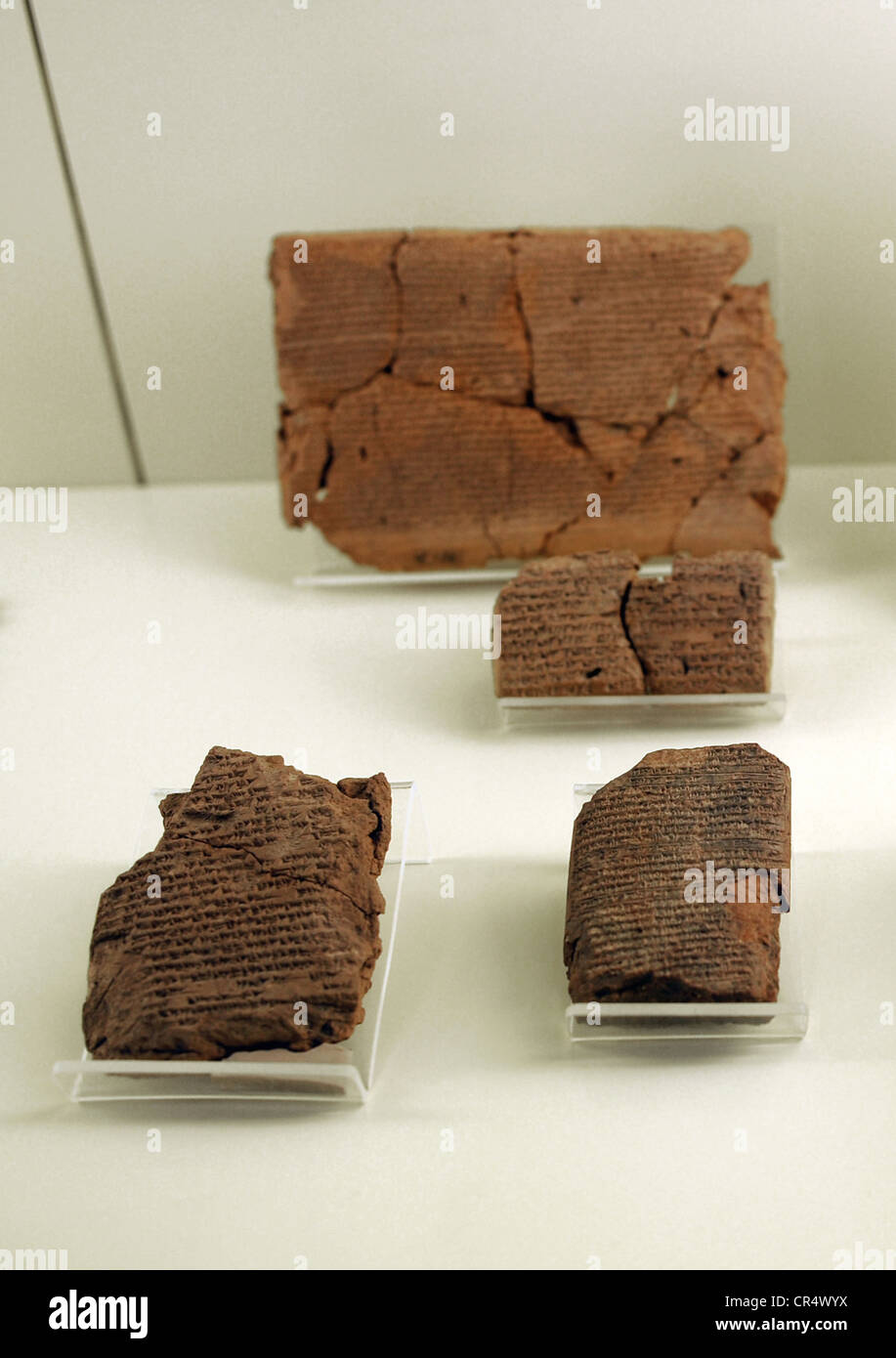 Cuneiform writing. Clay tablets. Pergamon Museum. Berlin. Germany. Stock Photohttps://www.alamy.com/image-license-details/?v=1https://www.alamy.com/stock-photo-cuneiform-writing-clay-tablets-pergamon-museum-berlin-germany-48666014.html
Cuneiform writing. Clay tablets. Pergamon Museum. Berlin. Germany. Stock Photohttps://www.alamy.com/image-license-details/?v=1https://www.alamy.com/stock-photo-cuneiform-writing-clay-tablets-pergamon-museum-berlin-germany-48666014.htmlRMCR4WYX–Cuneiform writing. Clay tablets. Pergamon Museum. Berlin. Germany.
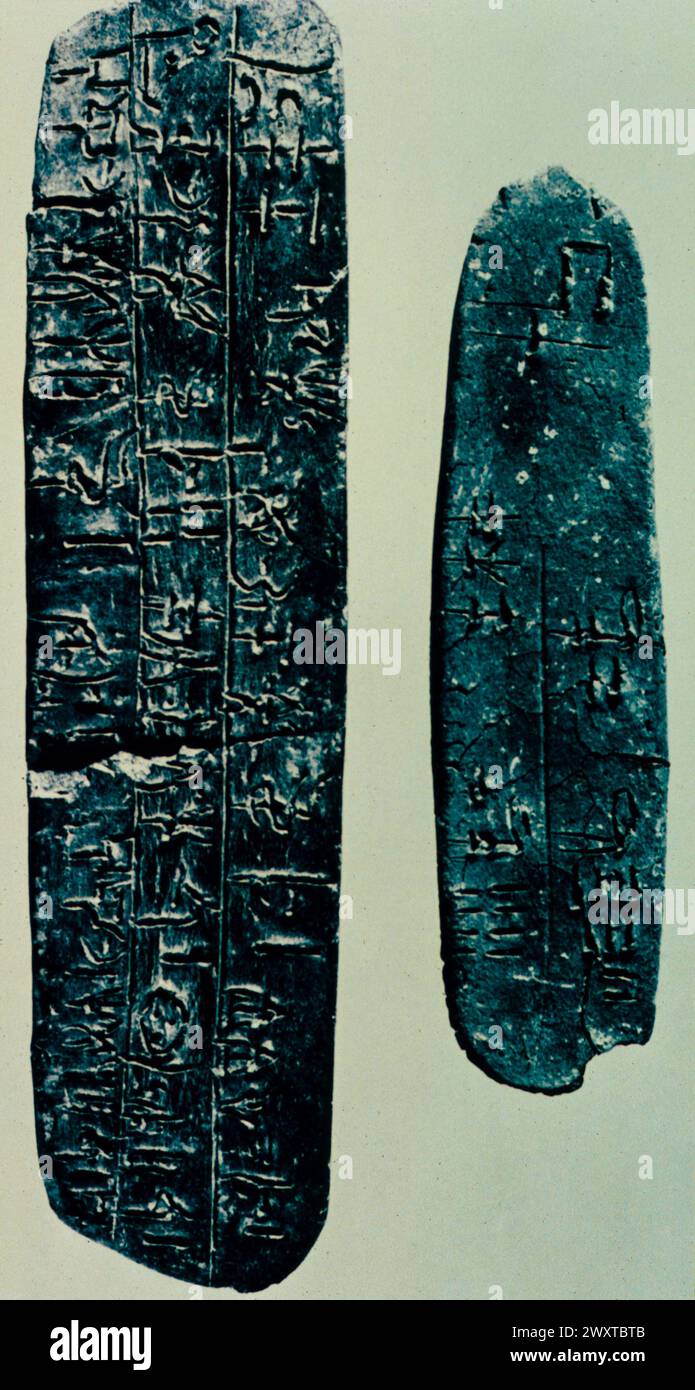 Clay tablets inscribed with Mycenaean script Linear B, Crete, Grece 1400 BC Stock Photohttps://www.alamy.com/image-license-details/?v=1https://www.alamy.com/clay-tablets-inscribed-with-mycenaean-script-linear-b-crete-grece-1400-bc-image601669723.html
Clay tablets inscribed with Mycenaean script Linear B, Crete, Grece 1400 BC Stock Photohttps://www.alamy.com/image-license-details/?v=1https://www.alamy.com/clay-tablets-inscribed-with-mycenaean-script-linear-b-crete-grece-1400-bc-image601669723.htmlRF2WXTBTB–Clay tablets inscribed with Mycenaean script Linear B, Crete, Grece 1400 BC
 Inscribed clay ball, ca. late 1st millennium B.C., Mesopotamia, Clay, 1 3/8 x 4 1/8 in. (3.4 x 10.6 cm), Clay-Tablets-Inscribed Stock Photohttps://www.alamy.com/image-license-details/?v=1https://www.alamy.com/inscribed-clay-ball-ca-late-1st-millennium-bc-mesopotamia-clay-1-38-x-4-18-in-34-x-106-cm-clay-tablets-inscribed-image344667911.html
Inscribed clay ball, ca. late 1st millennium B.C., Mesopotamia, Clay, 1 3/8 x 4 1/8 in. (3.4 x 10.6 cm), Clay-Tablets-Inscribed Stock Photohttps://www.alamy.com/image-license-details/?v=1https://www.alamy.com/inscribed-clay-ball-ca-late-1st-millennium-bc-mesopotamia-clay-1-38-x-4-18-in-34-x-106-cm-clay-tablets-inscribed-image344667911.htmlRM2B0MYC7–Inscribed clay ball, ca. late 1st millennium B.C., Mesopotamia, Clay, 1 3/8 x 4 1/8 in. (3.4 x 10.6 cm), Clay-Tablets-Inscribed
 Art inspired by Cuneiform tablet: number-syllabary, late 1st millennium B.C., Mesopotamia, Clay, 0.43 x 0.98 x 1.02 in. (1.09 x 2.49 x 2.59 cm), Clay-Tablets-Inscribed, Classic works modernized by Artotop with a splash of modernity. Shapes, color and value, eye-catching visual impact on art. Emotions through freedom of artworks in a contemporary way. A timeless message pursuing a wildly creative new direction. Artists turning to the digital medium and creating the Artotop NFT Stock Photohttps://www.alamy.com/image-license-details/?v=1https://www.alamy.com/art-inspired-by-cuneiform-tablet-number-syllabary-late-1st-millennium-bc-mesopotamia-clay-043-x-098-x-102-in-109-x-249-x-259-cm-clay-tablets-inscribed-classic-works-modernized-by-artotop-with-a-splash-of-modernity-shapes-color-and-value-eye-catching-visual-impact-on-art-emotions-through-freedom-of-artworks-in-a-contemporary-way-a-timeless-message-pursuing-a-wildly-creative-new-direction-artists-turning-to-the-digital-medium-and-creating-the-artotop-nft-image462944397.html
Art inspired by Cuneiform tablet: number-syllabary, late 1st millennium B.C., Mesopotamia, Clay, 0.43 x 0.98 x 1.02 in. (1.09 x 2.49 x 2.59 cm), Clay-Tablets-Inscribed, Classic works modernized by Artotop with a splash of modernity. Shapes, color and value, eye-catching visual impact on art. Emotions through freedom of artworks in a contemporary way. A timeless message pursuing a wildly creative new direction. Artists turning to the digital medium and creating the Artotop NFT Stock Photohttps://www.alamy.com/image-license-details/?v=1https://www.alamy.com/art-inspired-by-cuneiform-tablet-number-syllabary-late-1st-millennium-bc-mesopotamia-clay-043-x-098-x-102-in-109-x-249-x-259-cm-clay-tablets-inscribed-classic-works-modernized-by-artotop-with-a-splash-of-modernity-shapes-color-and-value-eye-catching-visual-impact-on-art-emotions-through-freedom-of-artworks-in-a-contemporary-way-a-timeless-message-pursuing-a-wildly-creative-new-direction-artists-turning-to-the-digital-medium-and-creating-the-artotop-nft-image462944397.htmlRF2HW4X8D–Art inspired by Cuneiform tablet: number-syllabary, late 1st millennium B.C., Mesopotamia, Clay, 0.43 x 0.98 x 1.02 in. (1.09 x 2.49 x 2.59 cm), Clay-Tablets-Inscribed, Classic works modernized by Artotop with a splash of modernity. Shapes, color and value, eye-catching visual impact on art. Emotions through freedom of artworks in a contemporary way. A timeless message pursuing a wildly creative new direction. Artists turning to the digital medium and creating the Artotop NFT
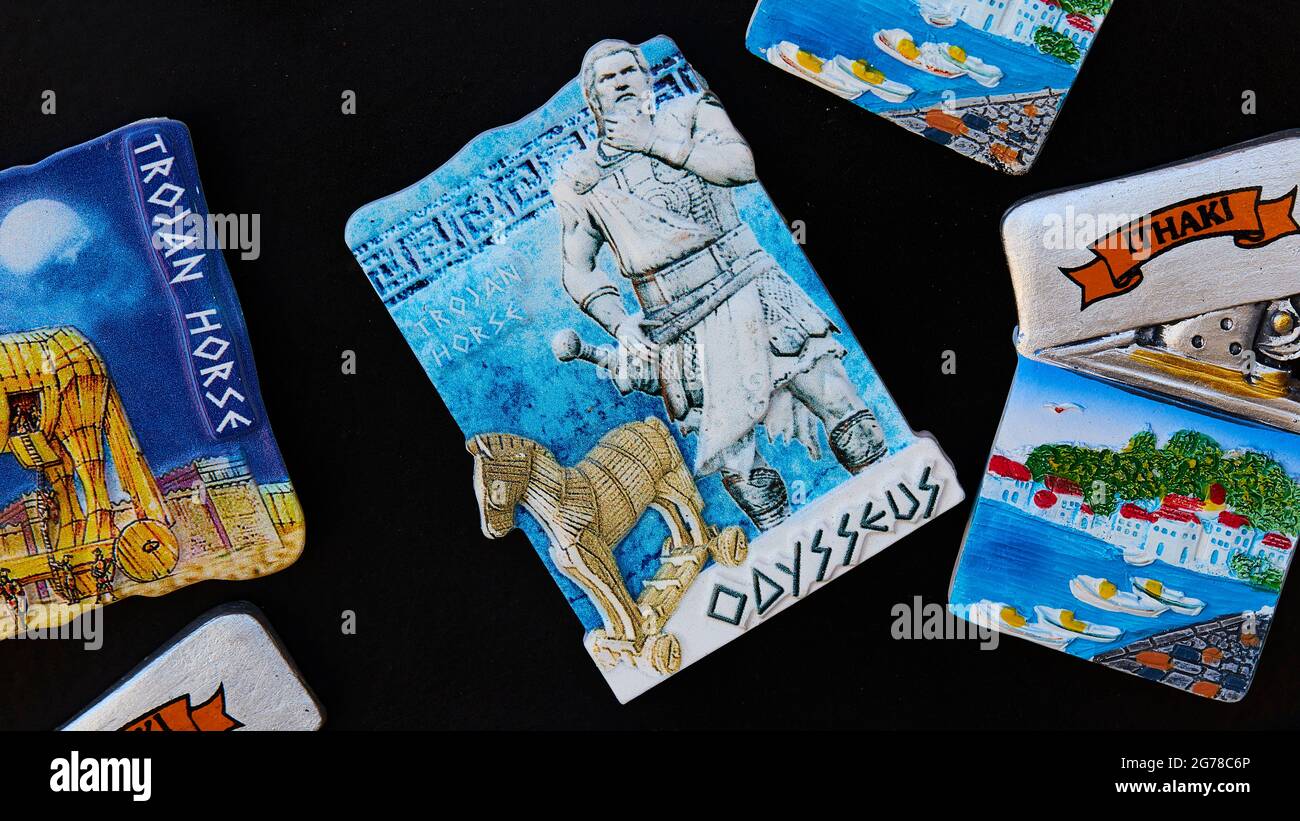 Ionian Islands, Ithaca, island of Odysseus, capital, Vathi, souvenir shop, display, colorful clay tablets, Odysseus as a motif, on a black background Stock Photohttps://www.alamy.com/image-license-details/?v=1https://www.alamy.com/ionian-islands-ithaca-island-of-odysseus-capital-vathi-souvenir-shop-display-colorful-clay-tablets-odysseus-as-a-motif-on-a-black-background-image434747006.html
Ionian Islands, Ithaca, island of Odysseus, capital, Vathi, souvenir shop, display, colorful clay tablets, Odysseus as a motif, on a black background Stock Photohttps://www.alamy.com/image-license-details/?v=1https://www.alamy.com/ionian-islands-ithaca-island-of-odysseus-capital-vathi-souvenir-shop-display-colorful-clay-tablets-odysseus-as-a-motif-on-a-black-background-image434747006.htmlRM2G78C6P–Ionian Islands, Ithaca, island of Odysseus, capital, Vathi, souvenir shop, display, colorful clay tablets, Odysseus as a motif, on a black background
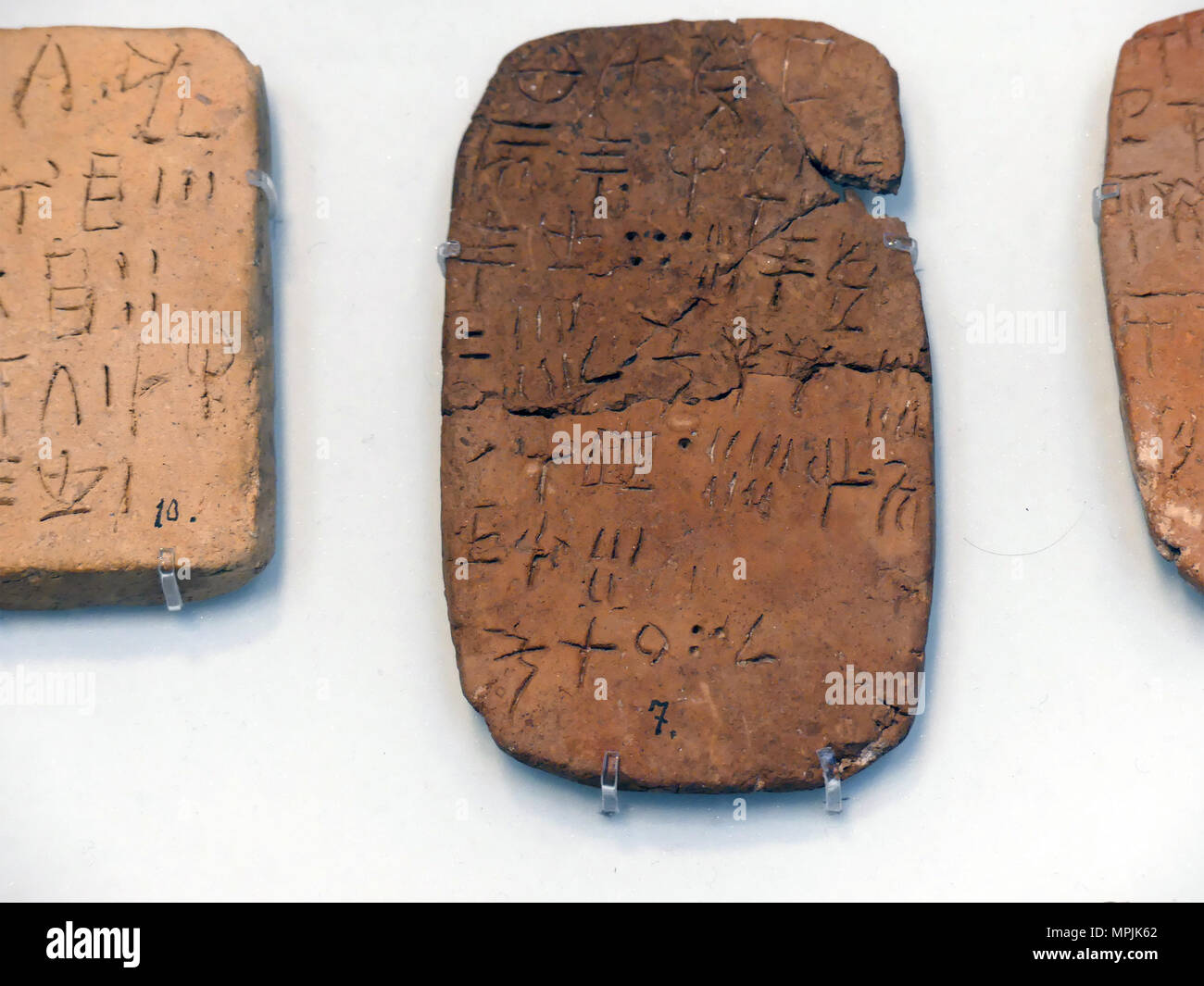 CRETE Clay tablets with Linear B script in Heraklion Museum. Photo: Tony Gale Stock Photohttps://www.alamy.com/image-license-details/?v=1https://www.alamy.com/crete-clay-tablets-with-linear-b-script-in-heraklion-museum-photo-tony-gale-image186036314.html
CRETE Clay tablets with Linear B script in Heraklion Museum. Photo: Tony Gale Stock Photohttps://www.alamy.com/image-license-details/?v=1https://www.alamy.com/crete-clay-tablets-with-linear-b-script-in-heraklion-museum-photo-tony-gale-image186036314.htmlRMMPJK62–CRETE Clay tablets with Linear B script in Heraklion Museum. Photo: Tony Gale
 Local Tibetans making clay offering tablets at a Buddhist temple. Sichuan, China. Stock Photohttps://www.alamy.com/image-license-details/?v=1https://www.alamy.com/stock-photo-local-tibetans-making-clay-offering-tablets-at-a-buddhist-temple-sichuan-38395308.html
Local Tibetans making clay offering tablets at a Buddhist temple. Sichuan, China. Stock Photohttps://www.alamy.com/image-license-details/?v=1https://www.alamy.com/stock-photo-local-tibetans-making-clay-offering-tablets-at-a-buddhist-temple-sichuan-38395308.htmlRMC6D1H0–Local Tibetans making clay offering tablets at a Buddhist temple. Sichuan, China.
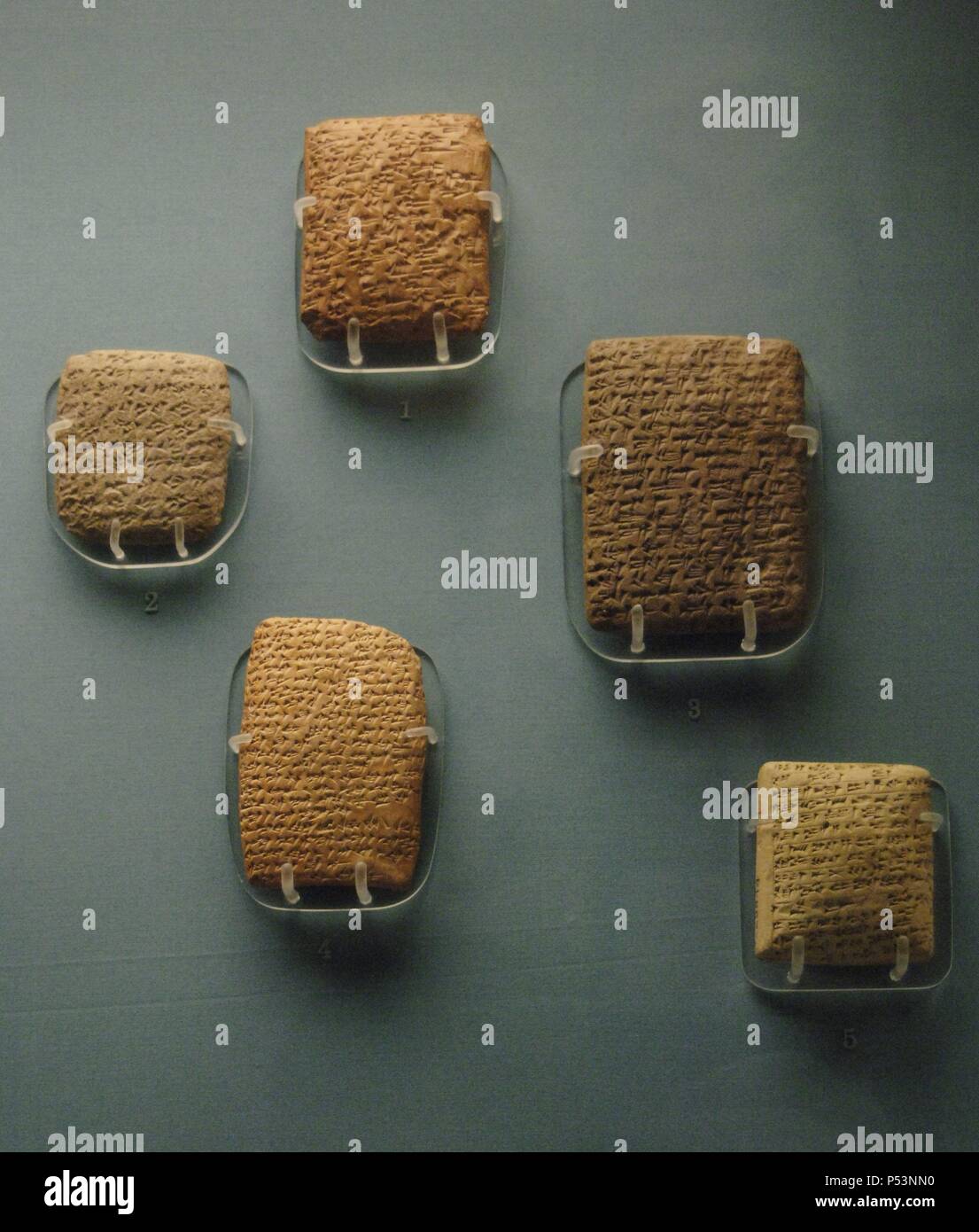 Amarna Letters. 14th century BC. Clay tablets with cuneiform script, mostly written in Akkadian. Designate a file of correspondence, mostly diplomatic, between the Egyptian administration and its representatives in Canaan and Amurru. 1350-1330 BC. From Amarna (Upper Egypt). British Museum. London. United Kingdom. Stock Photohttps://www.alamy.com/image-license-details/?v=1https://www.alamy.com/amarna-letters-14th-century-bc-clay-tablets-with-cuneiform-script-mostly-written-in-akkadian-designate-a-file-of-correspondence-mostly-diplomatic-between-the-egyptian-administration-and-its-representatives-in-canaan-and-amurru-1350-1330-bc-from-amarna-upper-egypt-british-museum-london-united-kingdom-image209680604.html
Amarna Letters. 14th century BC. Clay tablets with cuneiform script, mostly written in Akkadian. Designate a file of correspondence, mostly diplomatic, between the Egyptian administration and its representatives in Canaan and Amurru. 1350-1330 BC. From Amarna (Upper Egypt). British Museum. London. United Kingdom. Stock Photohttps://www.alamy.com/image-license-details/?v=1https://www.alamy.com/amarna-letters-14th-century-bc-clay-tablets-with-cuneiform-script-mostly-written-in-akkadian-designate-a-file-of-correspondence-mostly-diplomatic-between-the-egyptian-administration-and-its-representatives-in-canaan-and-amurru-1350-1330-bc-from-amarna-upper-egypt-british-museum-london-united-kingdom-image209680604.htmlRMP53NN0–Amarna Letters. 14th century BC. Clay tablets with cuneiform script, mostly written in Akkadian. Designate a file of correspondence, mostly diplomatic, between the Egyptian administration and its representatives in Canaan and Amurru. 1350-1330 BC. From Amarna (Upper Egypt). British Museum. London. United Kingdom.
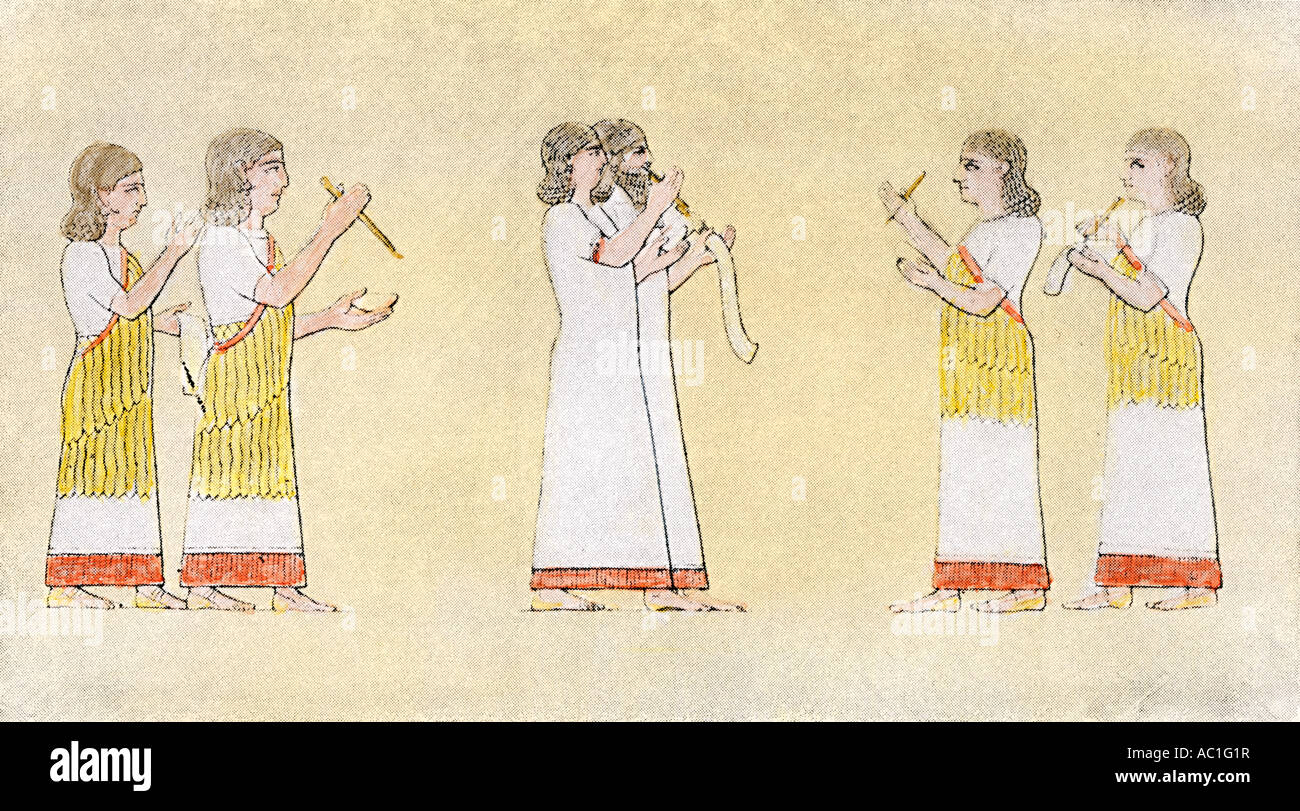 Assyrian or Babylonian scribes using flexible media as well as clay tablets for cuneiform writing. Hand-colored halftone of an illustration Stock Photohttps://www.alamy.com/image-license-details/?v=1https://www.alamy.com/stock-photo-assyrian-or-babylonian-scribes-using-flexible-media-as-well-as-clay-13010386.html
Assyrian or Babylonian scribes using flexible media as well as clay tablets for cuneiform writing. Hand-colored halftone of an illustration Stock Photohttps://www.alamy.com/image-license-details/?v=1https://www.alamy.com/stock-photo-assyrian-or-babylonian-scribes-using-flexible-media-as-well-as-clay-13010386.htmlRMAC1G1R–Assyrian or Babylonian scribes using flexible media as well as clay tablets for cuneiform writing. Hand-colored halftone of an illustration
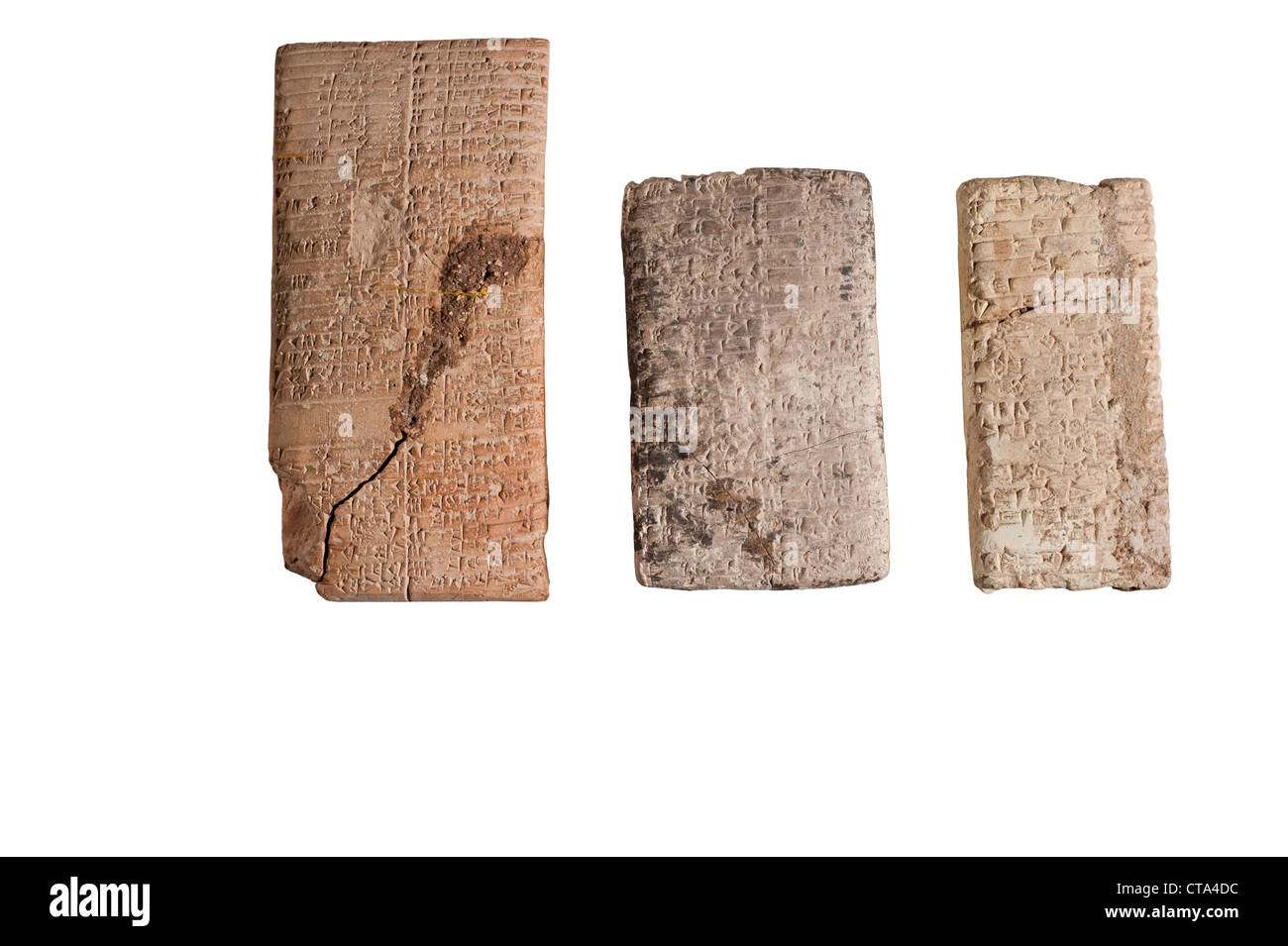 3 Cuneiform clay tablets with economic text circa 2000 BCE Stock Photohttps://www.alamy.com/image-license-details/?v=1https://www.alamy.com/stock-photo-3-cuneiform-clay-tablets-with-economic-text-circa-2000-bce-49395512.html
3 Cuneiform clay tablets with economic text circa 2000 BCE Stock Photohttps://www.alamy.com/image-license-details/?v=1https://www.alamy.com/stock-photo-3-cuneiform-clay-tablets-with-economic-text-circa-2000-bce-49395512.htmlRMCTA4DC–3 Cuneiform clay tablets with economic text circa 2000 BCE
 Clay tablets with names of Jews from Weilburg, 1918 to 1945, Weilburg an der Lahn, Hesse, Germany, Europe Stock Photohttps://www.alamy.com/image-license-details/?v=1https://www.alamy.com/stock-photo-clay-tablets-with-names-of-jews-from-weilburg-1918-to-1945-weilburg-57033304.html
Clay tablets with names of Jews from Weilburg, 1918 to 1945, Weilburg an der Lahn, Hesse, Germany, Europe Stock Photohttps://www.alamy.com/image-license-details/?v=1https://www.alamy.com/stock-photo-clay-tablets-with-names-of-jews-from-weilburg-1918-to-1945-weilburg-57033304.htmlRMD8P2FM–Clay tablets with names of Jews from Weilburg, 1918 to 1945, Weilburg an der Lahn, Hesse, Germany, Europe
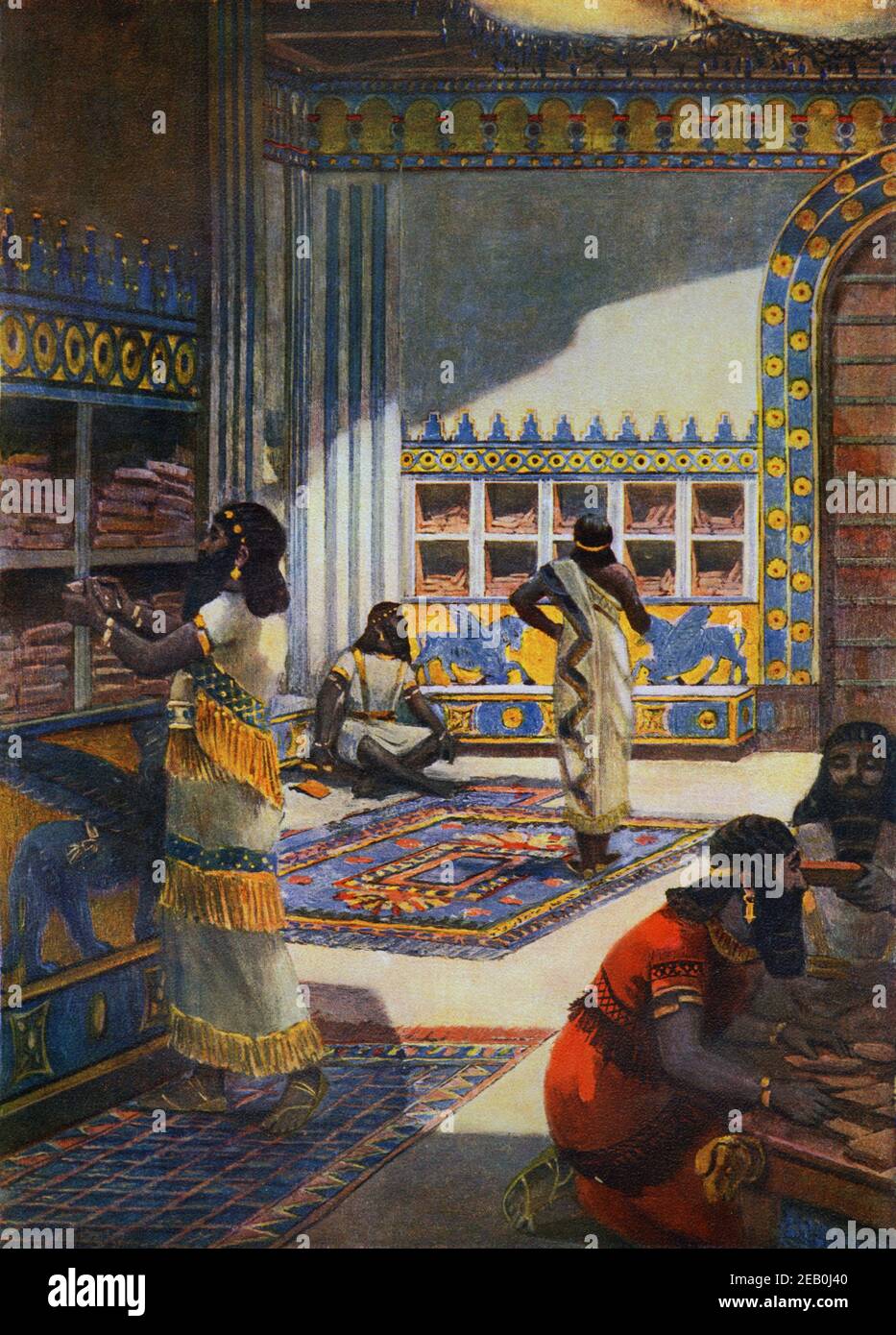 Vintage illustration circa 1914 depicting the royal library of King Ashurbanipal at Nineveh the first systematically organized library in the world with over 30,000 clay tablets painted by Fernand Le Quesne Stock Photohttps://www.alamy.com/image-license-details/?v=1https://www.alamy.com/vintage-illustration-circa-1914-depicting-the-royal-library-of-king-ashurbanipal-at-nineveh-the-first-systematically-organized-library-in-the-world-with-over-30000-clay-tablets-painted-by-fernand-le-quesne-image402613904.html
Vintage illustration circa 1914 depicting the royal library of King Ashurbanipal at Nineveh the first systematically organized library in the world with over 30,000 clay tablets painted by Fernand Le Quesne Stock Photohttps://www.alamy.com/image-license-details/?v=1https://www.alamy.com/vintage-illustration-circa-1914-depicting-the-royal-library-of-king-ashurbanipal-at-nineveh-the-first-systematically-organized-library-in-the-world-with-over-30000-clay-tablets-painted-by-fernand-le-quesne-image402613904.htmlRM2EB0J40–Vintage illustration circa 1914 depicting the royal library of King Ashurbanipal at Nineveh the first systematically organized library in the world with over 30,000 clay tablets painted by Fernand Le Quesne
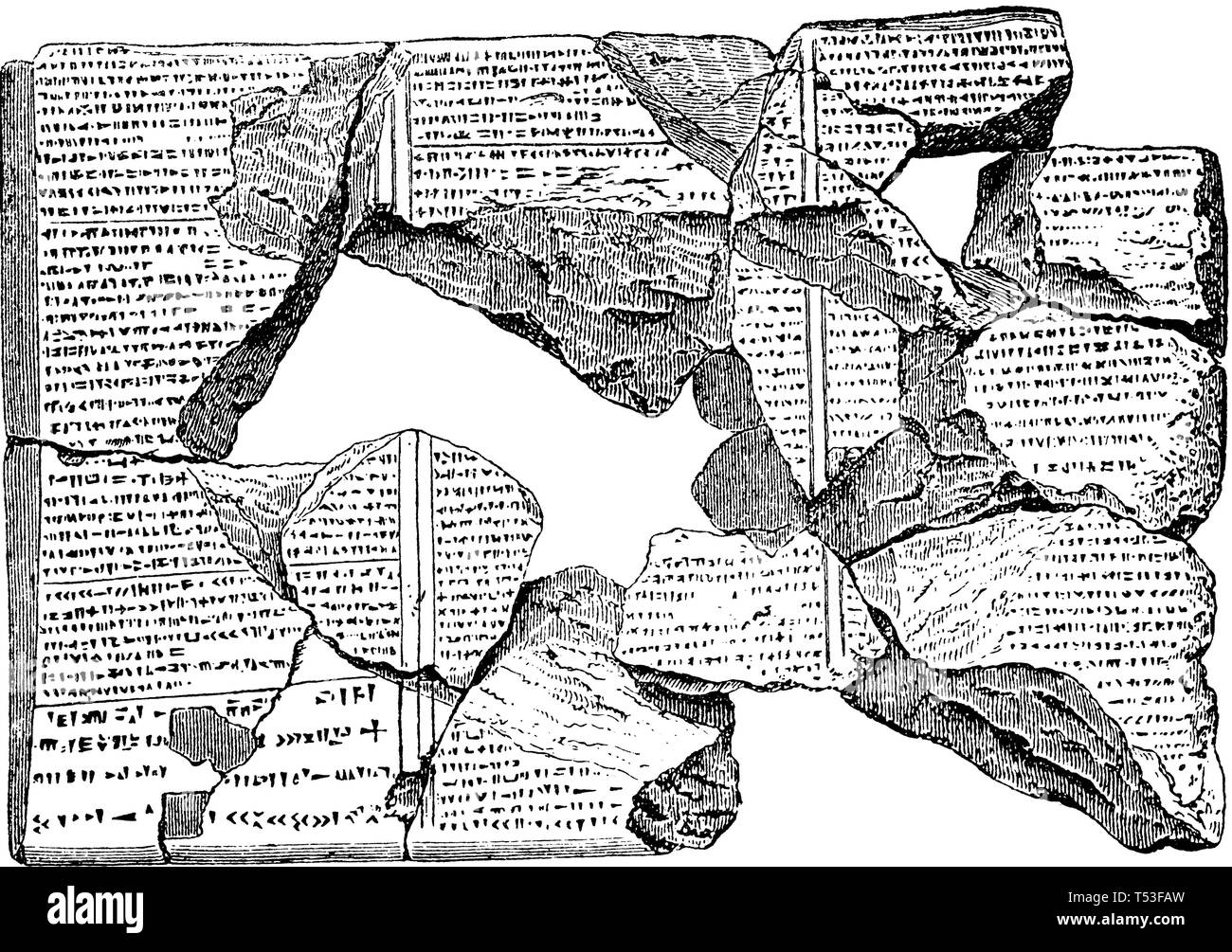 Clay tablets with the Flood Story. After Delitzsch (In the lower left corner the library brand Assurbanipals.), Stock Photohttps://www.alamy.com/image-license-details/?v=1https://www.alamy.com/clay-tablets-with-the-flood-story-after-delitzsch-in-the-lower-left-corner-the-library-brand-assurbanipals-image244096353.html
Clay tablets with the Flood Story. After Delitzsch (In the lower left corner the library brand Assurbanipals.), Stock Photohttps://www.alamy.com/image-license-details/?v=1https://www.alamy.com/clay-tablets-with-the-flood-story-after-delitzsch-in-the-lower-left-corner-the-library-brand-assurbanipals-image244096353.htmlRMT53FAW–Clay tablets with the Flood Story. After Delitzsch (In the lower left corner the library brand Assurbanipals.),
 Edinburgh, Scotland, UK; 15 August, 2018. Pictured; Irving Finkel. Finkel is an expert reader of cuneiform inscriptions on clay tablets and a British Museum scholar. His book, 'The Writing in the Stone', is a work of bloodcurdling fiction set in Mesopotamia and inspired by a fractured piece of stone that resembles a cuneiform stone. Credit: Iain Masterton/Alamy Live News Stock Photohttps://www.alamy.com/image-license-details/?v=1https://www.alamy.com/edinburgh-scotland-uk-15-august-2018-pictured-irving-finkel-finkel-is-an-expert-reader-of-cuneiform-inscriptions-on-clay-tablets-and-a-british-museum-scholar-his-book-the-writing-in-the-stone-is-a-work-of-bloodcurdling-fiction-set-in-mesopotamia-and-inspired-by-a-fractured-piece-of-stone-that-resembles-a-cuneiform-stone-credit-iain-mastertonalamy-live-news-image215506555.html
Edinburgh, Scotland, UK; 15 August, 2018. Pictured; Irving Finkel. Finkel is an expert reader of cuneiform inscriptions on clay tablets and a British Museum scholar. His book, 'The Writing in the Stone', is a work of bloodcurdling fiction set in Mesopotamia and inspired by a fractured piece of stone that resembles a cuneiform stone. Credit: Iain Masterton/Alamy Live News Stock Photohttps://www.alamy.com/image-license-details/?v=1https://www.alamy.com/edinburgh-scotland-uk-15-august-2018-pictured-irving-finkel-finkel-is-an-expert-reader-of-cuneiform-inscriptions-on-clay-tablets-and-a-british-museum-scholar-his-book-the-writing-in-the-stone-is-a-work-of-bloodcurdling-fiction-set-in-mesopotamia-and-inspired-by-a-fractured-piece-of-stone-that-resembles-a-cuneiform-stone-credit-iain-mastertonalamy-live-news-image215506555.htmlRMPEH4PK–Edinburgh, Scotland, UK; 15 August, 2018. Pictured; Irving Finkel. Finkel is an expert reader of cuneiform inscriptions on clay tablets and a British Museum scholar. His book, 'The Writing in the Stone', is a work of bloodcurdling fiction set in Mesopotamia and inspired by a fractured piece of stone that resembles a cuneiform stone. Credit: Iain Masterton/Alamy Live News
 Tehran, Iran. 18th May, 2024. People watch ancient clay tablets at National Museum of Iran in Tehran, Iran, May 18, 2024. Iran on Saturday unveiled a selection of ancient clay tablets brought back to the country last year from the United States.TO GO WITH 'Iran unveils selection of ancient clay tablets returned from U.S.' Credit: Shadati/Xinhua/Alamy Live News Stock Photohttps://www.alamy.com/image-license-details/?v=1https://www.alamy.com/tehran-iran-18th-may-2024-people-watch-ancient-clay-tablets-at-national-museum-of-iran-in-tehran-iran-may-18-2024-iran-on-saturday-unveiled-a-selection-of-ancient-clay-tablets-brought-back-to-the-country-last-year-from-the-united-statesto-go-with-iran-unveils-selection-of-ancient-clay-tablets-returned-from-us-credit-shadatixinhuaalamy-live-news-image606887449.html
Tehran, Iran. 18th May, 2024. People watch ancient clay tablets at National Museum of Iran in Tehran, Iran, May 18, 2024. Iran on Saturday unveiled a selection of ancient clay tablets brought back to the country last year from the United States.TO GO WITH 'Iran unveils selection of ancient clay tablets returned from U.S.' Credit: Shadati/Xinhua/Alamy Live News Stock Photohttps://www.alamy.com/image-license-details/?v=1https://www.alamy.com/tehran-iran-18th-may-2024-people-watch-ancient-clay-tablets-at-national-museum-of-iran-in-tehran-iran-may-18-2024-iran-on-saturday-unveiled-a-selection-of-ancient-clay-tablets-brought-back-to-the-country-last-year-from-the-united-statesto-go-with-iran-unveils-selection-of-ancient-clay-tablets-returned-from-us-credit-shadatixinhuaalamy-live-news-image606887449.htmlRM2X7A33N–Tehran, Iran. 18th May, 2024. People watch ancient clay tablets at National Museum of Iran in Tehran, Iran, May 18, 2024. Iran on Saturday unveiled a selection of ancient clay tablets brought back to the country last year from the United States.TO GO WITH 'Iran unveils selection of ancient clay tablets returned from U.S.' Credit: Shadati/Xinhua/Alamy Live News
 7457. Oldest Alphabet Discovered in a tomb in the city of Umm el-Marra, Syria. Clay tablets engraved with symbols that may be part of the earliest kno Stock Photohttps://www.alamy.com/image-license-details/?v=1https://www.alamy.com/7457-oldest-alphabet-discovered-in-a-tomb-in-the-city-of-umm-el-marra-syria-clay-tablets-engraved-with-symbols-that-may-be-part-of-the-earliest-kno-image632862189.html
7457. Oldest Alphabet Discovered in a tomb in the city of Umm el-Marra, Syria. Clay tablets engraved with symbols that may be part of the earliest kno Stock Photohttps://www.alamy.com/image-license-details/?v=1https://www.alamy.com/7457-oldest-alphabet-discovered-in-a-tomb-in-the-city-of-umm-el-marra-syria-clay-tablets-engraved-with-symbols-that-may-be-part-of-the-earliest-kno-image632862189.htmlRF2YNHA51–7457. Oldest Alphabet Discovered in a tomb in the city of Umm el-Marra, Syria. Clay tablets engraved with symbols that may be part of the earliest kno
 Clay tablets with celestial animals, Mawangdui Han Tomb, Hunan Provincial Museum, Changsa, Hunan Province, China Stock Photohttps://www.alamy.com/image-license-details/?v=1https://www.alamy.com/stock-photo-clay-tablets-with-celestial-animals-mawangdui-han-tomb-hunan-provincial-25085476.html
Clay tablets with celestial animals, Mawangdui Han Tomb, Hunan Provincial Museum, Changsa, Hunan Province, China Stock Photohttps://www.alamy.com/image-license-details/?v=1https://www.alamy.com/stock-photo-clay-tablets-with-celestial-animals-mawangdui-han-tomb-hunan-provincial-25085476.htmlRMBCPMNT–Clay tablets with celestial animals, Mawangdui Han Tomb, Hunan Provincial Museum, Changsa, Hunan Province, China
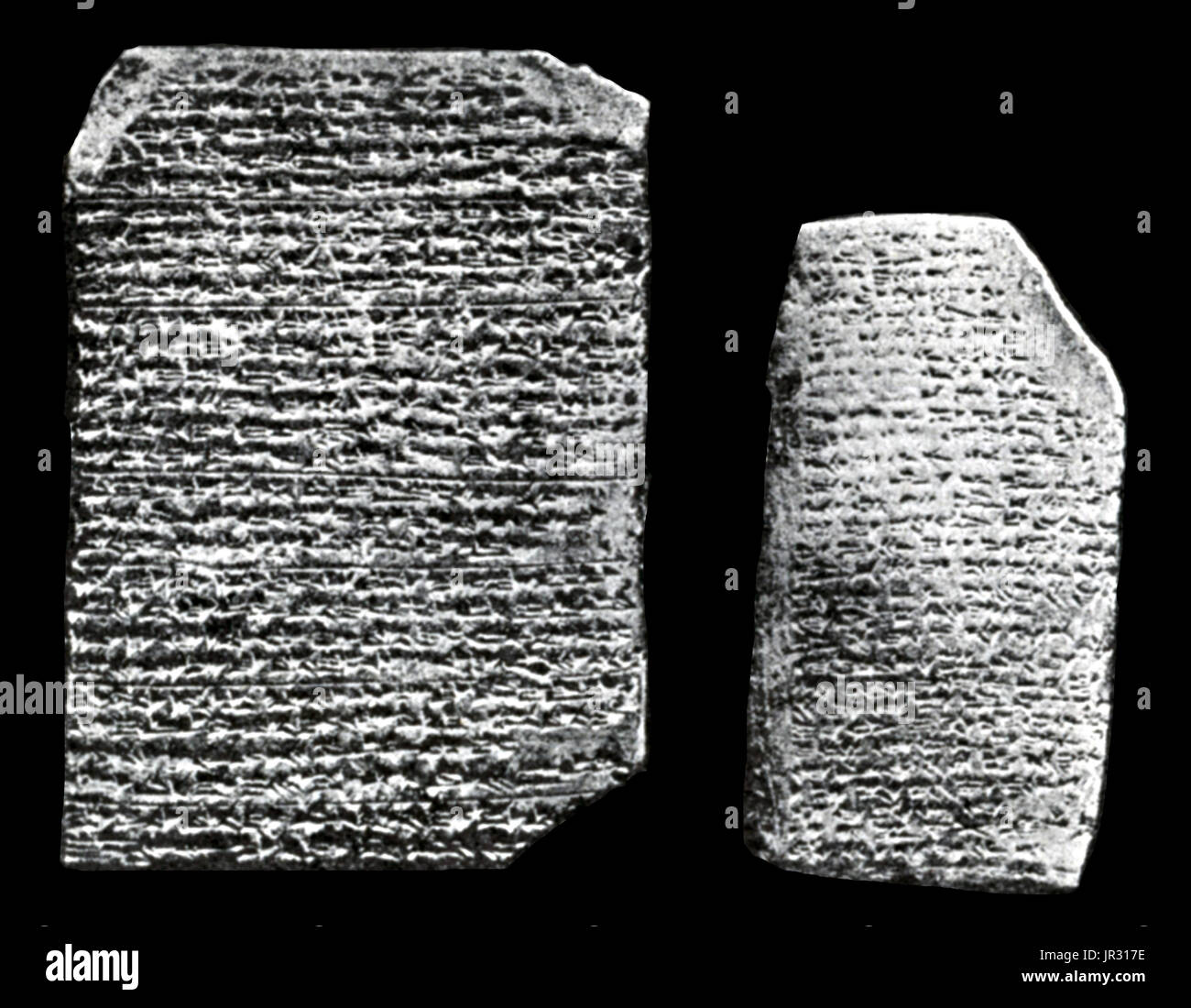 The Amarna tablets are an archive, written on clay tablets, primarily consisting of diplomatic correspondence between the Egyptian administration and its representatives in Canaan and Amurru during the New Kingdom. The Amarna letters are unusual in Egyptological research, because they are mostly written in Akkadian cuneiform, the writing system of ancient Mesopotamia, rather than that of ancient Egypt. The written correspondence spans a period of at most thirty years. The Amarna letters are of great significance for biblical studies as well as Semitic linguistics, since they shed light on the Stock Photohttps://www.alamy.com/image-license-details/?v=1https://www.alamy.com/the-amarna-tablets-are-an-archive-written-on-clay-tablets-primarily-image151886882.html
The Amarna tablets are an archive, written on clay tablets, primarily consisting of diplomatic correspondence between the Egyptian administration and its representatives in Canaan and Amurru during the New Kingdom. The Amarna letters are unusual in Egyptological research, because they are mostly written in Akkadian cuneiform, the writing system of ancient Mesopotamia, rather than that of ancient Egypt. The written correspondence spans a period of at most thirty years. The Amarna letters are of great significance for biblical studies as well as Semitic linguistics, since they shed light on the Stock Photohttps://www.alamy.com/image-license-details/?v=1https://www.alamy.com/the-amarna-tablets-are-an-archive-written-on-clay-tablets-primarily-image151886882.htmlRMJR317E–The Amarna tablets are an archive, written on clay tablets, primarily consisting of diplomatic correspondence between the Egyptian administration and its representatives in Canaan and Amurru during the New Kingdom. The Amarna letters are unusual in Egyptological research, because they are mostly written in Akkadian cuneiform, the writing system of ancient Mesopotamia, rather than that of ancient Egypt. The written correspondence spans a period of at most thirty years. The Amarna letters are of great significance for biblical studies as well as Semitic linguistics, since they shed light on the
 Administrative seal in the form of cuneiform clay tablets. From Mesopotamia 3100-2900 BC Stock Photohttps://www.alamy.com/image-license-details/?v=1https://www.alamy.com/stock-photo-administrative-seal-in-the-form-of-cuneiform-clay-tablets-from-mesopotamia-57351838.html
Administrative seal in the form of cuneiform clay tablets. From Mesopotamia 3100-2900 BC Stock Photohttps://www.alamy.com/image-license-details/?v=1https://www.alamy.com/stock-photo-administrative-seal-in-the-form-of-cuneiform-clay-tablets-from-mesopotamia-57351838.htmlRMD98GRX–Administrative seal in the form of cuneiform clay tablets. From Mesopotamia 3100-2900 BC
 Amarna Letters. 14th century BC. Clay tablets with cuneiform script, mostly written in Akkadian. From Amarna (Upper Egypt). Stock Photohttps://www.alamy.com/image-license-details/?v=1https://www.alamy.com/stock-photo-amarna-letters-14th-century-bc-clay-tablets-with-cuneiform-script-48030748.html
Amarna Letters. 14th century BC. Clay tablets with cuneiform script, mostly written in Akkadian. From Amarna (Upper Egypt). Stock Photohttps://www.alamy.com/image-license-details/?v=1https://www.alamy.com/stock-photo-amarna-letters-14th-century-bc-clay-tablets-with-cuneiform-script-48030748.htmlRMCP3YKT–Amarna Letters. 14th century BC. Clay tablets with cuneiform script, mostly written in Akkadian. From Amarna (Upper Egypt).
 Egyptian clay tablets with hieroglyphs. Stock Photohttps://www.alamy.com/image-license-details/?v=1https://www.alamy.com/egyptian-clay-tablets-with-hieroglyphs-image6719642.html
Egyptian clay tablets with hieroglyphs. Stock Photohttps://www.alamy.com/image-license-details/?v=1https://www.alamy.com/egyptian-clay-tablets-with-hieroglyphs-image6719642.htmlRMA78GWB–Egyptian clay tablets with hieroglyphs.
 Cuneiform tablet: fragment of the Weidner God List, ca. late 1st millennium B.C., Mesopotamia, Clay, 2.12 x 2.75 in. (5.38 x 6.99 cm), Clay-Tablets-Inscribed Stock Photohttps://www.alamy.com/image-license-details/?v=1https://www.alamy.com/cuneiform-tablet-fragment-of-the-weidner-god-list-ca-late-1st-millennium-bc-mesopotamia-clay-212-x-275-in-538-x-699-cm-clay-tablets-inscribed-image344638277.html
Cuneiform tablet: fragment of the Weidner God List, ca. late 1st millennium B.C., Mesopotamia, Clay, 2.12 x 2.75 in. (5.38 x 6.99 cm), Clay-Tablets-Inscribed Stock Photohttps://www.alamy.com/image-license-details/?v=1https://www.alamy.com/cuneiform-tablet-fragment-of-the-weidner-god-list-ca-late-1st-millennium-bc-mesopotamia-clay-212-x-275-in-538-x-699-cm-clay-tablets-inscribed-image344638277.htmlRM2B0KHHW–Cuneiform tablet: fragment of the Weidner God List, ca. late 1st millennium B.C., Mesopotamia, Clay, 2.12 x 2.75 in. (5.38 x 6.99 cm), Clay-Tablets-Inscribed
 Art inspired by Cuneiform tablet: unidentified fragment, ca. late 1st millennium B.C., Mesopotamia, Clay, 1 x 5/8 x 3/8 in. (2.4 x 1.6 x 1.1 cm), Clay-Tablets-Inscribed, Classic works modernized by Artotop with a splash of modernity. Shapes, color and value, eye-catching visual impact on art. Emotions through freedom of artworks in a contemporary way. A timeless message pursuing a wildly creative new direction. Artists turning to the digital medium and creating the Artotop NFT Stock Photohttps://www.alamy.com/image-license-details/?v=1https://www.alamy.com/art-inspired-by-cuneiform-tablet-unidentified-fragment-ca-late-1st-millennium-bc-mesopotamia-clay-1-x-58-x-38-in-24-x-16-x-11-cm-clay-tablets-inscribed-classic-works-modernized-by-artotop-with-a-splash-of-modernity-shapes-color-and-value-eye-catching-visual-impact-on-art-emotions-through-freedom-of-artworks-in-a-contemporary-way-a-timeless-message-pursuing-a-wildly-creative-new-direction-artists-turning-to-the-digital-medium-and-creating-the-artotop-nft-image462945260.html
Art inspired by Cuneiform tablet: unidentified fragment, ca. late 1st millennium B.C., Mesopotamia, Clay, 1 x 5/8 x 3/8 in. (2.4 x 1.6 x 1.1 cm), Clay-Tablets-Inscribed, Classic works modernized by Artotop with a splash of modernity. Shapes, color and value, eye-catching visual impact on art. Emotions through freedom of artworks in a contemporary way. A timeless message pursuing a wildly creative new direction. Artists turning to the digital medium and creating the Artotop NFT Stock Photohttps://www.alamy.com/image-license-details/?v=1https://www.alamy.com/art-inspired-by-cuneiform-tablet-unidentified-fragment-ca-late-1st-millennium-bc-mesopotamia-clay-1-x-58-x-38-in-24-x-16-x-11-cm-clay-tablets-inscribed-classic-works-modernized-by-artotop-with-a-splash-of-modernity-shapes-color-and-value-eye-catching-visual-impact-on-art-emotions-through-freedom-of-artworks-in-a-contemporary-way-a-timeless-message-pursuing-a-wildly-creative-new-direction-artists-turning-to-the-digital-medium-and-creating-the-artotop-nft-image462945260.htmlRF2HW4YB8–Art inspired by Cuneiform tablet: unidentified fragment, ca. late 1st millennium B.C., Mesopotamia, Clay, 1 x 5/8 x 3/8 in. (2.4 x 1.6 x 1.1 cm), Clay-Tablets-Inscribed, Classic works modernized by Artotop with a splash of modernity. Shapes, color and value, eye-catching visual impact on art. Emotions through freedom of artworks in a contemporary way. A timeless message pursuing a wildly creative new direction. Artists turning to the digital medium and creating the Artotop NFT
 Hittite cuneiform tablet. Adana Archaeology Museum, Turkey. Against a white background Stock Photohttps://www.alamy.com/image-license-details/?v=1https://www.alamy.com/hittite-cuneiform-tablet-adana-archaeology-museum-turkey-against-a-white-background-image241713650.html
Hittite cuneiform tablet. Adana Archaeology Museum, Turkey. Against a white background Stock Photohttps://www.alamy.com/image-license-details/?v=1https://www.alamy.com/hittite-cuneiform-tablet-adana-archaeology-museum-turkey-against-a-white-background-image241713650.htmlRFT1706A–Hittite cuneiform tablet. Adana Archaeology Museum, Turkey. Against a white background
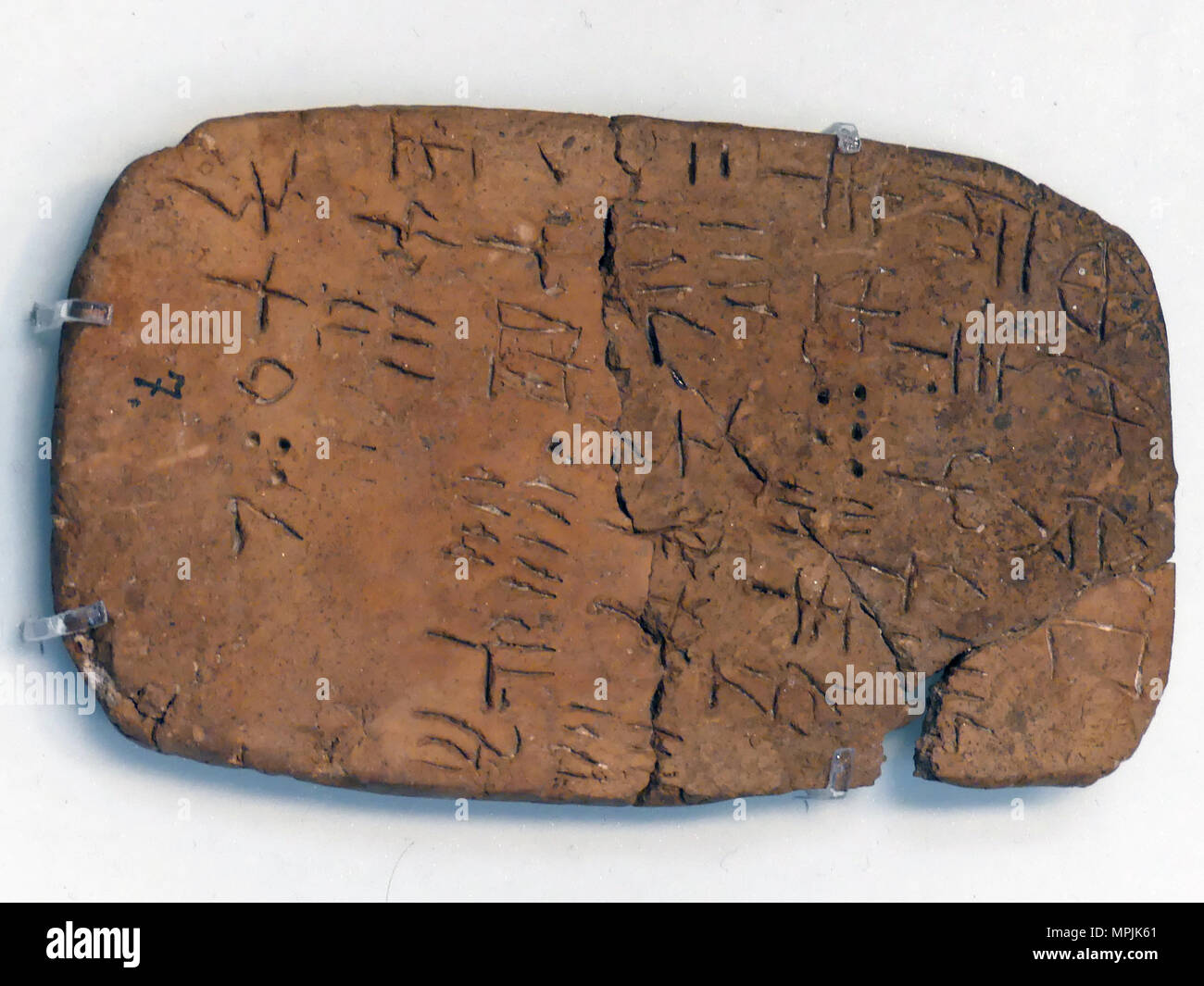 CRETE Clay tablets with Linear B script in Heraklion Museum. Photo: Tony Gale Stock Photohttps://www.alamy.com/image-license-details/?v=1https://www.alamy.com/crete-clay-tablets-with-linear-b-script-in-heraklion-museum-photo-tony-gale-image186036313.html
CRETE Clay tablets with Linear B script in Heraklion Museum. Photo: Tony Gale Stock Photohttps://www.alamy.com/image-license-details/?v=1https://www.alamy.com/crete-clay-tablets-with-linear-b-script-in-heraklion-museum-photo-tony-gale-image186036313.htmlRMMPJK61–CRETE Clay tablets with Linear B script in Heraklion Museum. Photo: Tony Gale
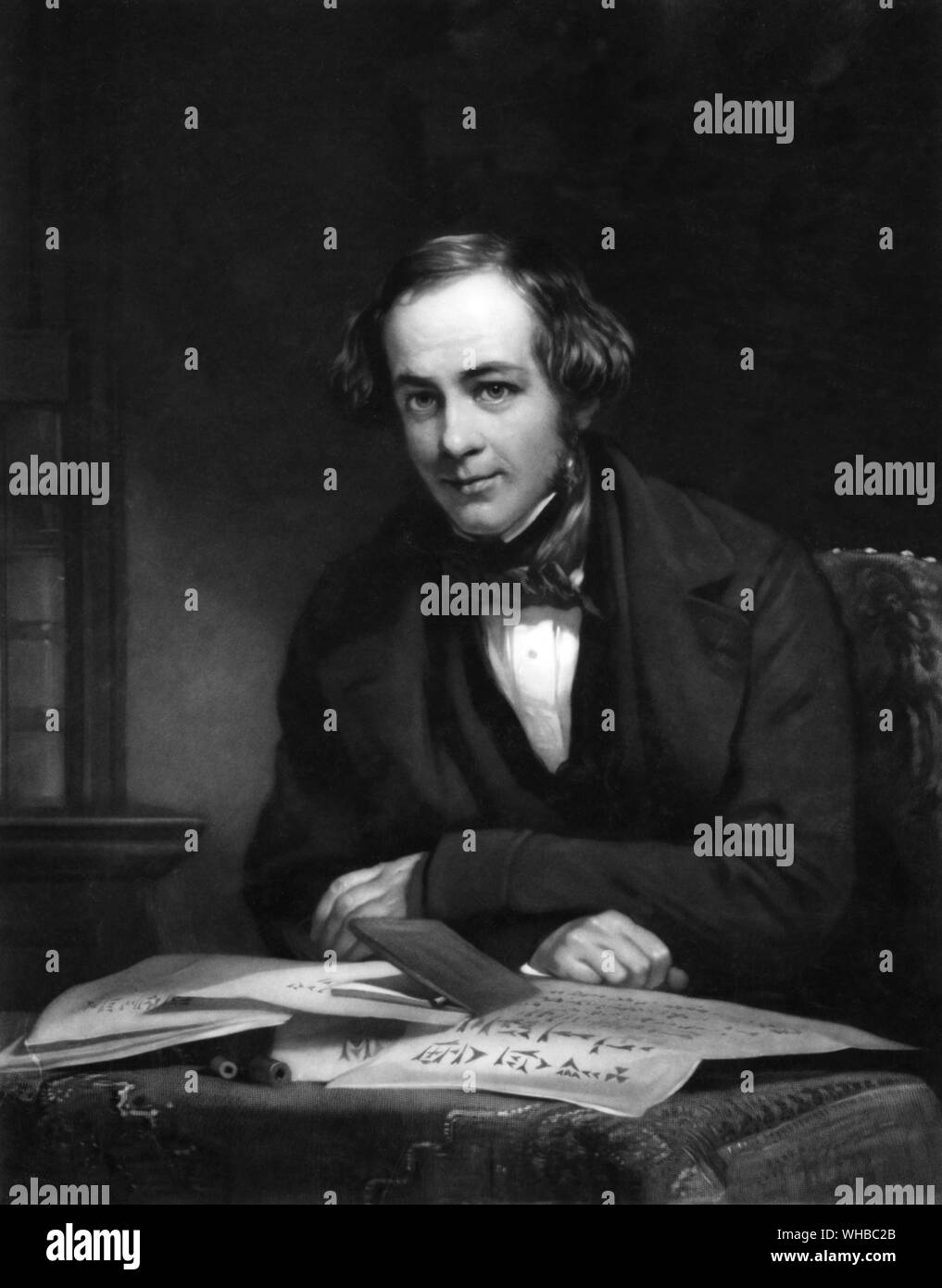 Major General Sir H. C. Rawling KCB -. Henry Creswicke Rawling - a British army officer and Orientalist who deciphered the Old Persian portion of the trilingual cuneiform inscription of Darius I the Great at Bisitun, Iran. Cuneiform is the same writing system, which was used on the clay, tablets and inscriptions used by the ancient inhabitants of Mesopotamia. His success provided the key to the deciphering, by himself and others, of Mesopotamian cuneiform script.. Stock Photohttps://www.alamy.com/image-license-details/?v=1https://www.alamy.com/major-general-sir-h-c-rawling-kcb-henry-creswicke-rawling-a-british-army-officer-and-orientalist-who-deciphered-the-old-persian-portion-of-the-trilingual-cuneiform-inscription-of-darius-i-the-great-at-bisitun-iran-cuneiform-is-the-same-writing-system-which-was-used-on-the-clay-tablets-and-inscriptions-used-by-the-ancient-inhabitants-of-mesopotamia-his-success-provided-the-key-to-the-deciphering-by-himself-and-others-of-mesopotamian-cuneiform-script-image268855619.html
Major General Sir H. C. Rawling KCB -. Henry Creswicke Rawling - a British army officer and Orientalist who deciphered the Old Persian portion of the trilingual cuneiform inscription of Darius I the Great at Bisitun, Iran. Cuneiform is the same writing system, which was used on the clay, tablets and inscriptions used by the ancient inhabitants of Mesopotamia. His success provided the key to the deciphering, by himself and others, of Mesopotamian cuneiform script.. Stock Photohttps://www.alamy.com/image-license-details/?v=1https://www.alamy.com/major-general-sir-h-c-rawling-kcb-henry-creswicke-rawling-a-british-army-officer-and-orientalist-who-deciphered-the-old-persian-portion-of-the-trilingual-cuneiform-inscription-of-darius-i-the-great-at-bisitun-iran-cuneiform-is-the-same-writing-system-which-was-used-on-the-clay-tablets-and-inscriptions-used-by-the-ancient-inhabitants-of-mesopotamia-his-success-provided-the-key-to-the-deciphering-by-himself-and-others-of-mesopotamian-cuneiform-script-image268855619.htmlRMWHBC2B–Major General Sir H. C. Rawling KCB -. Henry Creswicke Rawling - a British army officer and Orientalist who deciphered the Old Persian portion of the trilingual cuneiform inscription of Darius I the Great at Bisitun, Iran. Cuneiform is the same writing system, which was used on the clay, tablets and inscriptions used by the ancient inhabitants of Mesopotamia. His success provided the key to the deciphering, by himself and others, of Mesopotamian cuneiform script..
 Jar containing clay tablets written in cuneiform. 8th century. Pergamon Museum. Berlin. Germany. Stock Photohttps://www.alamy.com/image-license-details/?v=1https://www.alamy.com/jar-containing-clay-tablets-written-in-cuneiform-8th-century-pergamon-museum-berlin-germany-image220344320.html
Jar containing clay tablets written in cuneiform. 8th century. Pergamon Museum. Berlin. Germany. Stock Photohttps://www.alamy.com/image-license-details/?v=1https://www.alamy.com/jar-containing-clay-tablets-written-in-cuneiform-8th-century-pergamon-museum-berlin-germany-image220344320.htmlRMPPDFC0–Jar containing clay tablets written in cuneiform. 8th century. Pergamon Museum. Berlin. Germany.
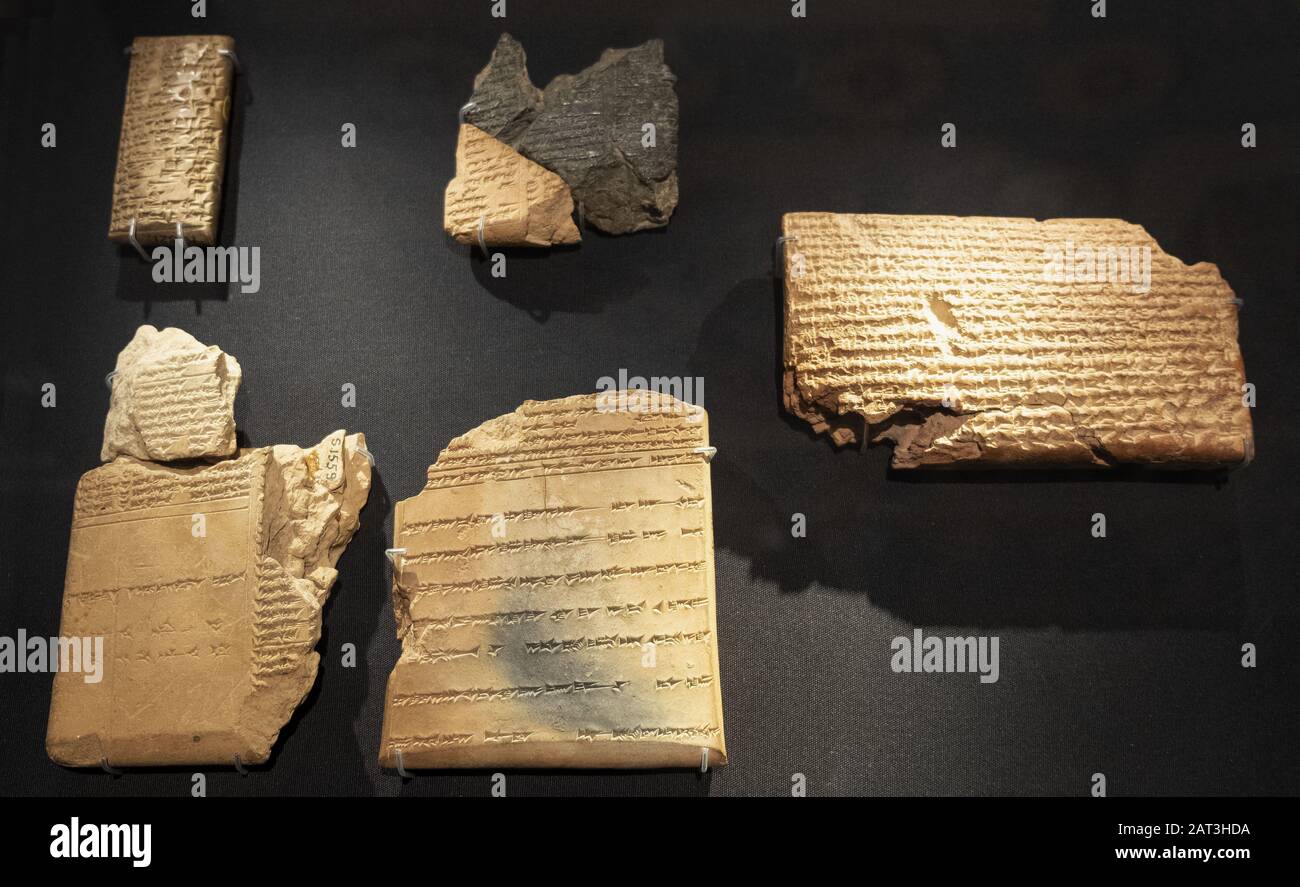 London, England / United Kingdom - 2019/01/28: Ancient Assyria clay tablets with Mesopotamian cuneiform writing from king Ashurbanipal royal library in Nineveh at the archeologic exposition in British Museum in London Stock Photohttps://www.alamy.com/image-license-details/?v=1https://www.alamy.com/london-england-united-kingdom-20190128-ancient-assyria-clay-tablets-with-mesopotamian-cuneiform-writing-from-king-ashurbanipal-royal-library-in-nineveh-at-the-archeologic-exposition-in-british-museum-in-london-image341828294.html
London, England / United Kingdom - 2019/01/28: Ancient Assyria clay tablets with Mesopotamian cuneiform writing from king Ashurbanipal royal library in Nineveh at the archeologic exposition in British Museum in London Stock Photohttps://www.alamy.com/image-license-details/?v=1https://www.alamy.com/london-england-united-kingdom-20190128-ancient-assyria-clay-tablets-with-mesopotamian-cuneiform-writing-from-king-ashurbanipal-royal-library-in-nineveh-at-the-archeologic-exposition-in-british-museum-in-london-image341828294.htmlRF2AT3HDA–London, England / United Kingdom - 2019/01/28: Ancient Assyria clay tablets with Mesopotamian cuneiform writing from king Ashurbanipal royal library in Nineveh at the archeologic exposition in British Museum in London
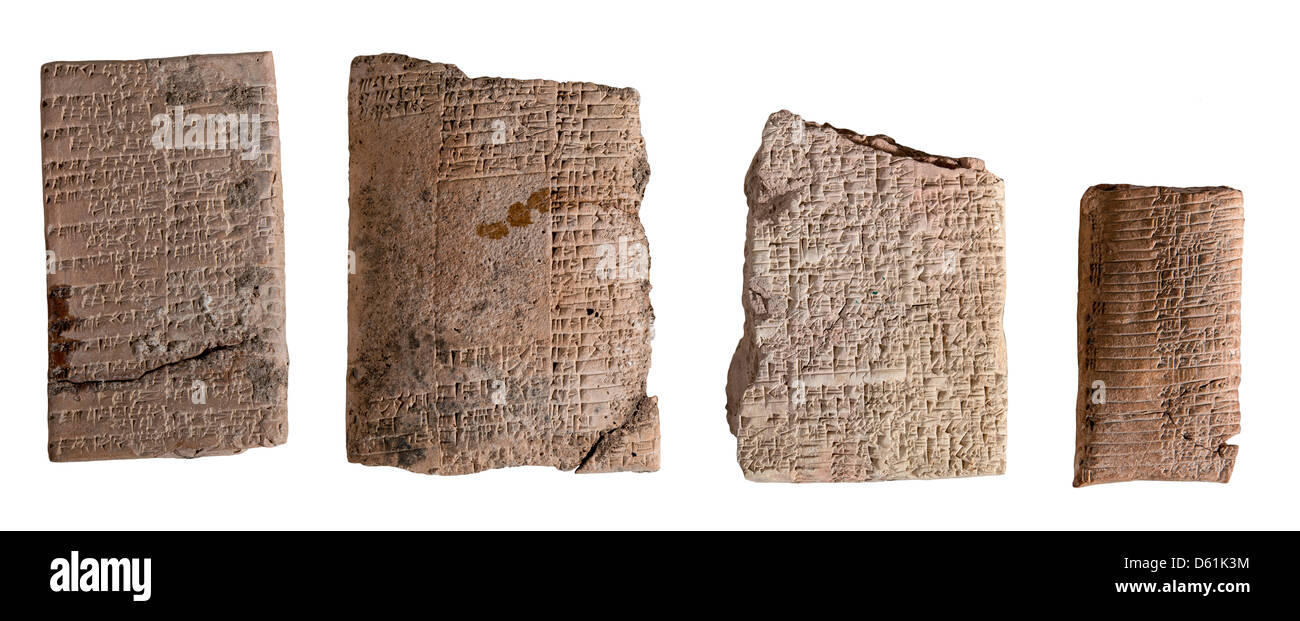 Four Cuneiform clay tablets with administrative text circa 2000 BCE Stock Photohttps://www.alamy.com/image-license-details/?v=1https://www.alamy.com/stock-photo-four-cuneiform-clay-tablets-with-administrative-text-circa-2000-bce-55355992.html
Four Cuneiform clay tablets with administrative text circa 2000 BCE Stock Photohttps://www.alamy.com/image-license-details/?v=1https://www.alamy.com/stock-photo-four-cuneiform-clay-tablets-with-administrative-text-circa-2000-bce-55355992.htmlRMD61K3M–Four Cuneiform clay tablets with administrative text circa 2000 BCE
 Four Cuneiform clay tablets with administrative text circa 2000 BCE Stock Photohttps://www.alamy.com/image-license-details/?v=1https://www.alamy.com/four-cuneiform-clay-tablets-with-administrative-text-circa-2000-bce-image546791303.html
Four Cuneiform clay tablets with administrative text circa 2000 BCE Stock Photohttps://www.alamy.com/image-license-details/?v=1https://www.alamy.com/four-cuneiform-clay-tablets-with-administrative-text-circa-2000-bce-image546791303.htmlRF2PNGDTR–Four Cuneiform clay tablets with administrative text circa 2000 BCE
 Local Tibetans making clay offering tablets. Sichuan, China. Stock Photohttps://www.alamy.com/image-license-details/?v=1https://www.alamy.com/stock-photo-local-tibetans-making-clay-offering-tablets-sichuan-china-38395317.html
Local Tibetans making clay offering tablets. Sichuan, China. Stock Photohttps://www.alamy.com/image-license-details/?v=1https://www.alamy.com/stock-photo-local-tibetans-making-clay-offering-tablets-sichuan-china-38395317.htmlRMC6D1H9–Local Tibetans making clay offering tablets. Sichuan, China.
 The Amarna Tablet or series of clay tablets Egyptian administration representatives vintage line drawing or engraving illustration. Stock Vectorhttps://www.alamy.com/image-license-details/?v=1https://www.alamy.com/the-amarna-tablet-or-series-of-clay-tablets-egyptian-administration-representatives-vintage-line-drawing-or-engraving-illustration-image244563463.html
The Amarna Tablet or series of clay tablets Egyptian administration representatives vintage line drawing or engraving illustration. Stock Vectorhttps://www.alamy.com/image-license-details/?v=1https://www.alamy.com/the-amarna-tablet-or-series-of-clay-tablets-egyptian-administration-representatives-vintage-line-drawing-or-engraving-illustration-image244563463.htmlRFT5TR5B–The Amarna Tablet or series of clay tablets Egyptian administration representatives vintage line drawing or engraving illustration.
 Edinburgh, Scotland, UK; 15 August, 2018. Pictured; Irving Finkel. Finkel is an expert reader of cuneiform inscriptions on clay tablets and a British Museum scholar. His book, 'The Writing in the Stone', is a work of bloodcurdling fiction set in Mesopotamia and inspired by a fractured piece of stone that resembles a cuneiform stone. Credit: Iain Masterton/Alamy Live News Stock Photohttps://www.alamy.com/image-license-details/?v=1https://www.alamy.com/edinburgh-scotland-uk-15-august-2018-pictured-irving-finkel-finkel-is-an-expert-reader-of-cuneiform-inscriptions-on-clay-tablets-and-a-british-museum-scholar-his-book-the-writing-in-the-stone-is-a-work-of-bloodcurdling-fiction-set-in-mesopotamia-and-inspired-by-a-fractured-piece-of-stone-that-resembles-a-cuneiform-stone-credit-iain-mastertonalamy-live-news-image215506556.html
Edinburgh, Scotland, UK; 15 August, 2018. Pictured; Irving Finkel. Finkel is an expert reader of cuneiform inscriptions on clay tablets and a British Museum scholar. His book, 'The Writing in the Stone', is a work of bloodcurdling fiction set in Mesopotamia and inspired by a fractured piece of stone that resembles a cuneiform stone. Credit: Iain Masterton/Alamy Live News Stock Photohttps://www.alamy.com/image-license-details/?v=1https://www.alamy.com/edinburgh-scotland-uk-15-august-2018-pictured-irving-finkel-finkel-is-an-expert-reader-of-cuneiform-inscriptions-on-clay-tablets-and-a-british-museum-scholar-his-book-the-writing-in-the-stone-is-a-work-of-bloodcurdling-fiction-set-in-mesopotamia-and-inspired-by-a-fractured-piece-of-stone-that-resembles-a-cuneiform-stone-credit-iain-mastertonalamy-live-news-image215506556.htmlRMPEH4PM–Edinburgh, Scotland, UK; 15 August, 2018. Pictured; Irving Finkel. Finkel is an expert reader of cuneiform inscriptions on clay tablets and a British Museum scholar. His book, 'The Writing in the Stone', is a work of bloodcurdling fiction set in Mesopotamia and inspired by a fractured piece of stone that resembles a cuneiform stone. Credit: Iain Masterton/Alamy Live News
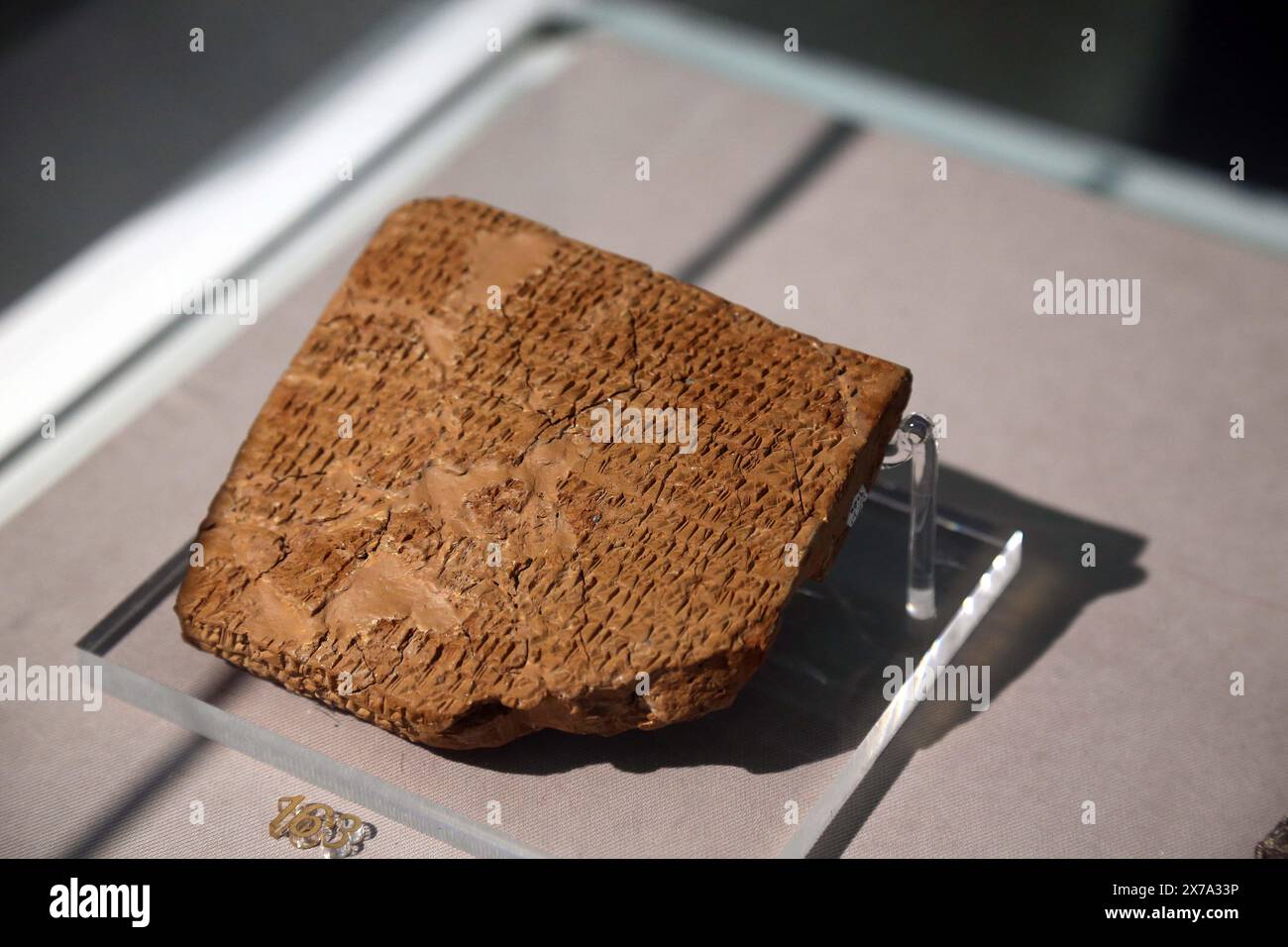 Tehran. 18th May, 2024. This photo taken on May 18, 2024 shows an ancient clay tablet at National Museum of Iran in Tehran, Iran. Iran on Saturday unveiled a selection of ancient clay tablets brought back to the country last year from the United States.TO GO WITH 'Iran unveils selection of ancient clay tablets returned from U.S.' Credit: Shadati/Xinhua/Alamy Live News Stock Photohttps://www.alamy.com/image-license-details/?v=1https://www.alamy.com/tehran-18th-may-2024-this-photo-taken-on-may-18-2024-shows-an-ancient-clay-tablet-at-national-museum-of-iran-in-tehran-iran-iran-on-saturday-unveiled-a-selection-of-ancient-clay-tablets-brought-back-to-the-country-last-year-from-the-united-statesto-go-with-iran-unveils-selection-of-ancient-clay-tablets-returned-from-us-credit-shadatixinhuaalamy-live-news-image606887450.html
Tehran. 18th May, 2024. This photo taken on May 18, 2024 shows an ancient clay tablet at National Museum of Iran in Tehran, Iran. Iran on Saturday unveiled a selection of ancient clay tablets brought back to the country last year from the United States.TO GO WITH 'Iran unveils selection of ancient clay tablets returned from U.S.' Credit: Shadati/Xinhua/Alamy Live News Stock Photohttps://www.alamy.com/image-license-details/?v=1https://www.alamy.com/tehran-18th-may-2024-this-photo-taken-on-may-18-2024-shows-an-ancient-clay-tablet-at-national-museum-of-iran-in-tehran-iran-iran-on-saturday-unveiled-a-selection-of-ancient-clay-tablets-brought-back-to-the-country-last-year-from-the-united-statesto-go-with-iran-unveils-selection-of-ancient-clay-tablets-returned-from-us-credit-shadatixinhuaalamy-live-news-image606887450.htmlRM2X7A33P–Tehran. 18th May, 2024. This photo taken on May 18, 2024 shows an ancient clay tablet at National Museum of Iran in Tehran, Iran. Iran on Saturday unveiled a selection of ancient clay tablets brought back to the country last year from the United States.TO GO WITH 'Iran unveils selection of ancient clay tablets returned from U.S.' Credit: Shadati/Xinhua/Alamy Live News
 7457. Oldest Alphabet Discovered in a tomb in the city of Umm el-Marra, Syria. Clay tablets engraved with symbols that may be part of the earliest kno Stock Photohttps://www.alamy.com/image-license-details/?v=1https://www.alamy.com/7457-oldest-alphabet-discovered-in-a-tomb-in-the-city-of-umm-el-marra-syria-clay-tablets-engraved-with-symbols-that-may-be-part-of-the-earliest-kno-image632862201.html
7457. Oldest Alphabet Discovered in a tomb in the city of Umm el-Marra, Syria. Clay tablets engraved with symbols that may be part of the earliest kno Stock Photohttps://www.alamy.com/image-license-details/?v=1https://www.alamy.com/7457-oldest-alphabet-discovered-in-a-tomb-in-the-city-of-umm-el-marra-syria-clay-tablets-engraved-with-symbols-that-may-be-part-of-the-earliest-kno-image632862201.htmlRF2YNHA5D–7457. Oldest Alphabet Discovered in a tomb in the city of Umm el-Marra, Syria. Clay tablets engraved with symbols that may be part of the earliest kno
 Clay tablets with celestial animals, Mawangdui Han Tomb, Hunan Provincial Museum, Changsa, Hunan Province, China Stock Photohttps://www.alamy.com/image-license-details/?v=1https://www.alamy.com/stock-photo-clay-tablets-with-celestial-animals-mawangdui-han-tomb-hunan-provincial-25085456.html
Clay tablets with celestial animals, Mawangdui Han Tomb, Hunan Provincial Museum, Changsa, Hunan Province, China Stock Photohttps://www.alamy.com/image-license-details/?v=1https://www.alamy.com/stock-photo-clay-tablets-with-celestial-animals-mawangdui-han-tomb-hunan-provincial-25085456.htmlRMBCPMN4–Clay tablets with celestial animals, Mawangdui Han Tomb, Hunan Provincial Museum, Changsa, Hunan Province, China
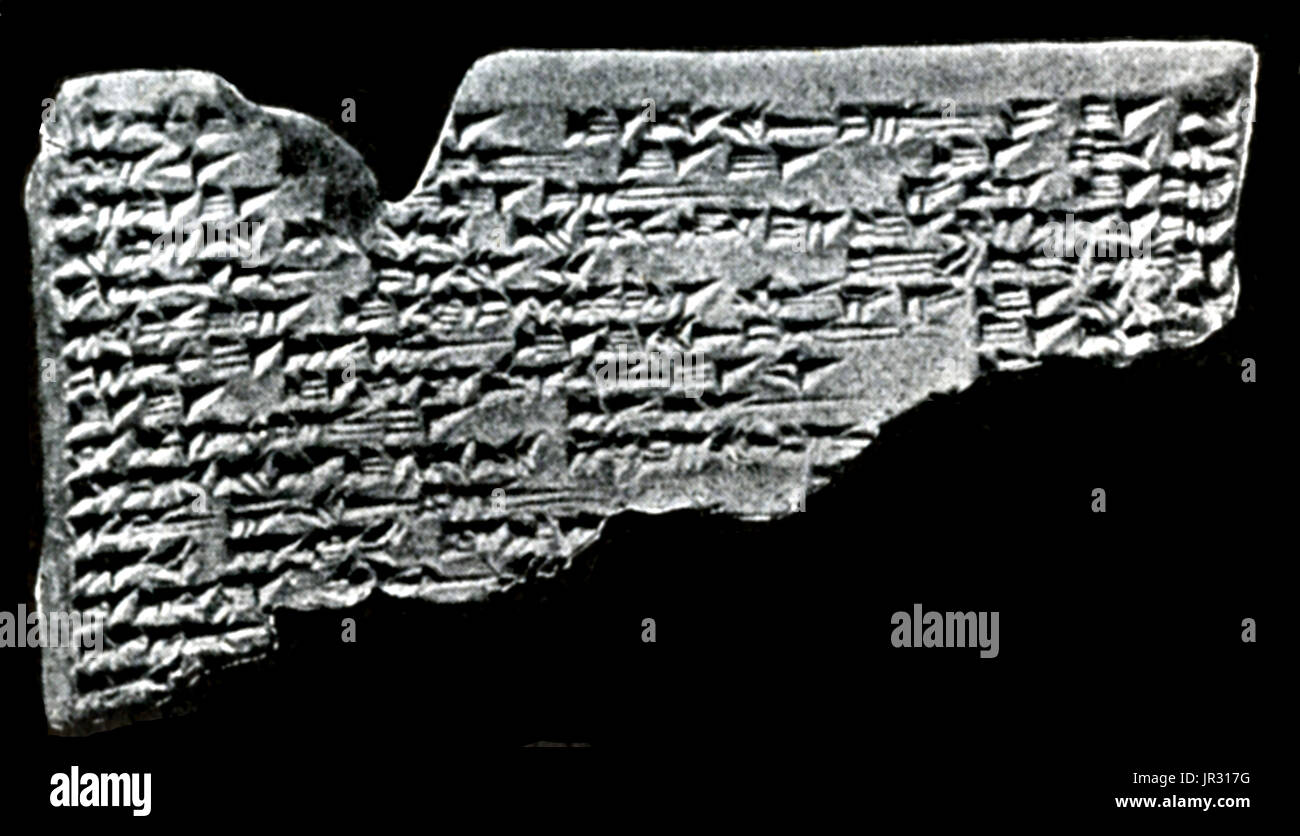 The Amarna tablets are an archive, written on clay tablets, primarily consisting of diplomatic correspondence between the Egyptian administration and its representatives in Canaan and Amurru during the New Kingdom. The Amarna letters are unusual in Egyptological research, because they are mostly written in Akkadian cuneiform, the writing system of ancient Mesopotamia, rather than that of ancient Egypt. The written correspondence spans a period of at most thirty years. The Amarna letters are of great significance for biblical studies as well as Semitic linguistics, since they shed light on the Stock Photohttps://www.alamy.com/image-license-details/?v=1https://www.alamy.com/the-amarna-tablets-are-an-archive-written-on-clay-tablets-primarily-image151886884.html
The Amarna tablets are an archive, written on clay tablets, primarily consisting of diplomatic correspondence between the Egyptian administration and its representatives in Canaan and Amurru during the New Kingdom. The Amarna letters are unusual in Egyptological research, because they are mostly written in Akkadian cuneiform, the writing system of ancient Mesopotamia, rather than that of ancient Egypt. The written correspondence spans a period of at most thirty years. The Amarna letters are of great significance for biblical studies as well as Semitic linguistics, since they shed light on the Stock Photohttps://www.alamy.com/image-license-details/?v=1https://www.alamy.com/the-amarna-tablets-are-an-archive-written-on-clay-tablets-primarily-image151886884.htmlRMJR317G–The Amarna tablets are an archive, written on clay tablets, primarily consisting of diplomatic correspondence between the Egyptian administration and its representatives in Canaan and Amurru during the New Kingdom. The Amarna letters are unusual in Egyptological research, because they are mostly written in Akkadian cuneiform, the writing system of ancient Mesopotamia, rather than that of ancient Egypt. The written correspondence spans a period of at most thirty years. The Amarna letters are of great significance for biblical studies as well as Semitic linguistics, since they shed light on the
 Administrative seal in the form of cuneiform clay tablets. From Mesopotamia 3100-2900 BC Stock Photohttps://www.alamy.com/image-license-details/?v=1https://www.alamy.com/stock-photo-administrative-seal-in-the-form-of-cuneiform-clay-tablets-from-mesopotamia-57351835.html
Administrative seal in the form of cuneiform clay tablets. From Mesopotamia 3100-2900 BC Stock Photohttps://www.alamy.com/image-license-details/?v=1https://www.alamy.com/stock-photo-administrative-seal-in-the-form-of-cuneiform-clay-tablets-from-mesopotamia-57351835.htmlRMD98GRR–Administrative seal in the form of cuneiform clay tablets. From Mesopotamia 3100-2900 BC
 Jar containing clay tablets written in cuneiform. 8th century. Pergamon Museum. Berlin. Germany. Stock Photohttps://www.alamy.com/image-license-details/?v=1https://www.alamy.com/stock-photo-jar-containing-clay-tablets-written-in-cuneiform-8th-century-pergamon-48640435.html
Jar containing clay tablets written in cuneiform. 8th century. Pergamon Museum. Berlin. Germany. Stock Photohttps://www.alamy.com/image-license-details/?v=1https://www.alamy.com/stock-photo-jar-containing-clay-tablets-written-in-cuneiform-8th-century-pergamon-48640435.htmlRMCR3NAB–Jar containing clay tablets written in cuneiform. 8th century. Pergamon Museum. Berlin. Germany.
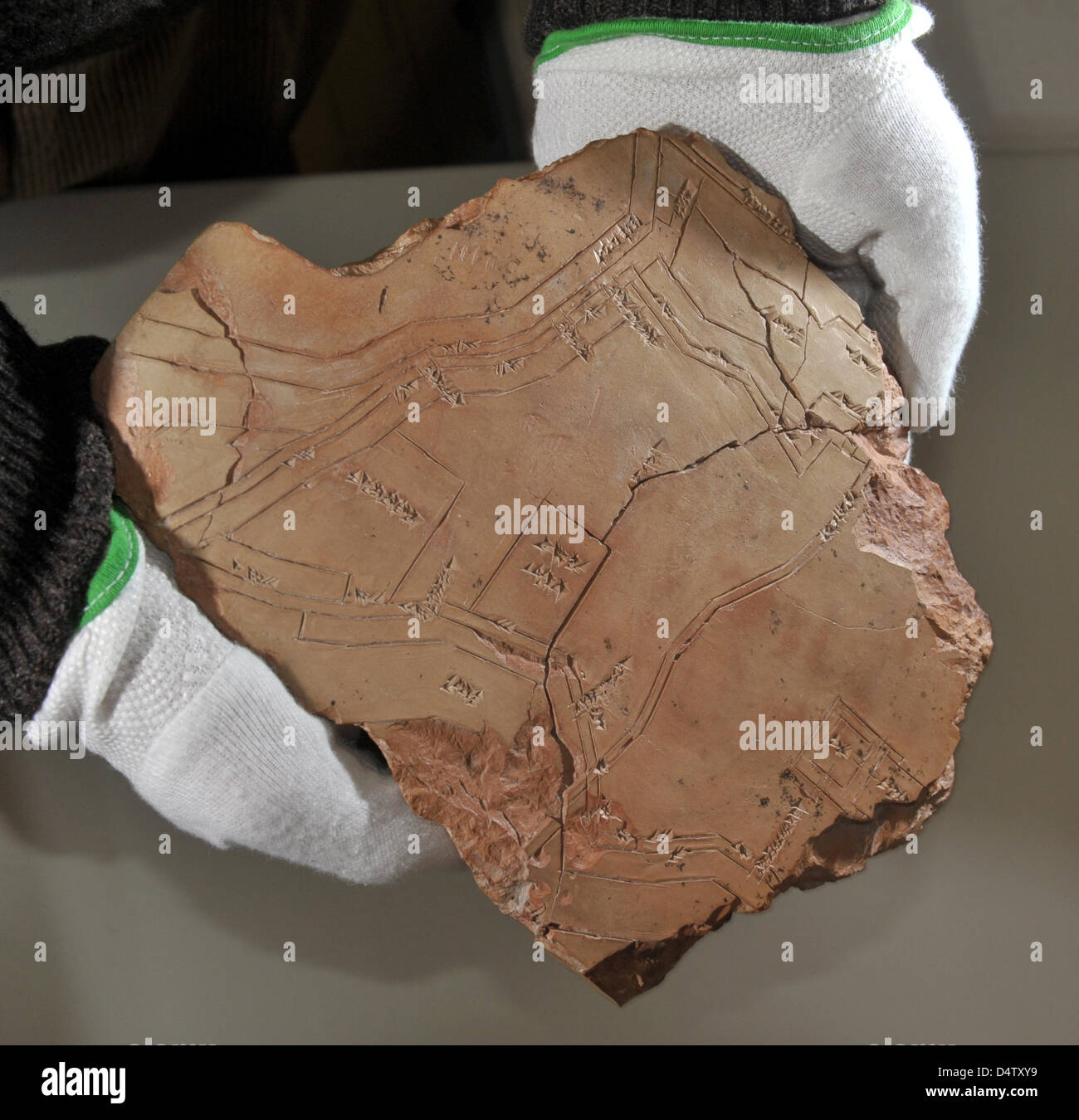 The world's oldest city map is prepared for three-dimensional digitalization with a special scanner at the Friedrich Schiller University of Jena, Germany, 01 December 2009. The tablet is approximately 3500 years old and shows the outline of the ancient Mesopotamian city of Nippur, today's Iraq. About 3300 clay tablets and other similar objects from the Hilprecht collection of the ' Stock Photohttps://www.alamy.com/image-license-details/?v=1https://www.alamy.com/stock-photo-the-worlds-oldest-city-map-is-prepared-for-three-dimensional-digitalization-54637725.html
The world's oldest city map is prepared for three-dimensional digitalization with a special scanner at the Friedrich Schiller University of Jena, Germany, 01 December 2009. The tablet is approximately 3500 years old and shows the outline of the ancient Mesopotamian city of Nippur, today's Iraq. About 3300 clay tablets and other similar objects from the Hilprecht collection of the ' Stock Photohttps://www.alamy.com/image-license-details/?v=1https://www.alamy.com/stock-photo-the-worlds-oldest-city-map-is-prepared-for-three-dimensional-digitalization-54637725.htmlRMD4TXY9–The world's oldest city map is prepared for three-dimensional digitalization with a special scanner at the Friedrich Schiller University of Jena, Germany, 01 December 2009. The tablet is approximately 3500 years old and shows the outline of the ancient Mesopotamian city of Nippur, today's Iraq. About 3300 clay tablets and other similar objects from the Hilprecht collection of the '
 Cuneiform tablet: unidentified fragment, ca. late 1st millennium B.C., Mesopotamia, Clay, 1 3/8 x 1 x 3/4 in. (3.4 x 2.6 x 2 cm), Clay-Tablets-Inscribed Stock Photohttps://www.alamy.com/image-license-details/?v=1https://www.alamy.com/cuneiform-tablet-unidentified-fragment-ca-late-1st-millennium-bc-mesopotamia-clay-1-38-x-1-x-34-in-34-x-26-x-2-cm-clay-tablets-inscribed-image344675257.html
Cuneiform tablet: unidentified fragment, ca. late 1st millennium B.C., Mesopotamia, Clay, 1 3/8 x 1 x 3/4 in. (3.4 x 2.6 x 2 cm), Clay-Tablets-Inscribed Stock Photohttps://www.alamy.com/image-license-details/?v=1https://www.alamy.com/cuneiform-tablet-unidentified-fragment-ca-late-1st-millennium-bc-mesopotamia-clay-1-38-x-1-x-34-in-34-x-26-x-2-cm-clay-tablets-inscribed-image344675257.htmlRM2B0N8PH–Cuneiform tablet: unidentified fragment, ca. late 1st millennium B.C., Mesopotamia, Clay, 1 3/8 x 1 x 3/4 in. (3.4 x 2.6 x 2 cm), Clay-Tablets-Inscribed
 Art inspired by Cuneiform tablet: unidentified fragment, ca. late 1st millennium B.C., Mesopotamia, Clay, 2 x 1 5/8 x 1 1/8 in. (5 x 4.2 x 2.9 cm), Clay-Tablets-Inscribed, Classic works modernized by Artotop with a splash of modernity. Shapes, color and value, eye-catching visual impact on art. Emotions through freedom of artworks in a contemporary way. A timeless message pursuing a wildly creative new direction. Artists turning to the digital medium and creating the Artotop NFT Stock Photohttps://www.alamy.com/image-license-details/?v=1https://www.alamy.com/art-inspired-by-cuneiform-tablet-unidentified-fragment-ca-late-1st-millennium-bc-mesopotamia-clay-2-x-1-58-x-1-18-in-5-x-42-x-29-cm-clay-tablets-inscribed-classic-works-modernized-by-artotop-with-a-splash-of-modernity-shapes-color-and-value-eye-catching-visual-impact-on-art-emotions-through-freedom-of-artworks-in-a-contemporary-way-a-timeless-message-pursuing-a-wildly-creative-new-direction-artists-turning-to-the-digital-medium-and-creating-the-artotop-nft-image462945259.html
Art inspired by Cuneiform tablet: unidentified fragment, ca. late 1st millennium B.C., Mesopotamia, Clay, 2 x 1 5/8 x 1 1/8 in. (5 x 4.2 x 2.9 cm), Clay-Tablets-Inscribed, Classic works modernized by Artotop with a splash of modernity. Shapes, color and value, eye-catching visual impact on art. Emotions through freedom of artworks in a contemporary way. A timeless message pursuing a wildly creative new direction. Artists turning to the digital medium and creating the Artotop NFT Stock Photohttps://www.alamy.com/image-license-details/?v=1https://www.alamy.com/art-inspired-by-cuneiform-tablet-unidentified-fragment-ca-late-1st-millennium-bc-mesopotamia-clay-2-x-1-58-x-1-18-in-5-x-42-x-29-cm-clay-tablets-inscribed-classic-works-modernized-by-artotop-with-a-splash-of-modernity-shapes-color-and-value-eye-catching-visual-impact-on-art-emotions-through-freedom-of-artworks-in-a-contemporary-way-a-timeless-message-pursuing-a-wildly-creative-new-direction-artists-turning-to-the-digital-medium-and-creating-the-artotop-nft-image462945259.htmlRF2HW4YB7–Art inspired by Cuneiform tablet: unidentified fragment, ca. late 1st millennium B.C., Mesopotamia, Clay, 2 x 1 5/8 x 1 1/8 in. (5 x 4.2 x 2.9 cm), Clay-Tablets-Inscribed, Classic works modernized by Artotop with a splash of modernity. Shapes, color and value, eye-catching visual impact on art. Emotions through freedom of artworks in a contemporary way. A timeless message pursuing a wildly creative new direction. Artists turning to the digital medium and creating the Artotop NFT
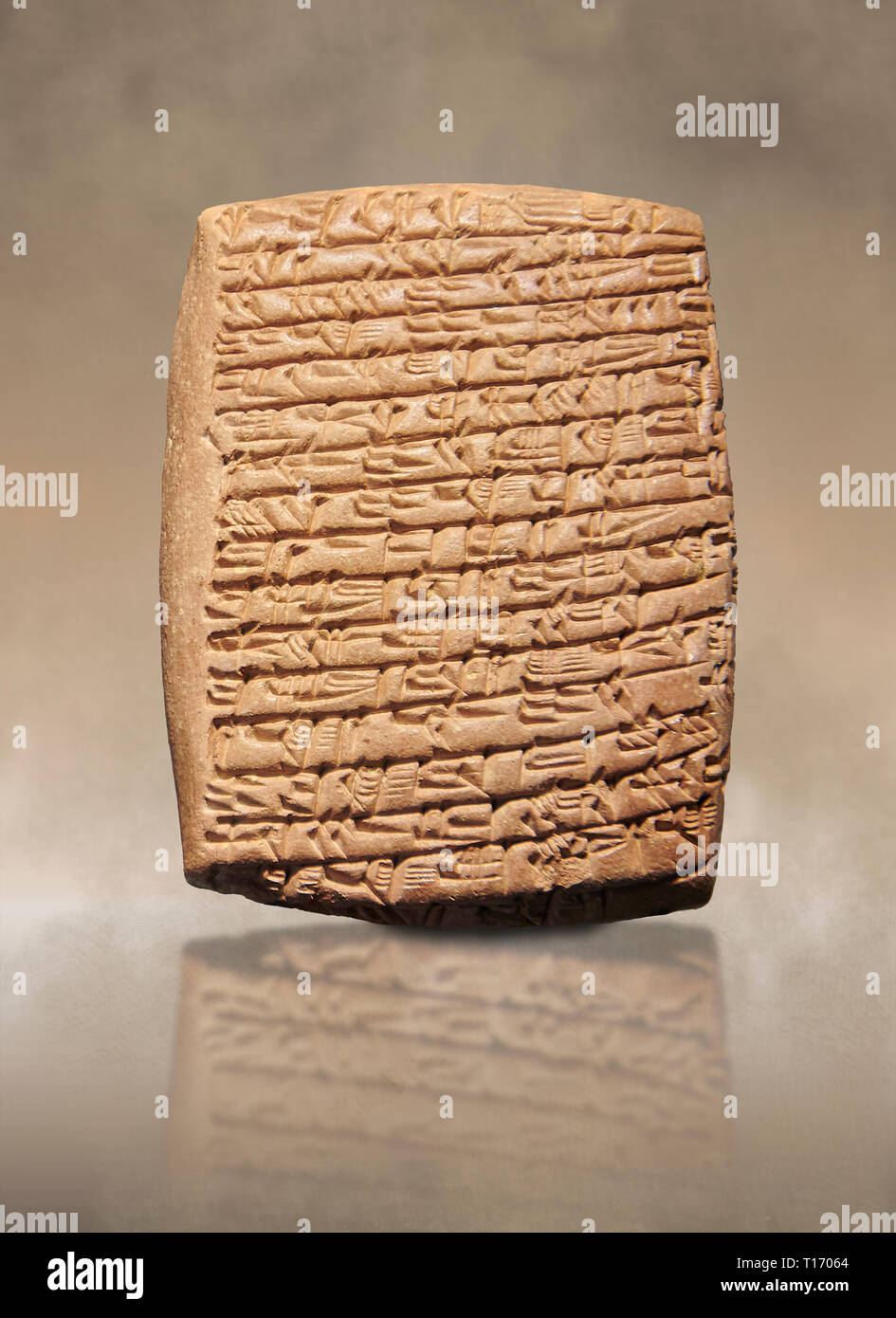 Hittite cuneiform tablet. Adana Archaeology Museum, Turkey. Stock Photohttps://www.alamy.com/image-license-details/?v=1https://www.alamy.com/hittite-cuneiform-tablet-adana-archaeology-museum-turkey-image241713644.html
Hittite cuneiform tablet. Adana Archaeology Museum, Turkey. Stock Photohttps://www.alamy.com/image-license-details/?v=1https://www.alamy.com/hittite-cuneiform-tablet-adana-archaeology-museum-turkey-image241713644.htmlRFT17064–Hittite cuneiform tablet. Adana Archaeology Museum, Turkey.
 18 April 2021, Lower Saxony, Lohheide/Hörsten: Clay tablets with the names of dead prisoners of war lie at the Soviet POW cemetery near Bergen-Belsen. The Association of Persecuted Nazis and the German Trade Union Confederation (DGB) commemorated the anniversary of the liberation of the Bergen-Belsen concentration camp. Photo: Philipp Schulze/dpa Stock Photohttps://www.alamy.com/image-license-details/?v=1https://www.alamy.com/18-april-2021-lower-saxony-lohheidehrsten-clay-tablets-with-the-names-of-dead-prisoners-of-war-lie-at-the-soviet-pow-cemetery-near-bergen-belsen-the-association-of-persecuted-nazis-and-the-german-trade-union-confederation-dgb-commemorated-the-anniversary-of-the-liberation-of-the-bergen-belsen-concentration-camp-photo-philipp-schulzedpa-image418909670.html
18 April 2021, Lower Saxony, Lohheide/Hörsten: Clay tablets with the names of dead prisoners of war lie at the Soviet POW cemetery near Bergen-Belsen. The Association of Persecuted Nazis and the German Trade Union Confederation (DGB) commemorated the anniversary of the liberation of the Bergen-Belsen concentration camp. Photo: Philipp Schulze/dpa Stock Photohttps://www.alamy.com/image-license-details/?v=1https://www.alamy.com/18-april-2021-lower-saxony-lohheidehrsten-clay-tablets-with-the-names-of-dead-prisoners-of-war-lie-at-the-soviet-pow-cemetery-near-bergen-belsen-the-association-of-persecuted-nazis-and-the-german-trade-union-confederation-dgb-commemorated-the-anniversary-of-the-liberation-of-the-bergen-belsen-concentration-camp-photo-philipp-schulzedpa-image418909670.htmlRM2F9EYFJ–18 April 2021, Lower Saxony, Lohheide/Hörsten: Clay tablets with the names of dead prisoners of war lie at the Soviet POW cemetery near Bergen-Belsen. The Association of Persecuted Nazis and the German Trade Union Confederation (DGB) commemorated the anniversary of the liberation of the Bergen-Belsen concentration camp. Photo: Philipp Schulze/dpa
 Ancient stone Ancient stone Bordeuax found (title object) Three performances of fragments of an ancient stone: Juno with peacock Zeus with Mercury or Ganymede and Leda with the zwaan. Manufacturer (?): printmaker Daniel Lots Where: d (I) (listed building) in drawing: Pierre Lacour (fils) (listed building) place manufacture: Amsterdam Date: 1776 - 1851 Physical features: etching material: paper Technique: etching dimensions: sheet: h 145 mmplaatrand b 209 mm Subject: clay tablets, stone tablet jupiter, in the shape of a swan, and Ledaattributes or Juno (story of) Ganymede ( story of) Mercury ( Stock Photohttps://www.alamy.com/image-license-details/?v=1https://www.alamy.com/ancient-stone-ancient-stone-bordeuax-found-title-object-three-performances-of-fragments-of-an-ancient-stone-juno-with-peacock-zeus-with-mercury-or-ganymede-and-leda-with-the-zwaan-manufacturer-printmaker-daniel-lots-where-d-i-listed-building-in-drawing-pierre-lacour-fils-listed-building-place-manufacture-amsterdam-date-1776-1851-physical-features-etching-material-paper-technique-etching-dimensions-sheet-h-145-mmplaatrand-b-209-mm-subject-clay-tablets-stone-tablet-jupiter-in-the-shape-of-a-swan-and-ledaattributes-or-juno-story-of-ganymede-story-of-mercury-image348138232.html
Ancient stone Ancient stone Bordeuax found (title object) Three performances of fragments of an ancient stone: Juno with peacock Zeus with Mercury or Ganymede and Leda with the zwaan. Manufacturer (?): printmaker Daniel Lots Where: d (I) (listed building) in drawing: Pierre Lacour (fils) (listed building) place manufacture: Amsterdam Date: 1776 - 1851 Physical features: etching material: paper Technique: etching dimensions: sheet: h 145 mmplaatrand b 209 mm Subject: clay tablets, stone tablet jupiter, in the shape of a swan, and Ledaattributes or Juno (story of) Ganymede ( story of) Mercury ( Stock Photohttps://www.alamy.com/image-license-details/?v=1https://www.alamy.com/ancient-stone-ancient-stone-bordeuax-found-title-object-three-performances-of-fragments-of-an-ancient-stone-juno-with-peacock-zeus-with-mercury-or-ganymede-and-leda-with-the-zwaan-manufacturer-printmaker-daniel-lots-where-d-i-listed-building-in-drawing-pierre-lacour-fils-listed-building-place-manufacture-amsterdam-date-1776-1851-physical-features-etching-material-paper-technique-etching-dimensions-sheet-h-145-mmplaatrand-b-209-mm-subject-clay-tablets-stone-tablet-jupiter-in-the-shape-of-a-swan-and-ledaattributes-or-juno-story-of-ganymede-story-of-mercury-image348138232.htmlRM2B6B1T8–Ancient stone Ancient stone Bordeuax found (title object) Three performances of fragments of an ancient stone: Juno with peacock Zeus with Mercury or Ganymede and Leda with the zwaan. Manufacturer (?): printmaker Daniel Lots Where: d (I) (listed building) in drawing: Pierre Lacour (fils) (listed building) place manufacture: Amsterdam Date: 1776 - 1851 Physical features: etching material: paper Technique: etching dimensions: sheet: h 145 mmplaatrand b 209 mm Subject: clay tablets, stone tablet jupiter, in the shape of a swan, and Ledaattributes or Juno (story of) Ganymede ( story of) Mercury (
 Cuneiform writing. Clay tablets written with prayers and rituals against the 'evil eye' and the vision of the underworld. 9th-7th Centuries B.C. Pergamon Museum. Berlin. Germany. Stock Photohttps://www.alamy.com/image-license-details/?v=1https://www.alamy.com/cuneiform-writing-clay-tablets-written-with-prayers-and-rituals-against-the-evil-eye-and-the-vision-of-the-underworld-9th-7th-centuries-bc-pergamon-museum-berlin-germany-image220344274.html
Cuneiform writing. Clay tablets written with prayers and rituals against the 'evil eye' and the vision of the underworld. 9th-7th Centuries B.C. Pergamon Museum. Berlin. Germany. Stock Photohttps://www.alamy.com/image-license-details/?v=1https://www.alamy.com/cuneiform-writing-clay-tablets-written-with-prayers-and-rituals-against-the-evil-eye-and-the-vision-of-the-underworld-9th-7th-centuries-bc-pergamon-museum-berlin-germany-image220344274.htmlRMPPDFAA–Cuneiform writing. Clay tablets written with prayers and rituals against the 'evil eye' and the vision of the underworld. 9th-7th Centuries B.C. Pergamon Museum. Berlin. Germany.
 Prehistoric archaeological site at Ugarit, Syria in 1998 - archive room where hundreds of clay tablets in Ugaritic script were found Stock Photohttps://www.alamy.com/image-license-details/?v=1https://www.alamy.com/prehistoric-archaeological-site-at-ugarit-syria-in-1998-archive-room-where-hundreds-of-clay-tablets-in-ugaritic-script-were-found-image454281639.html
Prehistoric archaeological site at Ugarit, Syria in 1998 - archive room where hundreds of clay tablets in Ugaritic script were found Stock Photohttps://www.alamy.com/image-license-details/?v=1https://www.alamy.com/prehistoric-archaeological-site-at-ugarit-syria-in-1998-archive-room-where-hundreds-of-clay-tablets-in-ugaritic-script-were-found-image454281639.htmlRM2HB28T7–Prehistoric archaeological site at Ugarit, Syria in 1998 - archive room where hundreds of clay tablets in Ugaritic script were found
 Clay tablets at the kiosk of Kertassi, Francis Frith, in or after c. 1856 - in or before c. 1859 photograph Egypt paper albumen print clay tablet, stone tablet Stock Photohttps://www.alamy.com/image-license-details/?v=1https://www.alamy.com/clay-tablets-at-the-kiosk-of-kertassi-francis-frith-in-or-after-c-1856-in-or-before-c-1859-photograph-egypt-paper-albumen-print-clay-tablet-stone-tablet-image592513242.html
Clay tablets at the kiosk of Kertassi, Francis Frith, in or after c. 1856 - in or before c. 1859 photograph Egypt paper albumen print clay tablet, stone tablet Stock Photohttps://www.alamy.com/image-license-details/?v=1https://www.alamy.com/clay-tablets-at-the-kiosk-of-kertassi-francis-frith-in-or-after-c-1856-in-or-before-c-1859-photograph-egypt-paper-albumen-print-clay-tablet-stone-tablet-image592513242.htmlRM2WBY8K6–Clay tablets at the kiosk of Kertassi, Francis Frith, in or after c. 1856 - in or before c. 1859 photograph Egypt paper albumen print clay tablet, stone tablet
 3 Cuneiform clay tablets with economic text circa 2000 BCE Stock Photohttps://www.alamy.com/image-license-details/?v=1https://www.alamy.com/3-cuneiform-clay-tablets-with-economic-text-circa-2000-bce-image546791445.html
3 Cuneiform clay tablets with economic text circa 2000 BCE Stock Photohttps://www.alamy.com/image-license-details/?v=1https://www.alamy.com/3-cuneiform-clay-tablets-with-economic-text-circa-2000-bce-image546791445.htmlRF2PNGE1W–3 Cuneiform clay tablets with economic text circa 2000 BCE
 Local Tibetans making clay offering tablets at a Buddhist temple. Sichuan, China. Stock Photohttps://www.alamy.com/image-license-details/?v=1https://www.alamy.com/stock-photo-local-tibetans-making-clay-offering-tablets-at-a-buddhist-temple-sichuan-38395323.html
Local Tibetans making clay offering tablets at a Buddhist temple. Sichuan, China. Stock Photohttps://www.alamy.com/image-license-details/?v=1https://www.alamy.com/stock-photo-local-tibetans-making-clay-offering-tablets-at-a-buddhist-temple-sichuan-38395323.htmlRMC6D1HF–Local Tibetans making clay offering tablets at a Buddhist temple. Sichuan, China.
 27.05.2017 Keramik Deutschland/ Niedersachsen/ Wendland/ Landkreis Lüchow Dannenberg/ Bülitz/ Wohnhaus/ in der Backsteinwand sind gebrannte Tontafeln mit der Aufschrift Was wir uns nicht vorstellen können ist unerreichbar für uns eingearbeitet/ ***Nutzung nur redaktionell*** *** 27 05 2017 Ceramics Germany Lower Saxony Wendland district Lüchow Dannenberg Bülitz residential house in the brick wall are fired clay tablets with the inscription What we cannot imagine is unattainable for us Use only for editorial purposes Stock Photohttps://www.alamy.com/image-license-details/?v=1https://www.alamy.com/27052017-keramik-deutschland-niedersachsen-wendland-landkreis-lchow-dannenberg-blitz-wohnhaus-in-der-backsteinwand-sind-gebrannte-tontafeln-mit-der-aufschrift-was-wir-uns-nicht-vorstellen-knnen-ist-unerreichbar-fr-uns-eingearbeitet-nutzung-nur-redaktionell-27-05-2017-ceramics-germany-lower-saxony-wendland-district-lchow-dannenberg-blitz-residential-house-in-the-brick-wall-are-fired-clay-tablets-with-the-inscription-what-we-cannot-imagine-is-unattainable-for-us-use-only-for-editorial-purposes-image605042648.html
27.05.2017 Keramik Deutschland/ Niedersachsen/ Wendland/ Landkreis Lüchow Dannenberg/ Bülitz/ Wohnhaus/ in der Backsteinwand sind gebrannte Tontafeln mit der Aufschrift Was wir uns nicht vorstellen können ist unerreichbar für uns eingearbeitet/ ***Nutzung nur redaktionell*** *** 27 05 2017 Ceramics Germany Lower Saxony Wendland district Lüchow Dannenberg Bülitz residential house in the brick wall are fired clay tablets with the inscription What we cannot imagine is unattainable for us Use only for editorial purposes Stock Photohttps://www.alamy.com/image-license-details/?v=1https://www.alamy.com/27052017-keramik-deutschland-niedersachsen-wendland-landkreis-lchow-dannenberg-blitz-wohnhaus-in-der-backsteinwand-sind-gebrannte-tontafeln-mit-der-aufschrift-was-wir-uns-nicht-vorstellen-knnen-ist-unerreichbar-fr-uns-eingearbeitet-nutzung-nur-redaktionell-27-05-2017-ceramics-germany-lower-saxony-wendland-district-lchow-dannenberg-blitz-residential-house-in-the-brick-wall-are-fired-clay-tablets-with-the-inscription-what-we-cannot-imagine-is-unattainable-for-us-use-only-for-editorial-purposes-image605042648.htmlRM2X4A220–27.05.2017 Keramik Deutschland/ Niedersachsen/ Wendland/ Landkreis Lüchow Dannenberg/ Bülitz/ Wohnhaus/ in der Backsteinwand sind gebrannte Tontafeln mit der Aufschrift Was wir uns nicht vorstellen können ist unerreichbar für uns eingearbeitet/ ***Nutzung nur redaktionell*** *** 27 05 2017 Ceramics Germany Lower Saxony Wendland district Lüchow Dannenberg Bülitz residential house in the brick wall are fired clay tablets with the inscription What we cannot imagine is unattainable for us Use only for editorial purposes
 Edinburgh, Scotland, UK; 15 August, 2018. Pictured; Irving Finkel. Finkel is an expert reader of cuneiform inscriptions on clay tablets and a British Museum scholar. His book, 'The Writing in the Stone', is a work of bloodcurdling fiction set in Mesopotamia and inspired by a fractured piece of stone that resembles a cuneiform stone. Credit: Iain Masterton/Alamy Live News Stock Photohttps://www.alamy.com/image-license-details/?v=1https://www.alamy.com/edinburgh-scotland-uk-15-august-2018-pictured-irving-finkel-finkel-is-an-expert-reader-of-cuneiform-inscriptions-on-clay-tablets-and-a-british-museum-scholar-his-book-the-writing-in-the-stone-is-a-work-of-bloodcurdling-fiction-set-in-mesopotamia-and-inspired-by-a-fractured-piece-of-stone-that-resembles-a-cuneiform-stone-credit-iain-mastertonalamy-live-news-image215506553.html
Edinburgh, Scotland, UK; 15 August, 2018. Pictured; Irving Finkel. Finkel is an expert reader of cuneiform inscriptions on clay tablets and a British Museum scholar. His book, 'The Writing in the Stone', is a work of bloodcurdling fiction set in Mesopotamia and inspired by a fractured piece of stone that resembles a cuneiform stone. Credit: Iain Masterton/Alamy Live News Stock Photohttps://www.alamy.com/image-license-details/?v=1https://www.alamy.com/edinburgh-scotland-uk-15-august-2018-pictured-irving-finkel-finkel-is-an-expert-reader-of-cuneiform-inscriptions-on-clay-tablets-and-a-british-museum-scholar-his-book-the-writing-in-the-stone-is-a-work-of-bloodcurdling-fiction-set-in-mesopotamia-and-inspired-by-a-fractured-piece-of-stone-that-resembles-a-cuneiform-stone-credit-iain-mastertonalamy-live-news-image215506553.htmlRMPEH4PH–Edinburgh, Scotland, UK; 15 August, 2018. Pictured; Irving Finkel. Finkel is an expert reader of cuneiform inscriptions on clay tablets and a British Museum scholar. His book, 'The Writing in the Stone', is a work of bloodcurdling fiction set in Mesopotamia and inspired by a fractured piece of stone that resembles a cuneiform stone. Credit: Iain Masterton/Alamy Live News
 Tehran. 18th May, 2024. This photo taken on May 18, 2024 shows an ancient clay tablet at National Museum of Iran in Tehran, Iran. Iran on Saturday unveiled a selection of ancient clay tablets brought back to the country last year from the United States.TO GO WITH 'Iran unveils selection of ancient clay tablets returned from U.S.' Credit: Shadati/Xinhua/Alamy Live News Stock Photohttps://www.alamy.com/image-license-details/?v=1https://www.alamy.com/tehran-18th-may-2024-this-photo-taken-on-may-18-2024-shows-an-ancient-clay-tablet-at-national-museum-of-iran-in-tehran-iran-iran-on-saturday-unveiled-a-selection-of-ancient-clay-tablets-brought-back-to-the-country-last-year-from-the-united-statesto-go-with-iran-unveils-selection-of-ancient-clay-tablets-returned-from-us-credit-shadatixinhuaalamy-live-news-image606887452.html
Tehran. 18th May, 2024. This photo taken on May 18, 2024 shows an ancient clay tablet at National Museum of Iran in Tehran, Iran. Iran on Saturday unveiled a selection of ancient clay tablets brought back to the country last year from the United States.TO GO WITH 'Iran unveils selection of ancient clay tablets returned from U.S.' Credit: Shadati/Xinhua/Alamy Live News Stock Photohttps://www.alamy.com/image-license-details/?v=1https://www.alamy.com/tehran-18th-may-2024-this-photo-taken-on-may-18-2024-shows-an-ancient-clay-tablet-at-national-museum-of-iran-in-tehran-iran-iran-on-saturday-unveiled-a-selection-of-ancient-clay-tablets-brought-back-to-the-country-last-year-from-the-united-statesto-go-with-iran-unveils-selection-of-ancient-clay-tablets-returned-from-us-credit-shadatixinhuaalamy-live-news-image606887452.htmlRM2X7A33T–Tehran. 18th May, 2024. This photo taken on May 18, 2024 shows an ancient clay tablet at National Museum of Iran in Tehran, Iran. Iran on Saturday unveiled a selection of ancient clay tablets brought back to the country last year from the United States.TO GO WITH 'Iran unveils selection of ancient clay tablets returned from U.S.' Credit: Shadati/Xinhua/Alamy Live News
 Pile of Leca Ball or Hydroton clay tablets for plant isolated on white background Stock Photohttps://www.alamy.com/image-license-details/?v=1https://www.alamy.com/pile-of-leca-ball-or-hydroton-clay-tablets-for-plant-isolated-on-white-background-image474129285.html
Pile of Leca Ball or Hydroton clay tablets for plant isolated on white background Stock Photohttps://www.alamy.com/image-license-details/?v=1https://www.alamy.com/pile-of-leca-ball-or-hydroton-clay-tablets-for-plant-isolated-on-white-background-image474129285.htmlRF2JFACMN–Pile of Leca Ball or Hydroton clay tablets for plant isolated on white background
 The Glozel Alphabet Tablets Stock Photohttps://www.alamy.com/image-license-details/?v=1https://www.alamy.com/the-glozel-alphabet-tablets-image501357621.html
The Glozel Alphabet Tablets Stock Photohttps://www.alamy.com/image-license-details/?v=1https://www.alamy.com/the-glozel-alphabet-tablets-image501357621.htmlRM2M3JPN9–The Glozel Alphabet Tablets
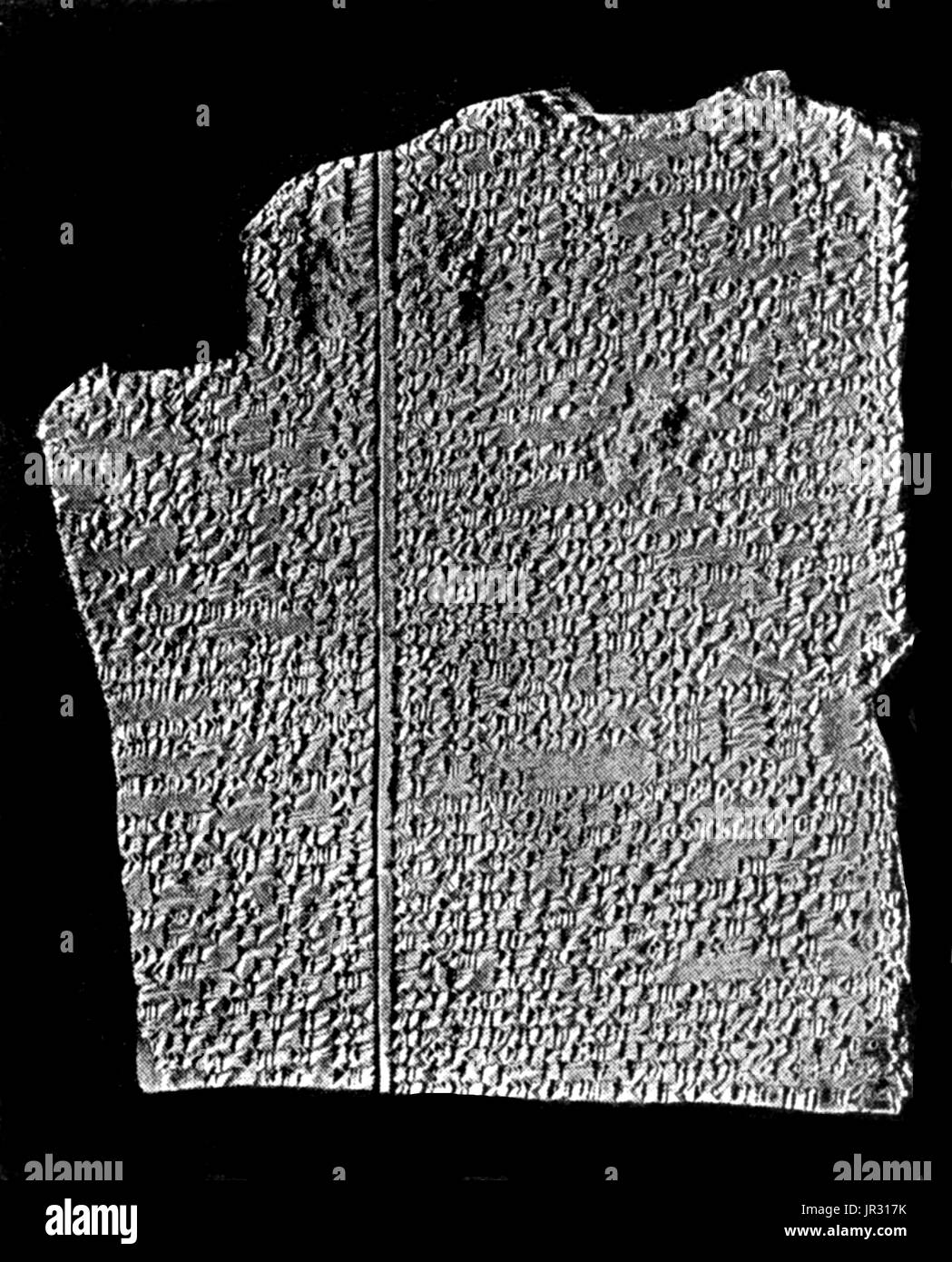 The Amarna tablets are an archive, written on clay tablets, primarily consisting of diplomatic correspondence between the Egyptian administration and its representatives in Canaan and Amurru during the New Kingdom. The Amarna letters are unusual in Egyptological research, because they are mostly written in Akkadian cuneiform, the writing system of ancient Mesopotamia, rather than that of ancient Egypt. The written correspondence spans a period of at most thirty years. The Amarna letters are of great significance for biblical studies as well as Semitic linguistics, since they shed light on the Stock Photohttps://www.alamy.com/image-license-details/?v=1https://www.alamy.com/the-amarna-tablets-are-an-archive-written-on-clay-tablets-primarily-image151886887.html
The Amarna tablets are an archive, written on clay tablets, primarily consisting of diplomatic correspondence between the Egyptian administration and its representatives in Canaan and Amurru during the New Kingdom. The Amarna letters are unusual in Egyptological research, because they are mostly written in Akkadian cuneiform, the writing system of ancient Mesopotamia, rather than that of ancient Egypt. The written correspondence spans a period of at most thirty years. The Amarna letters are of great significance for biblical studies as well as Semitic linguistics, since they shed light on the Stock Photohttps://www.alamy.com/image-license-details/?v=1https://www.alamy.com/the-amarna-tablets-are-an-archive-written-on-clay-tablets-primarily-image151886887.htmlRMJR317K–The Amarna tablets are an archive, written on clay tablets, primarily consisting of diplomatic correspondence between the Egyptian administration and its representatives in Canaan and Amurru during the New Kingdom. The Amarna letters are unusual in Egyptological research, because they are mostly written in Akkadian cuneiform, the writing system of ancient Mesopotamia, rather than that of ancient Egypt. The written correspondence spans a period of at most thirty years. The Amarna letters are of great significance for biblical studies as well as Semitic linguistics, since they shed light on the
 Administrative seal in the form of cuneiform clay tablets. From Mesopotamia 3100-2900 BC Stock Photohttps://www.alamy.com/image-license-details/?v=1https://www.alamy.com/stock-photo-administrative-seal-in-the-form-of-cuneiform-clay-tablets-from-mesopotamia-57351840.html
Administrative seal in the form of cuneiform clay tablets. From Mesopotamia 3100-2900 BC Stock Photohttps://www.alamy.com/image-license-details/?v=1https://www.alamy.com/stock-photo-administrative-seal-in-the-form-of-cuneiform-clay-tablets-from-mesopotamia-57351840.htmlRMD98GT0–Administrative seal in the form of cuneiform clay tablets. From Mesopotamia 3100-2900 BC
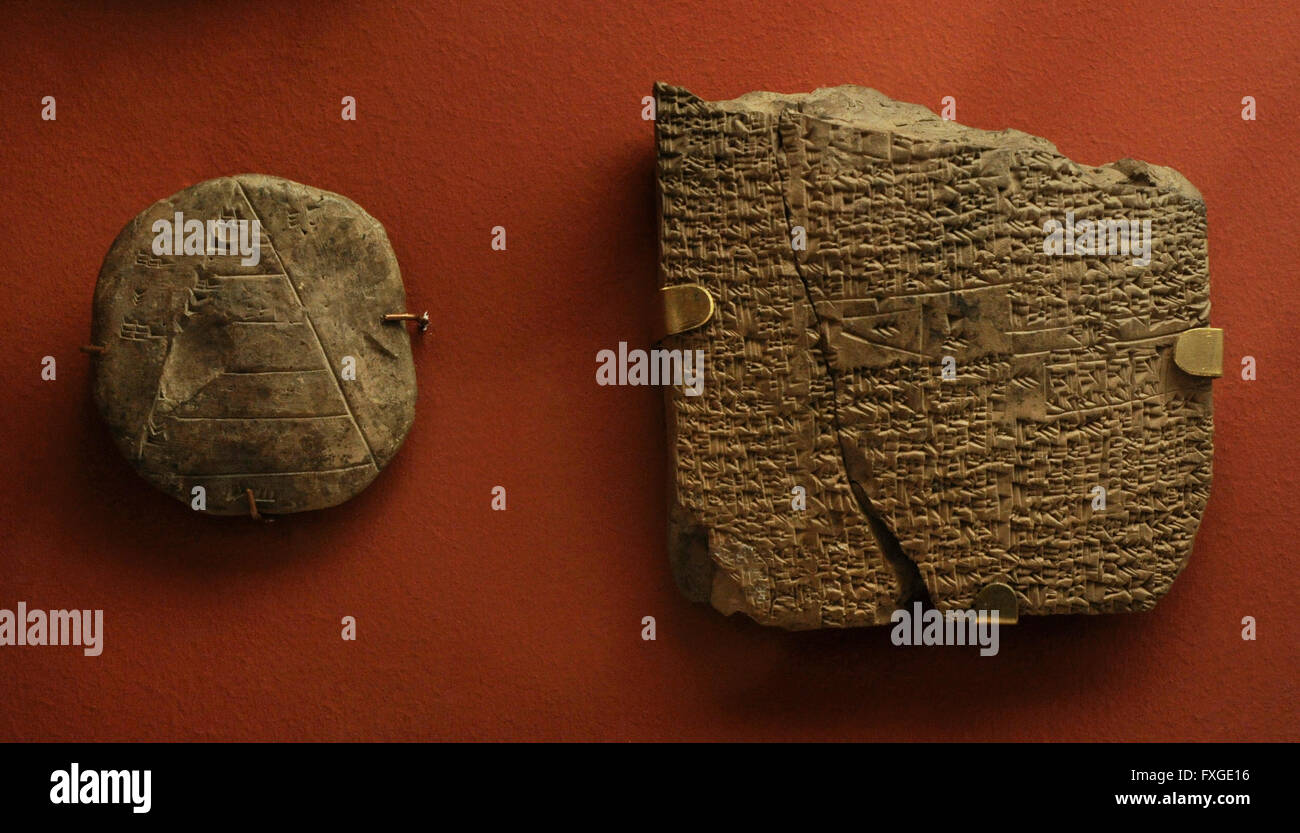 Sumer. Mesopotamia. School mathematical tablets. Clay. The state Hermitage Museum. Saint Petersburg. Russia. Stock Photohttps://www.alamy.com/image-license-details/?v=1https://www.alamy.com/stock-photo-sumer-mesopotamia-school-mathematical-tablets-clay-the-state-hermitage-102395138.html
Sumer. Mesopotamia. School mathematical tablets. Clay. The state Hermitage Museum. Saint Petersburg. Russia. Stock Photohttps://www.alamy.com/image-license-details/?v=1https://www.alamy.com/stock-photo-sumer-mesopotamia-school-mathematical-tablets-clay-the-state-hermitage-102395138.htmlRMFXGE16–Sumer. Mesopotamia. School mathematical tablets. Clay. The state Hermitage Museum. Saint Petersburg. Russia.
 A 3700-year-old clay tablet with cuneiform inscriptions is prepared for three-dimensional digitalization with a special scanner at the Friedrich Schiller University of Jena, Germany, 01 December 2009. The tablet shows mathematical strings and stems from the ancient Mesopotamian city of Nippur, today's Iraq. About 3300 clay tablets and other similar objects from the Hilprecht collec Stock Photohttps://www.alamy.com/image-license-details/?v=1https://www.alamy.com/stock-photo-a-3700-year-old-clay-tablet-with-cuneiform-inscriptions-is-prepared-54637709.html
A 3700-year-old clay tablet with cuneiform inscriptions is prepared for three-dimensional digitalization with a special scanner at the Friedrich Schiller University of Jena, Germany, 01 December 2009. The tablet shows mathematical strings and stems from the ancient Mesopotamian city of Nippur, today's Iraq. About 3300 clay tablets and other similar objects from the Hilprecht collec Stock Photohttps://www.alamy.com/image-license-details/?v=1https://www.alamy.com/stock-photo-a-3700-year-old-clay-tablet-with-cuneiform-inscriptions-is-prepared-54637709.htmlRMD4TXXN–A 3700-year-old clay tablet with cuneiform inscriptions is prepared for three-dimensional digitalization with a special scanner at the Friedrich Schiller University of Jena, Germany, 01 December 2009. The tablet shows mathematical strings and stems from the ancient Mesopotamian city of Nippur, today's Iraq. About 3300 clay tablets and other similar objects from the Hilprecht collec
 Cuneiform tablet: fragment of a table of reciprocals, ca. late 1st millennium B.C., Mesopotamia, Clay, 3 1/8 x 2 x 1 3/8 in. (8 x 5 x 3.4 cm), Clay-Tablets-Inscribed Stock Photohttps://www.alamy.com/image-license-details/?v=1https://www.alamy.com/cuneiform-tablet-fragment-of-a-table-of-reciprocals-ca-late-1st-millennium-bc-mesopotamia-clay-3-18-x-2-x-1-38-in-8-x-5-x-34-cm-clay-tablets-inscribed-image344667974.html
Cuneiform tablet: fragment of a table of reciprocals, ca. late 1st millennium B.C., Mesopotamia, Clay, 3 1/8 x 2 x 1 3/8 in. (8 x 5 x 3.4 cm), Clay-Tablets-Inscribed Stock Photohttps://www.alamy.com/image-license-details/?v=1https://www.alamy.com/cuneiform-tablet-fragment-of-a-table-of-reciprocals-ca-late-1st-millennium-bc-mesopotamia-clay-3-18-x-2-x-1-38-in-8-x-5-x-34-cm-clay-tablets-inscribed-image344667974.htmlRM2B0MYEE–Cuneiform tablet: fragment of a table of reciprocals, ca. late 1st millennium B.C., Mesopotamia, Clay, 3 1/8 x 2 x 1 3/8 in. (8 x 5 x 3.4 cm), Clay-Tablets-Inscribed
 Art inspired by Cuneiform tablet: unidentified fragment, ca. late 1st millennium B.C., Mesopotamia, Clay, 2 x 1 7/8 x 1 in. (5.1 x 4.8 x 2.4 cm), Clay-Tablets-Inscribed, Classic works modernized by Artotop with a splash of modernity. Shapes, color and value, eye-catching visual impact on art. Emotions through freedom of artworks in a contemporary way. A timeless message pursuing a wildly creative new direction. Artists turning to the digital medium and creating the Artotop NFT Stock Photohttps://www.alamy.com/image-license-details/?v=1https://www.alamy.com/art-inspired-by-cuneiform-tablet-unidentified-fragment-ca-late-1st-millennium-bc-mesopotamia-clay-2-x-1-78-x-1-in-51-x-48-x-24-cm-clay-tablets-inscribed-classic-works-modernized-by-artotop-with-a-splash-of-modernity-shapes-color-and-value-eye-catching-visual-impact-on-art-emotions-through-freedom-of-artworks-in-a-contemporary-way-a-timeless-message-pursuing-a-wildly-creative-new-direction-artists-turning-to-the-digital-medium-and-creating-the-artotop-nft-image462944400.html
Art inspired by Cuneiform tablet: unidentified fragment, ca. late 1st millennium B.C., Mesopotamia, Clay, 2 x 1 7/8 x 1 in. (5.1 x 4.8 x 2.4 cm), Clay-Tablets-Inscribed, Classic works modernized by Artotop with a splash of modernity. Shapes, color and value, eye-catching visual impact on art. Emotions through freedom of artworks in a contemporary way. A timeless message pursuing a wildly creative new direction. Artists turning to the digital medium and creating the Artotop NFT Stock Photohttps://www.alamy.com/image-license-details/?v=1https://www.alamy.com/art-inspired-by-cuneiform-tablet-unidentified-fragment-ca-late-1st-millennium-bc-mesopotamia-clay-2-x-1-78-x-1-in-51-x-48-x-24-cm-clay-tablets-inscribed-classic-works-modernized-by-artotop-with-a-splash-of-modernity-shapes-color-and-value-eye-catching-visual-impact-on-art-emotions-through-freedom-of-artworks-in-a-contemporary-way-a-timeless-message-pursuing-a-wildly-creative-new-direction-artists-turning-to-the-digital-medium-and-creating-the-artotop-nft-image462944400.htmlRF2HW4X8G–Art inspired by Cuneiform tablet: unidentified fragment, ca. late 1st millennium B.C., Mesopotamia, Clay, 2 x 1 7/8 x 1 in. (5.1 x 4.8 x 2.4 cm), Clay-Tablets-Inscribed, Classic works modernized by Artotop with a splash of modernity. Shapes, color and value, eye-catching visual impact on art. Emotions through freedom of artworks in a contemporary way. A timeless message pursuing a wildly creative new direction. Artists turning to the digital medium and creating the Artotop NFT
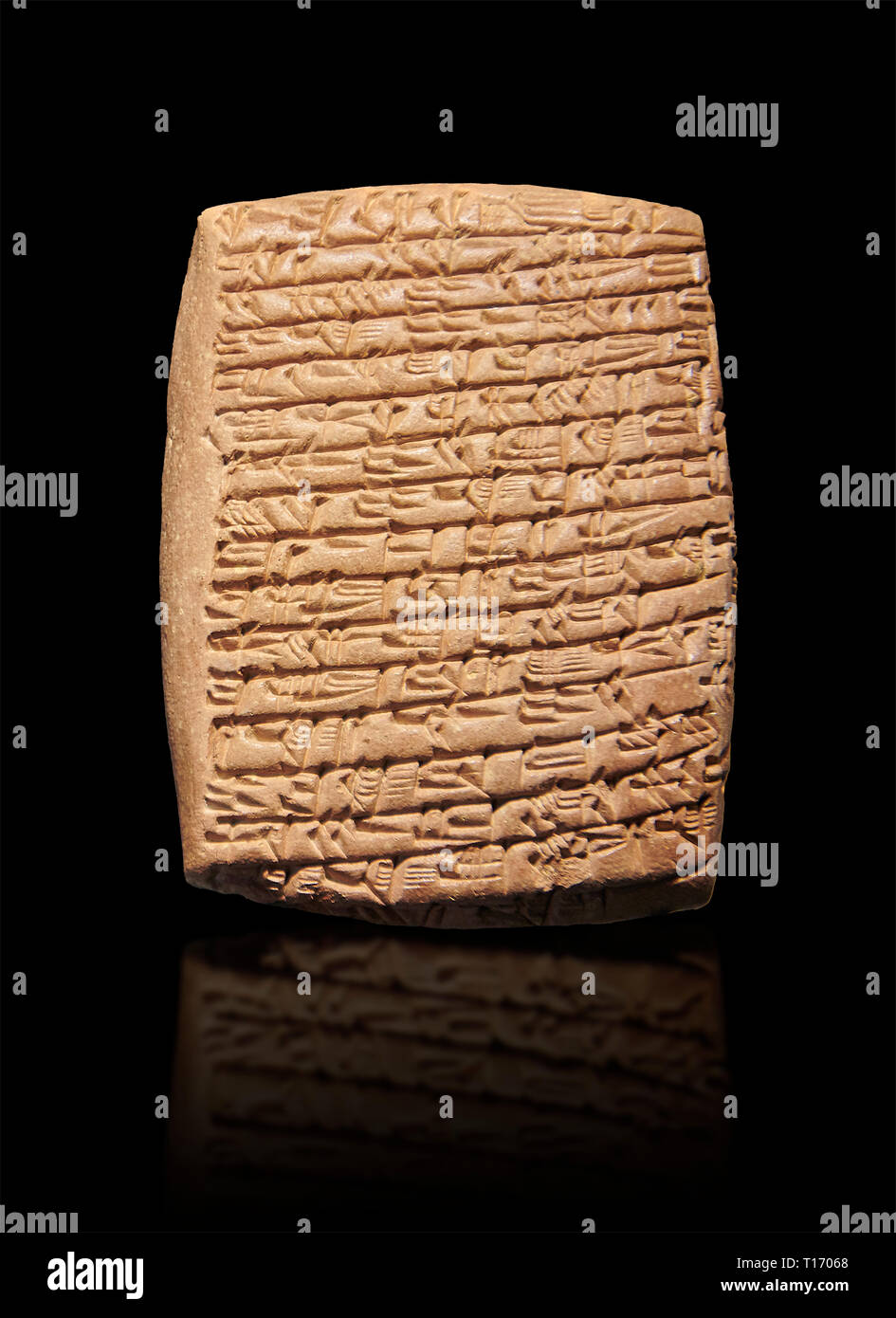 Hittite cuneiform tablet. Adana Archaeology Museum, Turkey. Against a black background Stock Photohttps://www.alamy.com/image-license-details/?v=1https://www.alamy.com/hittite-cuneiform-tablet-adana-archaeology-museum-turkey-against-a-black-background-image241713648.html
Hittite cuneiform tablet. Adana Archaeology Museum, Turkey. Against a black background Stock Photohttps://www.alamy.com/image-license-details/?v=1https://www.alamy.com/hittite-cuneiform-tablet-adana-archaeology-museum-turkey-against-a-black-background-image241713648.htmlRFT17068–Hittite cuneiform tablet. Adana Archaeology Museum, Turkey. Against a black background
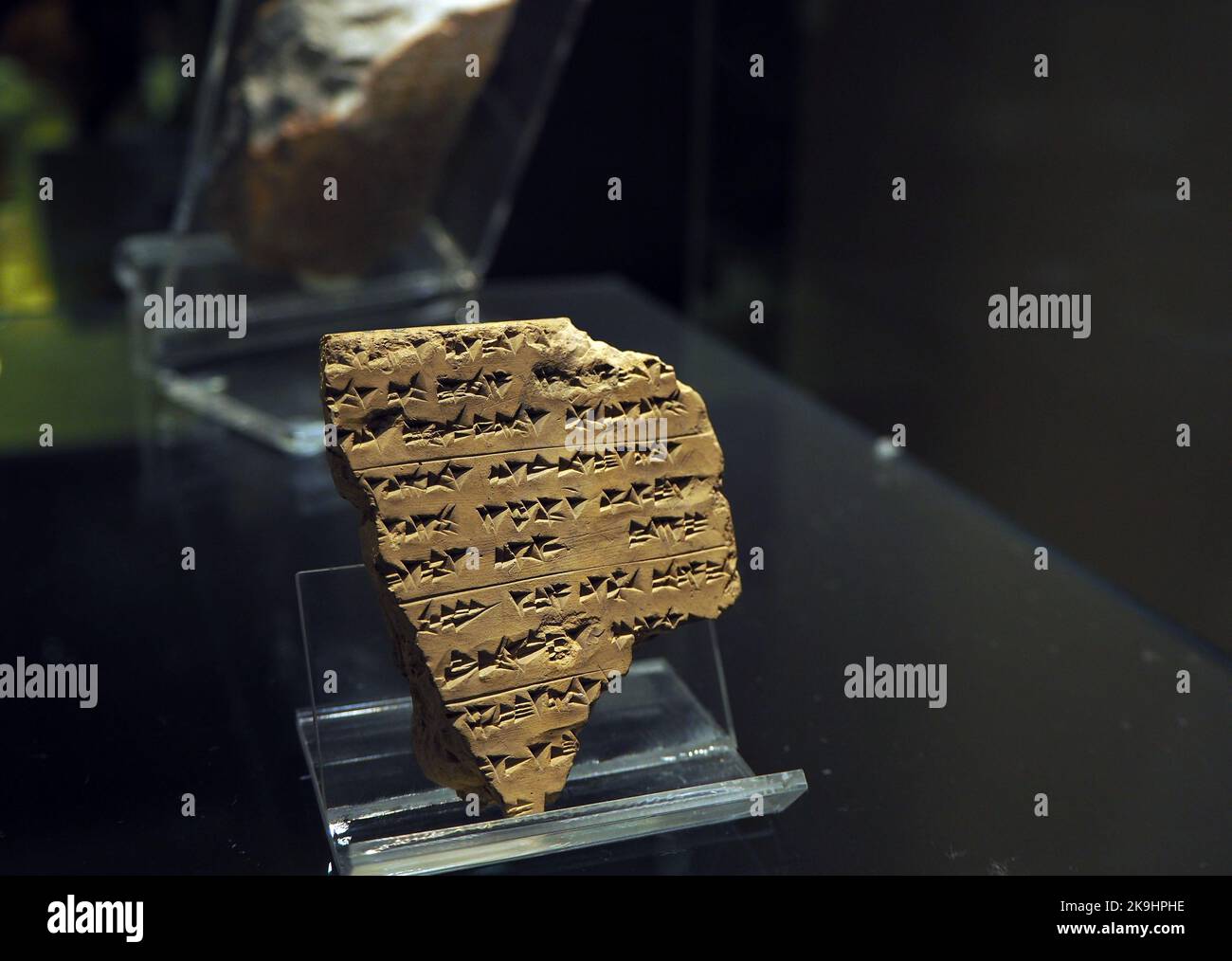 Assyrian cuneiform clay tablets from Kultepe that exhibited at Anatolian Civilizations Museum in Ankara, Türkiye Stock Photohttps://www.alamy.com/image-license-details/?v=1https://www.alamy.com/assyrian-cuneiform-clay-tablets-from-kultepe-that-exhibited-at-anatolian-civilizations-museum-in-ankara-trkiye-image487813130.html
Assyrian cuneiform clay tablets from Kultepe that exhibited at Anatolian Civilizations Museum in Ankara, Türkiye Stock Photohttps://www.alamy.com/image-license-details/?v=1https://www.alamy.com/assyrian-cuneiform-clay-tablets-from-kultepe-that-exhibited-at-anatolian-civilizations-museum-in-ankara-trkiye-image487813130.htmlRF2K9HPHE–Assyrian cuneiform clay tablets from Kultepe that exhibited at Anatolian Civilizations Museum in Ankara, Türkiye
 Worker in a clay tile factory,LA Stock Photohttps://www.alamy.com/image-license-details/?v=1https://www.alamy.com/stock-photo-worker-in-a-clay-tile-factoryla-52383893.html
Worker in a clay tile factory,LA Stock Photohttps://www.alamy.com/image-license-details/?v=1https://www.alamy.com/stock-photo-worker-in-a-clay-tile-factoryla-52383893.htmlRMD16859–Worker in a clay tile factory,LA
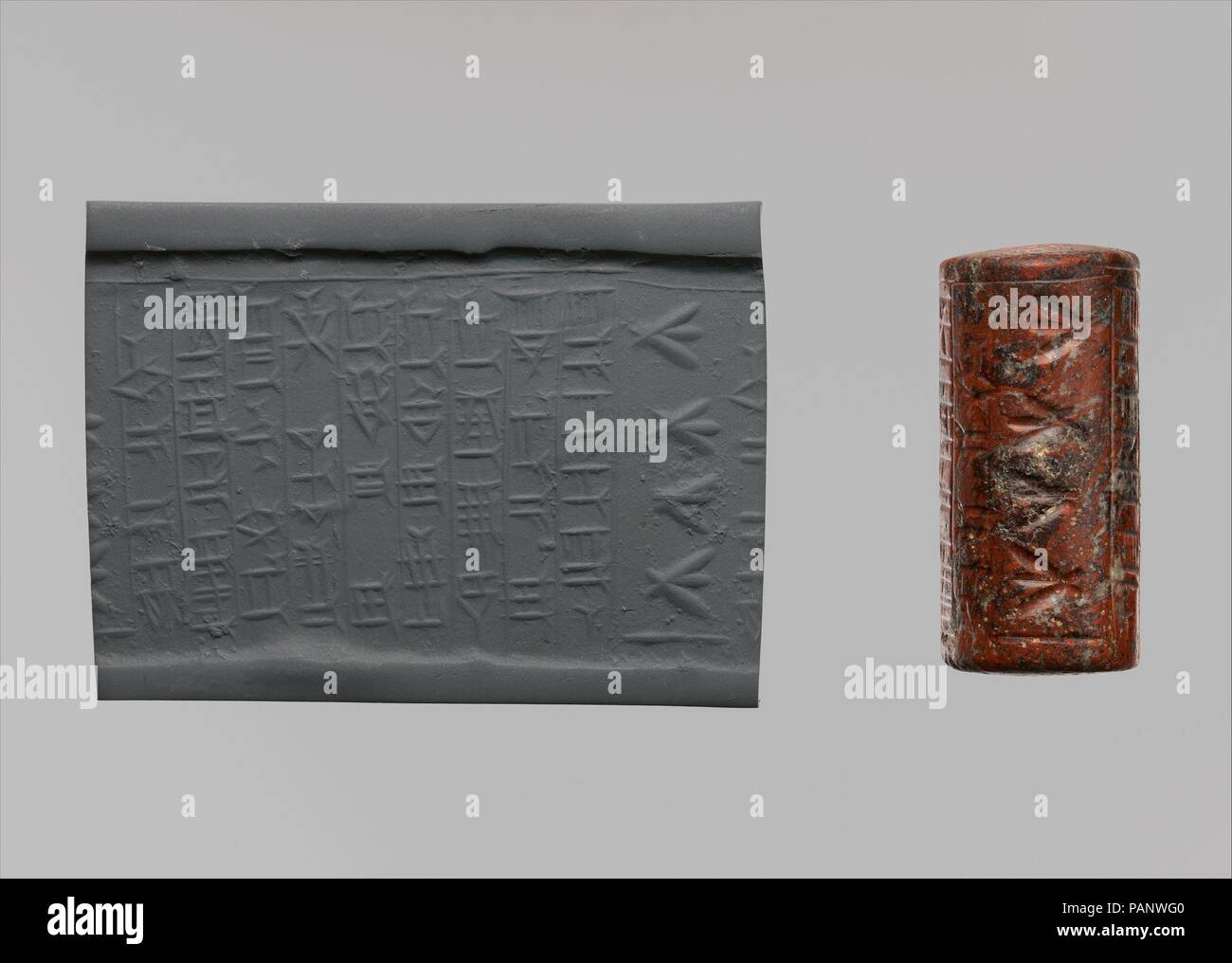 Cylinder seal. Culture: Kassite. Dimensions: 1.54 in. (3.91 cm). Date: ca. 16th-12th century B.C.. Although engraved stones had been used as early as the seventh millennium B.C. to stamp impressions in clay, the invention in the fourth millennium B.C. of carved cylinders that could be rolled over clay allowed the development of more complex seal designs. These cylinder seals, first used in Mesopotamia, served as a mark of ownership or identification. Seals were either impressed on lumps of clay that were used to close jars, doors, and baskets, or they were rolled onto clay tablets that record Stock Photohttps://www.alamy.com/image-license-details/?v=1https://www.alamy.com/cylinder-seal-culture-kassite-dimensions-154-in-391-cm-date-ca-16th-12th-century-bc-although-engraved-stones-had-been-used-as-early-as-the-seventh-millennium-bc-to-stamp-impressions-in-clay-the-invention-in-the-fourth-millennium-bc-of-carved-cylinders-that-could-be-rolled-over-clay-allowed-the-development-of-more-complex-seal-designs-these-cylinder-seals-first-used-in-mesopotamia-served-as-a-mark-of-ownership-or-identification-seals-were-either-impressed-on-lumps-of-clay-that-were-used-to-close-jars-doors-and-baskets-or-they-were-rolled-onto-clay-tablets-that-record-image213152016.html
Cylinder seal. Culture: Kassite. Dimensions: 1.54 in. (3.91 cm). Date: ca. 16th-12th century B.C.. Although engraved stones had been used as early as the seventh millennium B.C. to stamp impressions in clay, the invention in the fourth millennium B.C. of carved cylinders that could be rolled over clay allowed the development of more complex seal designs. These cylinder seals, first used in Mesopotamia, served as a mark of ownership or identification. Seals were either impressed on lumps of clay that were used to close jars, doors, and baskets, or they were rolled onto clay tablets that record Stock Photohttps://www.alamy.com/image-license-details/?v=1https://www.alamy.com/cylinder-seal-culture-kassite-dimensions-154-in-391-cm-date-ca-16th-12th-century-bc-although-engraved-stones-had-been-used-as-early-as-the-seventh-millennium-bc-to-stamp-impressions-in-clay-the-invention-in-the-fourth-millennium-bc-of-carved-cylinders-that-could-be-rolled-over-clay-allowed-the-development-of-more-complex-seal-designs-these-cylinder-seals-first-used-in-mesopotamia-served-as-a-mark-of-ownership-or-identification-seals-were-either-impressed-on-lumps-of-clay-that-were-used-to-close-jars-doors-and-baskets-or-they-were-rolled-onto-clay-tablets-that-record-image213152016.htmlRMPANWG0–Cylinder seal. Culture: Kassite. Dimensions: 1.54 in. (3.91 cm). Date: ca. 16th-12th century B.C.. Although engraved stones had been used as early as the seventh millennium B.C. to stamp impressions in clay, the invention in the fourth millennium B.C. of carved cylinders that could be rolled over clay allowed the development of more complex seal designs. These cylinder seals, first used in Mesopotamia, served as a mark of ownership or identification. Seals were either impressed on lumps of clay that were used to close jars, doors, and baskets, or they were rolled onto clay tablets that record
 Egyptian hieroglyphs and ancient drawings on clay tablets and papyri background. The art of Egypt and the ancient civilizations of Africa. High quality photo Stock Photohttps://www.alamy.com/image-license-details/?v=1https://www.alamy.com/egyptian-hieroglyphs-and-ancient-drawings-on-clay-tablets-and-papyri-background-the-art-of-egypt-and-the-ancient-civilizations-of-africa-high-quality-photo-image452641706.html
Egyptian hieroglyphs and ancient drawings on clay tablets and papyri background. The art of Egypt and the ancient civilizations of Africa. High quality photo Stock Photohttps://www.alamy.com/image-license-details/?v=1https://www.alamy.com/egyptian-hieroglyphs-and-ancient-drawings-on-clay-tablets-and-papyri-background-the-art-of-egypt-and-the-ancient-civilizations-of-africa-high-quality-photo-image452641706.htmlRF2H8BH36–Egyptian hieroglyphs and ancient drawings on clay tablets and papyri background. The art of Egypt and the ancient civilizations of Africa. High quality photo
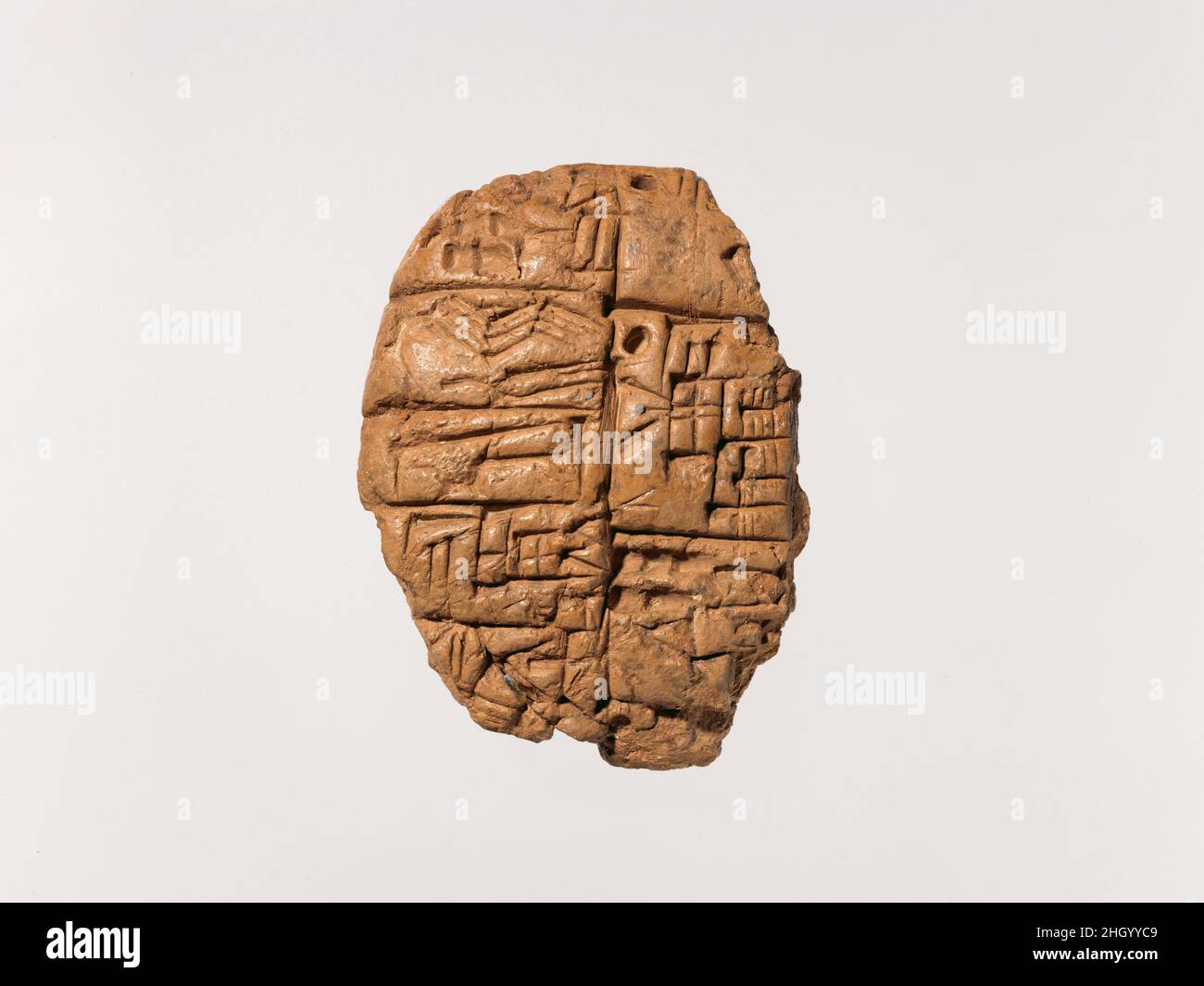 Cuneiform tablet: distribution of copper knives ca. 2600–2350 B.C. The invention of writing in approximately 3300 B.C. was one of many developments in administrative technology--including the use of geometric tokens for counting and cylinder seals to guarantee transactions--that accompanied the growth of the first cities and states in southern Mesopotamia. Proto-cuneiform is the name given to the earliest form of writing--pictograms that were drawn on clay tablets. Gradually, the pictograms became abstracted into cuneiform (Latin, 'wedge-shaped') signs that were impressed rather than drawn. At Stock Photohttps://www.alamy.com/image-license-details/?v=1https://www.alamy.com/cuneiform-tablet-distribution-of-copper-knives-ca-26002350-bc-the-invention-of-writing-in-approximately-3300-bc-was-one-of-many-developments-in-administrative-technology-including-the-use-of-geometric-tokens-for-counting-and-cylinder-seals-to-guarantee-transactions-that-accompanied-the-growth-of-the-first-cities-and-states-in-southern-mesopotamia-proto-cuneiform-is-the-name-given-to-the-earliest-form-of-writing-pictograms-that-were-drawn-on-clay-tablets-gradually-the-pictograms-became-abstracted-into-cuneiform-latin-wedge-shaped-signs-that-were-impressed-rather-than-drawn-at-image457918281.html
Cuneiform tablet: distribution of copper knives ca. 2600–2350 B.C. The invention of writing in approximately 3300 B.C. was one of many developments in administrative technology--including the use of geometric tokens for counting and cylinder seals to guarantee transactions--that accompanied the growth of the first cities and states in southern Mesopotamia. Proto-cuneiform is the name given to the earliest form of writing--pictograms that were drawn on clay tablets. Gradually, the pictograms became abstracted into cuneiform (Latin, 'wedge-shaped') signs that were impressed rather than drawn. At Stock Photohttps://www.alamy.com/image-license-details/?v=1https://www.alamy.com/cuneiform-tablet-distribution-of-copper-knives-ca-26002350-bc-the-invention-of-writing-in-approximately-3300-bc-was-one-of-many-developments-in-administrative-technology-including-the-use-of-geometric-tokens-for-counting-and-cylinder-seals-to-guarantee-transactions-that-accompanied-the-growth-of-the-first-cities-and-states-in-southern-mesopotamia-proto-cuneiform-is-the-name-given-to-the-earliest-form-of-writing-pictograms-that-were-drawn-on-clay-tablets-gradually-the-pictograms-became-abstracted-into-cuneiform-latin-wedge-shaped-signs-that-were-impressed-rather-than-drawn-at-image457918281.htmlRM2HGYYC9–Cuneiform tablet: distribution of copper knives ca. 2600–2350 B.C. The invention of writing in approximately 3300 B.C. was one of many developments in administrative technology--including the use of geometric tokens for counting and cylinder seals to guarantee transactions--that accompanied the growth of the first cities and states in southern Mesopotamia. Proto-cuneiform is the name given to the earliest form of writing--pictograms that were drawn on clay tablets. Gradually, the pictograms became abstracted into cuneiform (Latin, 'wedge-shaped') signs that were impressed rather than drawn. At
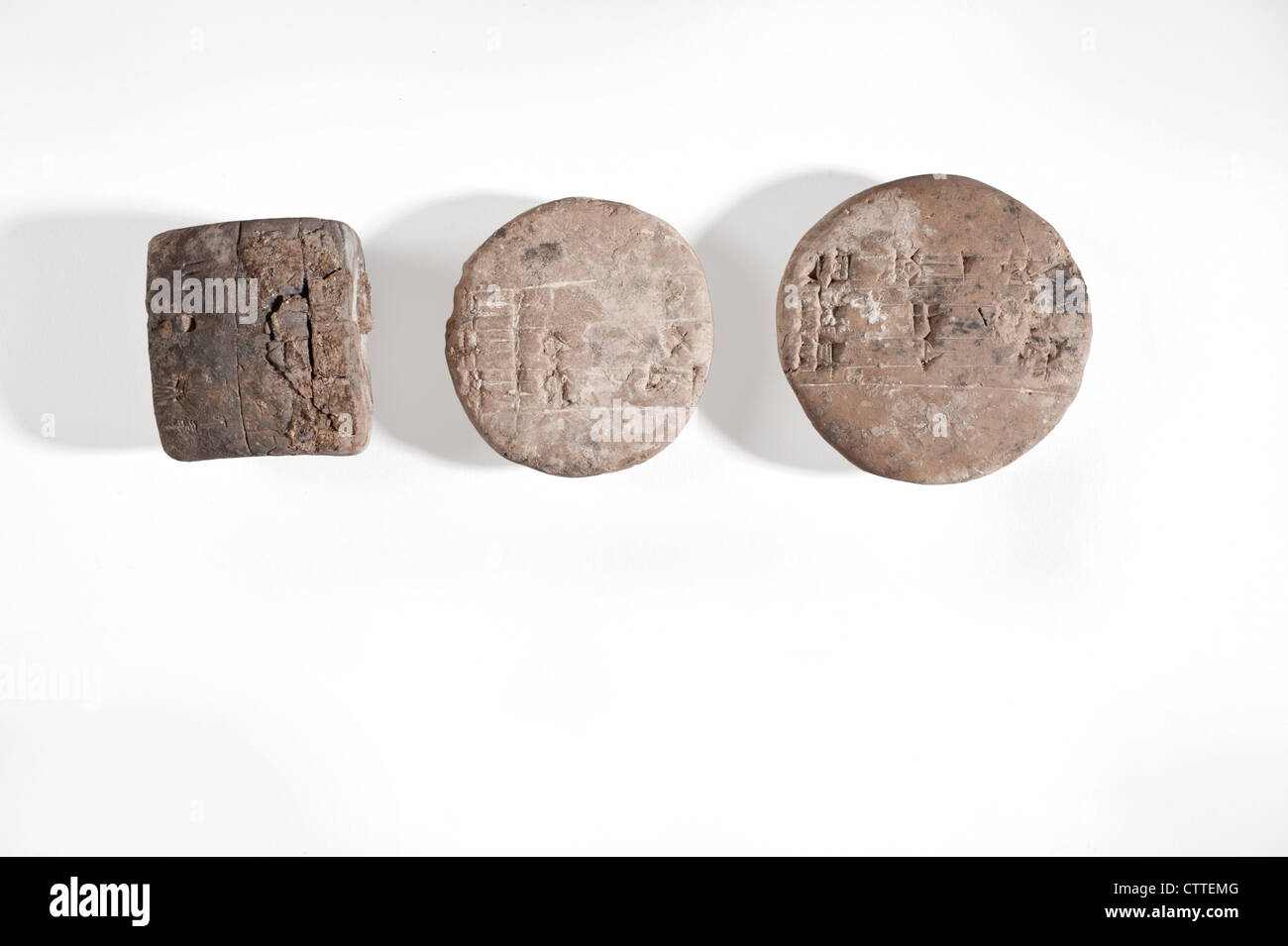 3 pictographic clay tablets with administrative text Uruk Period circa 3000 BCE Stock Photohttps://www.alamy.com/image-license-details/?v=1https://www.alamy.com/stock-photo-3-pictographic-clay-tablets-with-administrative-text-uruk-period-circa-49710880.html
3 pictographic clay tablets with administrative text Uruk Period circa 3000 BCE Stock Photohttps://www.alamy.com/image-license-details/?v=1https://www.alamy.com/stock-photo-3-pictographic-clay-tablets-with-administrative-text-uruk-period-circa-49710880.htmlRMCTTEMG–3 pictographic clay tablets with administrative text Uruk Period circa 3000 BCE
 Local Tibetans making clay offering tablets at a Buddhist temple. Sichuan, China. Stock Photohttps://www.alamy.com/image-license-details/?v=1https://www.alamy.com/stock-photo-local-tibetans-making-clay-offering-tablets-at-a-buddhist-temple-sichuan-38395311.html
Local Tibetans making clay offering tablets at a Buddhist temple. Sichuan, China. Stock Photohttps://www.alamy.com/image-license-details/?v=1https://www.alamy.com/stock-photo-local-tibetans-making-clay-offering-tablets-at-a-buddhist-temple-sichuan-38395311.htmlRMC6D1H3–Local Tibetans making clay offering tablets at a Buddhist temple. Sichuan, China.
 London, England / United Kingdom - 2019/01/28: Ancient Assyria clay tablets with Mesopotamian cuneiform writing from king Ashurbanipal royal library i Stock Photohttps://www.alamy.com/image-license-details/?v=1https://www.alamy.com/london-england-united-kingdom-20190128-ancient-assyria-clay-tablets-with-mesopotamian-cuneiform-writing-from-king-ashurbanipal-royal-library-i-image235510459.html
London, England / United Kingdom - 2019/01/28: Ancient Assyria clay tablets with Mesopotamian cuneiform writing from king Ashurbanipal royal library i Stock Photohttps://www.alamy.com/image-license-details/?v=1https://www.alamy.com/london-england-united-kingdom-20190128-ancient-assyria-clay-tablets-with-mesopotamian-cuneiform-writing-from-king-ashurbanipal-royal-library-i-image235510459.htmlRFRK4BYR–London, England / United Kingdom - 2019/01/28: Ancient Assyria clay tablets with Mesopotamian cuneiform writing from king Ashurbanipal royal library i
 Edinburgh, Scotland, UK; 15 August, 2018. Pictured; Irving Finkel. Finkel is an expert reader of cuneiform inscriptions on clay tablets and a British Museum scholar. His book, 'The Writing in the Stone', is a work of bloodcurdling fiction set in Mesopotamia and inspired by a fractured piece of stone that resembles a cuneiform stone. Credit: Iain Masterton/Alamy Live News Stock Photohttps://www.alamy.com/image-license-details/?v=1https://www.alamy.com/edinburgh-scotland-uk-15-august-2018-pictured-irving-finkel-finkel-is-an-expert-reader-of-cuneiform-inscriptions-on-clay-tablets-and-a-british-museum-scholar-his-book-the-writing-in-the-stone-is-a-work-of-bloodcurdling-fiction-set-in-mesopotamia-and-inspired-by-a-fractured-piece-of-stone-that-resembles-a-cuneiform-stone-credit-iain-mastertonalamy-live-news-image215506552.html
Edinburgh, Scotland, UK; 15 August, 2018. Pictured; Irving Finkel. Finkel is an expert reader of cuneiform inscriptions on clay tablets and a British Museum scholar. His book, 'The Writing in the Stone', is a work of bloodcurdling fiction set in Mesopotamia and inspired by a fractured piece of stone that resembles a cuneiform stone. Credit: Iain Masterton/Alamy Live News Stock Photohttps://www.alamy.com/image-license-details/?v=1https://www.alamy.com/edinburgh-scotland-uk-15-august-2018-pictured-irving-finkel-finkel-is-an-expert-reader-of-cuneiform-inscriptions-on-clay-tablets-and-a-british-museum-scholar-his-book-the-writing-in-the-stone-is-a-work-of-bloodcurdling-fiction-set-in-mesopotamia-and-inspired-by-a-fractured-piece-of-stone-that-resembles-a-cuneiform-stone-credit-iain-mastertonalamy-live-news-image215506552.htmlRMPEH4PG–Edinburgh, Scotland, UK; 15 August, 2018. Pictured; Irving Finkel. Finkel is an expert reader of cuneiform inscriptions on clay tablets and a British Museum scholar. His book, 'The Writing in the Stone', is a work of bloodcurdling fiction set in Mesopotamia and inspired by a fractured piece of stone that resembles a cuneiform stone. Credit: Iain Masterton/Alamy Live News
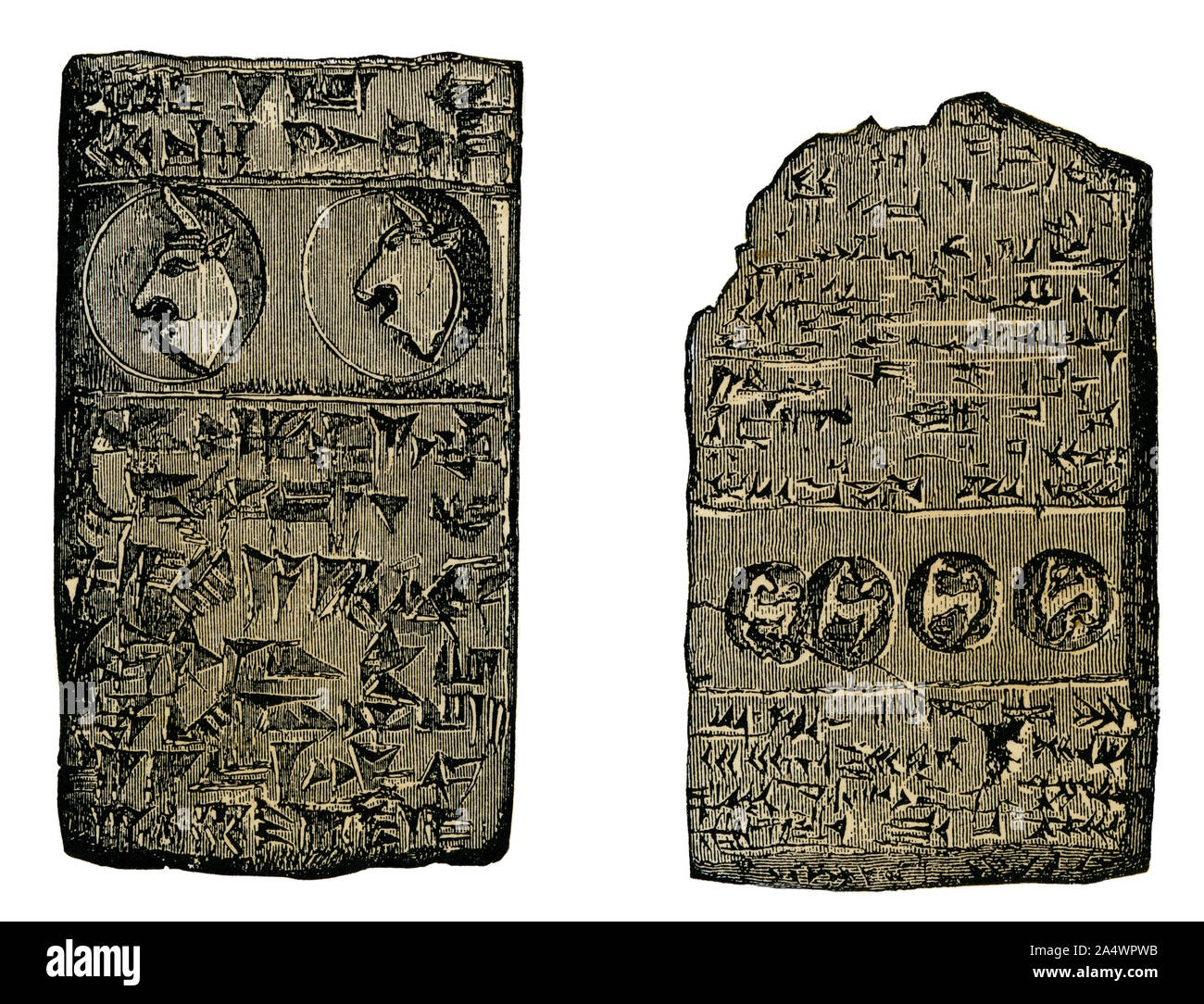 Cuneiform tablets from Chaldea in Babylonia. Hand-colored woodcut Stock Photohttps://www.alamy.com/image-license-details/?v=1https://www.alamy.com/cuneiform-tablets-from-chaldea-in-babylonia-hand-colored-woodcut-image330022375.html
Cuneiform tablets from Chaldea in Babylonia. Hand-colored woodcut Stock Photohttps://www.alamy.com/image-license-details/?v=1https://www.alamy.com/cuneiform-tablets-from-chaldea-in-babylonia-hand-colored-woodcut-image330022375.htmlRM2A4WPWB–Cuneiform tablets from Chaldea in Babylonia. Hand-colored woodcut
 Pile of Leca Ball or Hydroton clay tablets for plant isolated on white background Stock Photohttps://www.alamy.com/image-license-details/?v=1https://www.alamy.com/pile-of-leca-ball-or-hydroton-clay-tablets-for-plant-isolated-on-white-background-image474129295.html
Pile of Leca Ball or Hydroton clay tablets for plant isolated on white background Stock Photohttps://www.alamy.com/image-license-details/?v=1https://www.alamy.com/pile-of-leca-ball-or-hydroton-clay-tablets-for-plant-isolated-on-white-background-image474129295.htmlRF2JFACN3–Pile of Leca Ball or Hydroton clay tablets for plant isolated on white background
 Colorful tablets spilled from a clay pottery Stock Photohttps://www.alamy.com/image-license-details/?v=1https://www.alamy.com/stock-photo-colorful-tablets-spilled-from-a-clay-pottery-56313272.html
Colorful tablets spilled from a clay pottery Stock Photohttps://www.alamy.com/image-license-details/?v=1https://www.alamy.com/stock-photo-colorful-tablets-spilled-from-a-clay-pottery-56313272.htmlRFD7H848–Colorful tablets spilled from a clay pottery
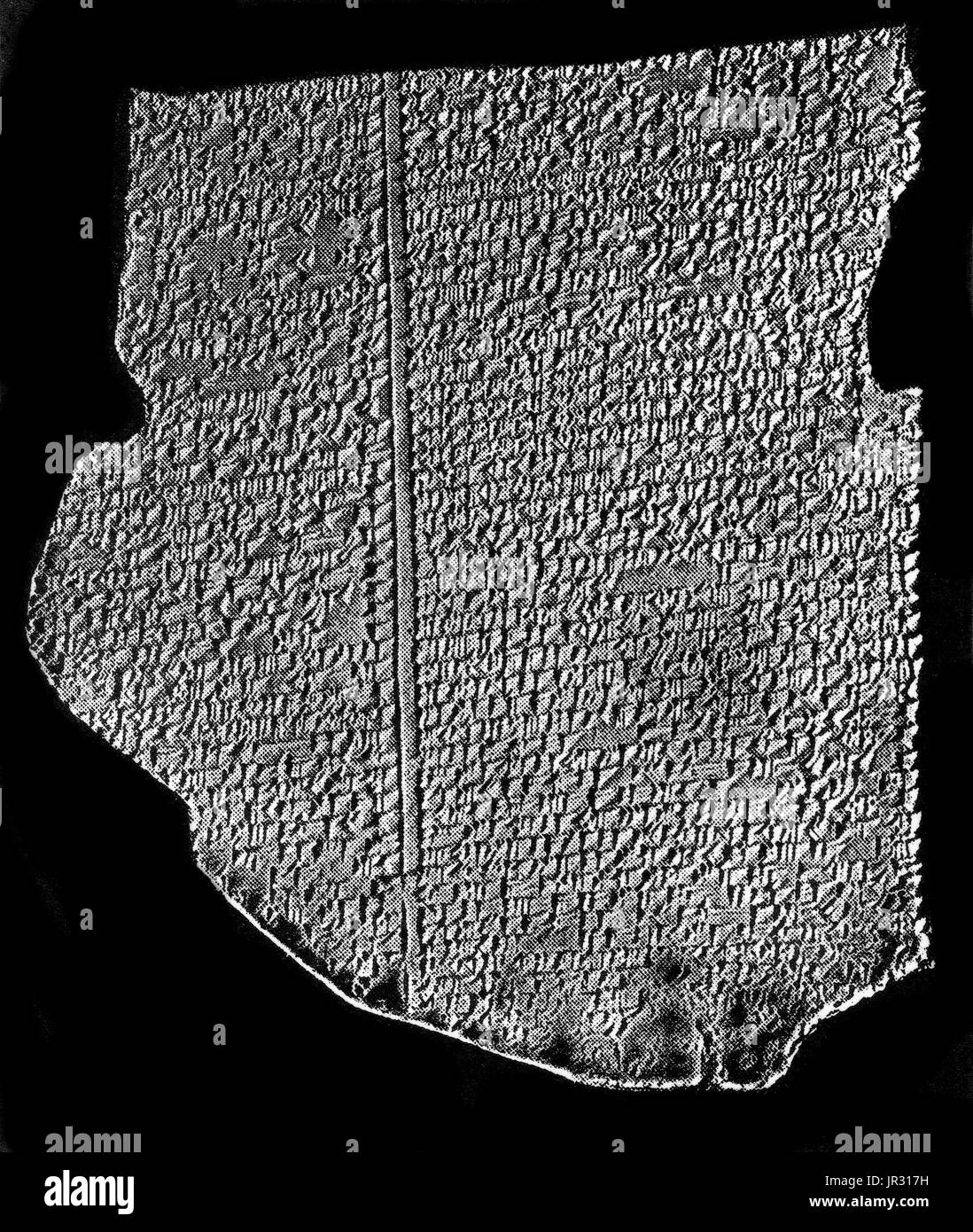 The Amarna tablets are an archive, written on clay tablets, primarily consisting of diplomatic correspondence between the Egyptian administration and its representatives in Canaan and Amurru during the New Kingdom. The Amarna letters are unusual in Egyptological research, because they are mostly written in Akkadian cuneiform, the writing system of ancient Mesopotamia, rather than that of ancient Egypt. The written correspondence spans a period of at most thirty years. The Amarna letters are of great significance for biblical studies as well as Semitic linguistics, since they shed light on the Stock Photohttps://www.alamy.com/image-license-details/?v=1https://www.alamy.com/the-amarna-tablets-are-an-archive-written-on-clay-tablets-primarily-image151886885.html
The Amarna tablets are an archive, written on clay tablets, primarily consisting of diplomatic correspondence between the Egyptian administration and its representatives in Canaan and Amurru during the New Kingdom. The Amarna letters are unusual in Egyptological research, because they are mostly written in Akkadian cuneiform, the writing system of ancient Mesopotamia, rather than that of ancient Egypt. The written correspondence spans a period of at most thirty years. The Amarna letters are of great significance for biblical studies as well as Semitic linguistics, since they shed light on the Stock Photohttps://www.alamy.com/image-license-details/?v=1https://www.alamy.com/the-amarna-tablets-are-an-archive-written-on-clay-tablets-primarily-image151886885.htmlRMJR317H–The Amarna tablets are an archive, written on clay tablets, primarily consisting of diplomatic correspondence between the Egyptian administration and its representatives in Canaan and Amurru during the New Kingdom. The Amarna letters are unusual in Egyptological research, because they are mostly written in Akkadian cuneiform, the writing system of ancient Mesopotamia, rather than that of ancient Egypt. The written correspondence spans a period of at most thirty years. The Amarna letters are of great significance for biblical studies as well as Semitic linguistics, since they shed light on the
 Engraving based on fragmented clay tablets depicting a Babylonian cuneiform table of the phases of the Moon. Dated 20th Century Stock Photohttps://www.alamy.com/image-license-details/?v=1https://www.alamy.com/stock-image-engraving-based-on-fragmented-clay-tablets-depicting-a-babylonian-165996306.html
Engraving based on fragmented clay tablets depicting a Babylonian cuneiform table of the phases of the Moon. Dated 20th Century Stock Photohttps://www.alamy.com/image-license-details/?v=1https://www.alamy.com/stock-image-engraving-based-on-fragmented-clay-tablets-depicting-a-babylonian-165996306.htmlRMKJ1NYE–Engraving based on fragmented clay tablets depicting a Babylonian cuneiform table of the phases of the Moon. Dated 20th Century
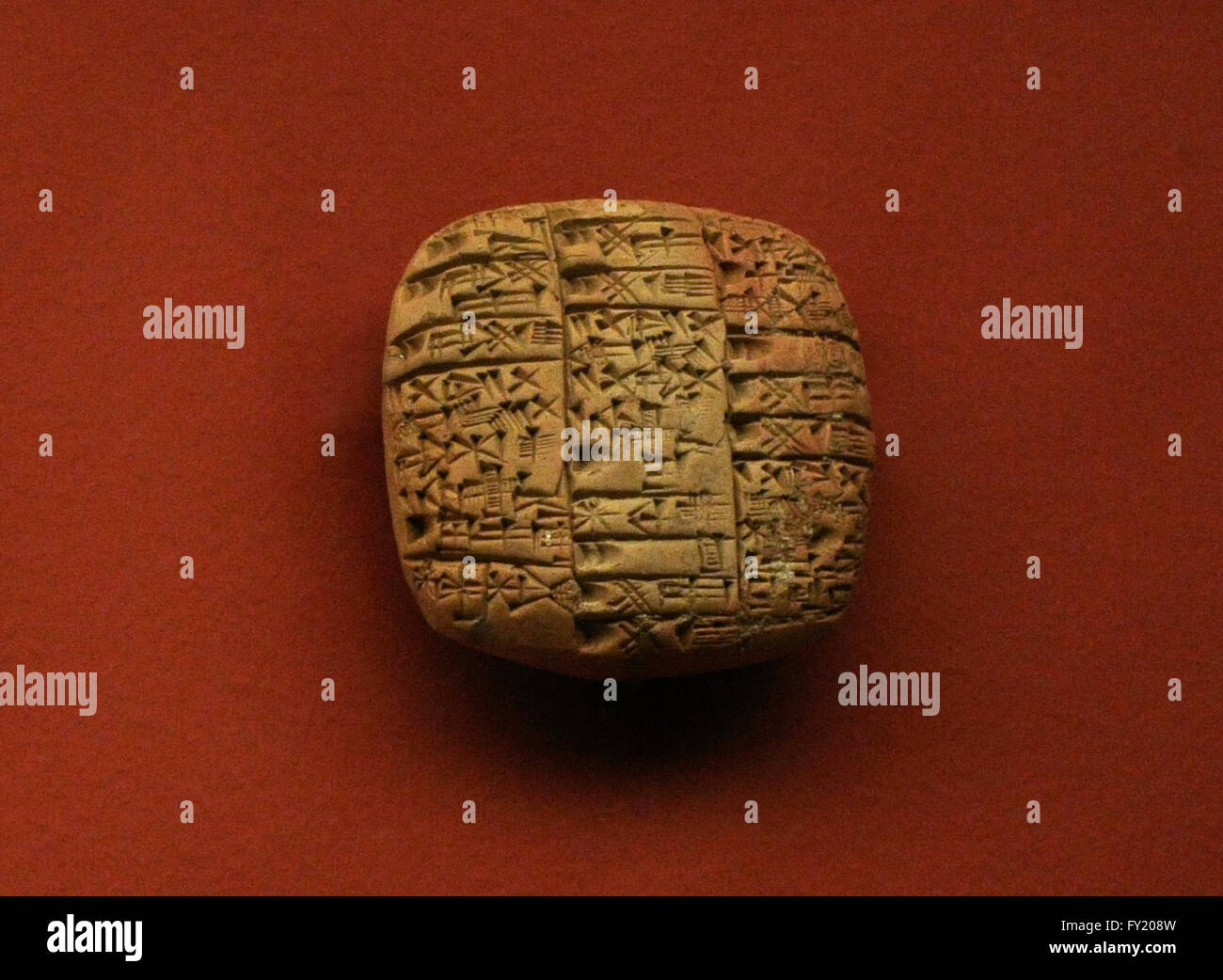 Sumer. Mesopotamia. Near East. Clay tablet. Offerings of flour, beer, butter, fish and cattle to the god Ningirsu and the Goddess Bau, his wife, as well as to other sanctuaries on the festival of the goddess Bau. The State Hermitage Museum. Saint Petersburg. Russia. Stock Photohttps://www.alamy.com/image-license-details/?v=1https://www.alamy.com/stock-photo-sumer-mesopotamia-near-east-clay-tablet-offerings-of-flour-beer-butter-102691705.html
Sumer. Mesopotamia. Near East. Clay tablet. Offerings of flour, beer, butter, fish and cattle to the god Ningirsu and the Goddess Bau, his wife, as well as to other sanctuaries on the festival of the goddess Bau. The State Hermitage Museum. Saint Petersburg. Russia. Stock Photohttps://www.alamy.com/image-license-details/?v=1https://www.alamy.com/stock-photo-sumer-mesopotamia-near-east-clay-tablet-offerings-of-flour-beer-butter-102691705.htmlRMFY208W–Sumer. Mesopotamia. Near East. Clay tablet. Offerings of flour, beer, butter, fish and cattle to the god Ningirsu and the Goddess Bau, his wife, as well as to other sanctuaries on the festival of the goddess Bau. The State Hermitage Museum. Saint Petersburg. Russia.
 Medicines and Vitamins Tablets on a Brown Clay Plate Stock Photohttps://www.alamy.com/image-license-details/?v=1https://www.alamy.com/medicines-and-vitamins-tablets-on-a-brown-clay-plate-image553920224.html
Medicines and Vitamins Tablets on a Brown Clay Plate Stock Photohttps://www.alamy.com/image-license-details/?v=1https://www.alamy.com/medicines-and-vitamins-tablets-on-a-brown-clay-plate-image553920224.htmlRF2R556W4–Medicines and Vitamins Tablets on a Brown Clay Plate
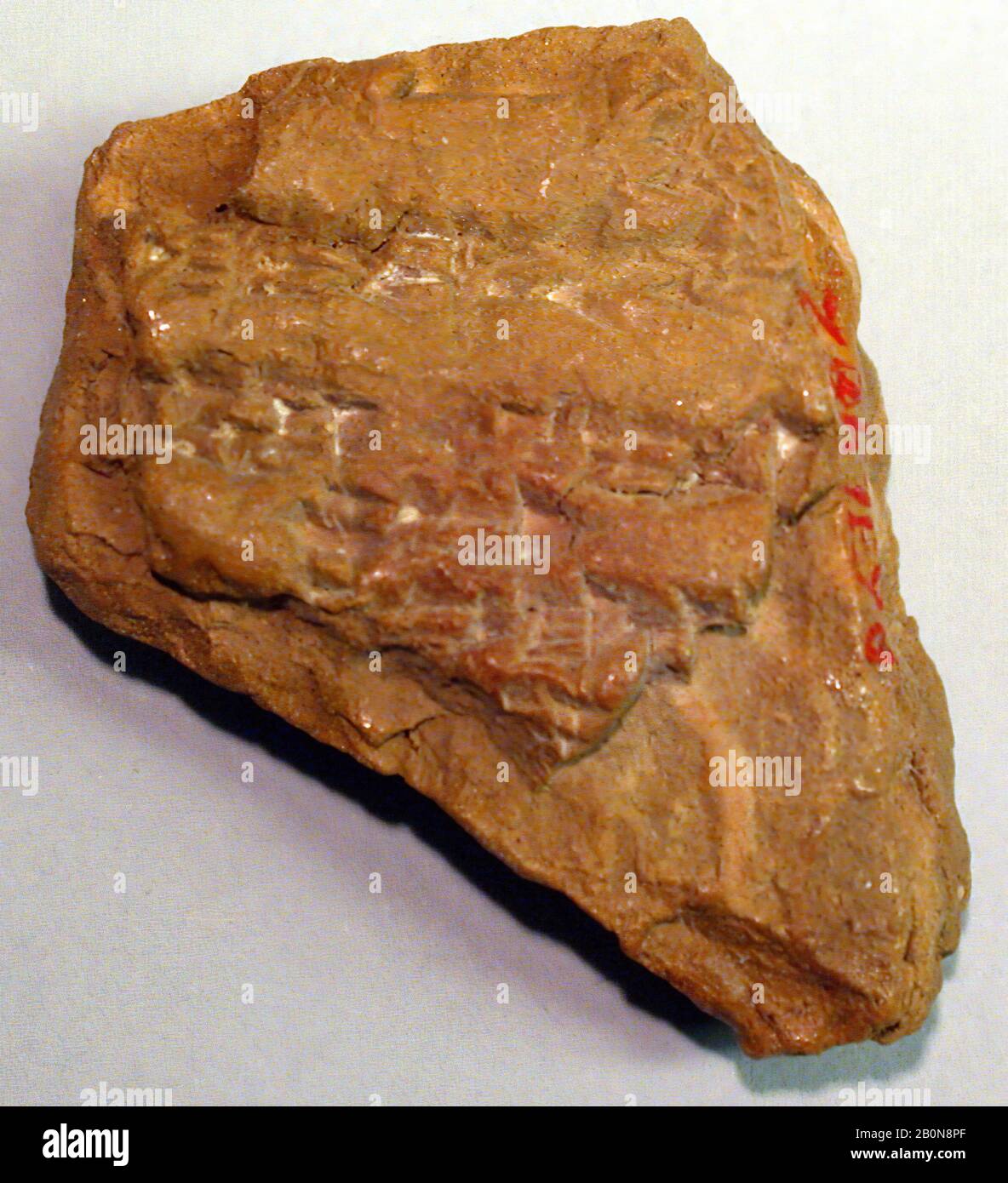 Cuneiform tablet: unidentified fragment, ca. late 1st millennium B.C., Mesopotamia, Clay, 1 5/8 x 1 1/4 x 5/8 in. (4 x 3.3 x 1.5 cm), Clay-Tablets-Inscribed Stock Photohttps://www.alamy.com/image-license-details/?v=1https://www.alamy.com/cuneiform-tablet-unidentified-fragment-ca-late-1st-millennium-bc-mesopotamia-clay-1-58-x-1-14-x-58-in-4-x-33-x-15-cm-clay-tablets-inscribed-image344675255.html
Cuneiform tablet: unidentified fragment, ca. late 1st millennium B.C., Mesopotamia, Clay, 1 5/8 x 1 1/4 x 5/8 in. (4 x 3.3 x 1.5 cm), Clay-Tablets-Inscribed Stock Photohttps://www.alamy.com/image-license-details/?v=1https://www.alamy.com/cuneiform-tablet-unidentified-fragment-ca-late-1st-millennium-bc-mesopotamia-clay-1-58-x-1-14-x-58-in-4-x-33-x-15-cm-clay-tablets-inscribed-image344675255.htmlRM2B0N8PF–Cuneiform tablet: unidentified fragment, ca. late 1st millennium B.C., Mesopotamia, Clay, 1 5/8 x 1 1/4 x 5/8 in. (4 x 3.3 x 1.5 cm), Clay-Tablets-Inscribed
 Art inspired by Cuneiform tablet: fragment of a liver omen, ca. late 1st millennium B.C., Mesopotamia, Clay, 1 x 7/8 x 3/8 in. (2.6 x 2.1 x 0.8 cm), Clay-Tablets-Inscribed, Classic works modernized by Artotop with a splash of modernity. Shapes, color and value, eye-catching visual impact on art. Emotions through freedom of artworks in a contemporary way. A timeless message pursuing a wildly creative new direction. Artists turning to the digital medium and creating the Artotop NFT Stock Photohttps://www.alamy.com/image-license-details/?v=1https://www.alamy.com/art-inspired-by-cuneiform-tablet-fragment-of-a-liver-omen-ca-late-1st-millennium-bc-mesopotamia-clay-1-x-78-x-38-in-26-x-21-x-08-cm-clay-tablets-inscribed-classic-works-modernized-by-artotop-with-a-splash-of-modernity-shapes-color-and-value-eye-catching-visual-impact-on-art-emotions-through-freedom-of-artworks-in-a-contemporary-way-a-timeless-message-pursuing-a-wildly-creative-new-direction-artists-turning-to-the-digital-medium-and-creating-the-artotop-nft-image462944530.html
Art inspired by Cuneiform tablet: fragment of a liver omen, ca. late 1st millennium B.C., Mesopotamia, Clay, 1 x 7/8 x 3/8 in. (2.6 x 2.1 x 0.8 cm), Clay-Tablets-Inscribed, Classic works modernized by Artotop with a splash of modernity. Shapes, color and value, eye-catching visual impact on art. Emotions through freedom of artworks in a contemporary way. A timeless message pursuing a wildly creative new direction. Artists turning to the digital medium and creating the Artotop NFT Stock Photohttps://www.alamy.com/image-license-details/?v=1https://www.alamy.com/art-inspired-by-cuneiform-tablet-fragment-of-a-liver-omen-ca-late-1st-millennium-bc-mesopotamia-clay-1-x-78-x-38-in-26-x-21-x-08-cm-clay-tablets-inscribed-classic-works-modernized-by-artotop-with-a-splash-of-modernity-shapes-color-and-value-eye-catching-visual-impact-on-art-emotions-through-freedom-of-artworks-in-a-contemporary-way-a-timeless-message-pursuing-a-wildly-creative-new-direction-artists-turning-to-the-digital-medium-and-creating-the-artotop-nft-image462944530.htmlRF2HW4XD6–Art inspired by Cuneiform tablet: fragment of a liver omen, ca. late 1st millennium B.C., Mesopotamia, Clay, 1 x 7/8 x 3/8 in. (2.6 x 2.1 x 0.8 cm), Clay-Tablets-Inscribed, Classic works modernized by Artotop with a splash of modernity. Shapes, color and value, eye-catching visual impact on art. Emotions through freedom of artworks in a contemporary way. A timeless message pursuing a wildly creative new direction. Artists turning to the digital medium and creating the Artotop NFT
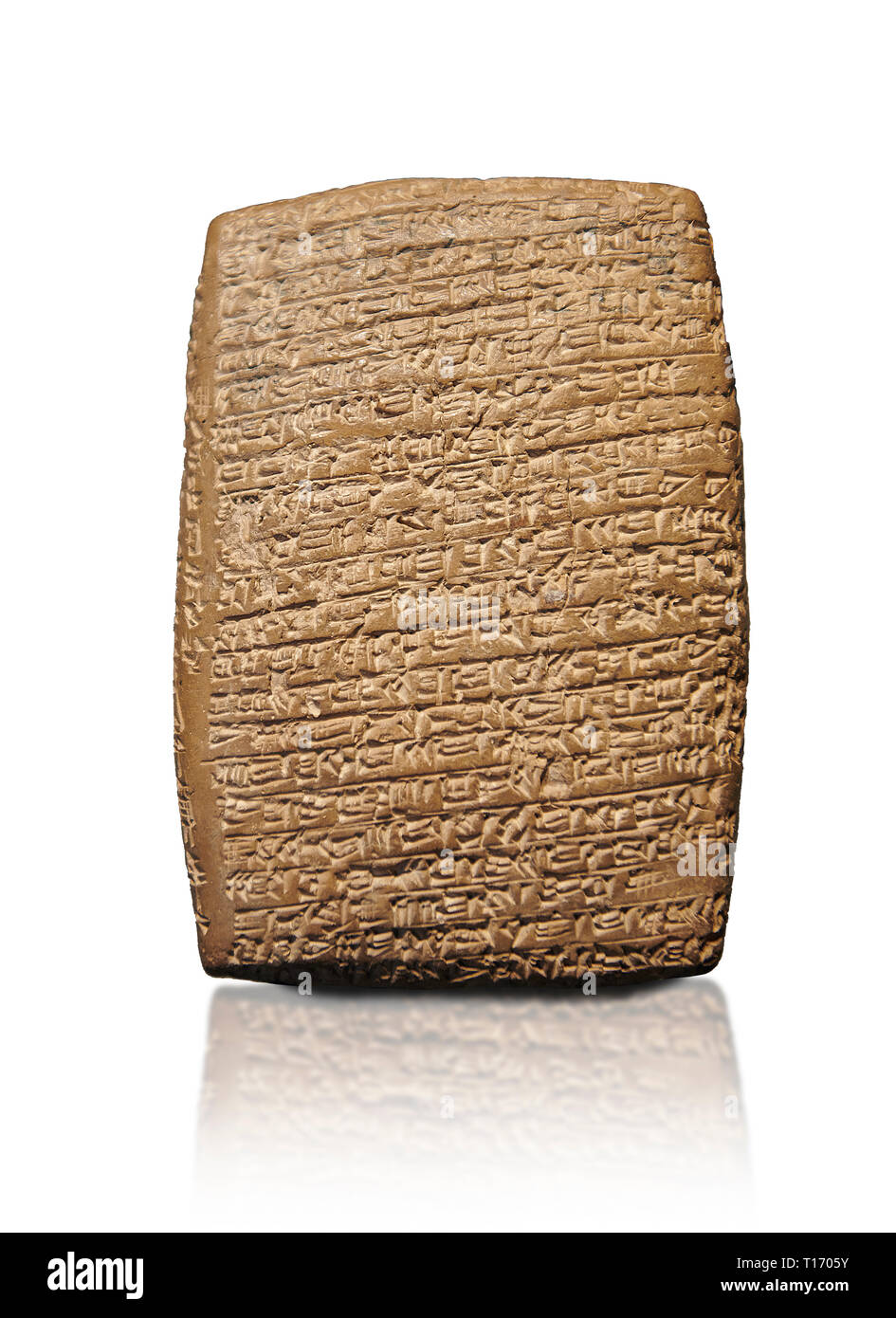 Hittite cuneiform tablet. Adana Archaeology Museum, Turkey. Against a white background Stock Photohttps://www.alamy.com/image-license-details/?v=1https://www.alamy.com/hittite-cuneiform-tablet-adana-archaeology-museum-turkey-against-a-white-background-image241713639.html
Hittite cuneiform tablet. Adana Archaeology Museum, Turkey. Against a white background Stock Photohttps://www.alamy.com/image-license-details/?v=1https://www.alamy.com/hittite-cuneiform-tablet-adana-archaeology-museum-turkey-against-a-white-background-image241713639.htmlRFT1705Y–Hittite cuneiform tablet. Adana Archaeology Museum, Turkey. Against a white background
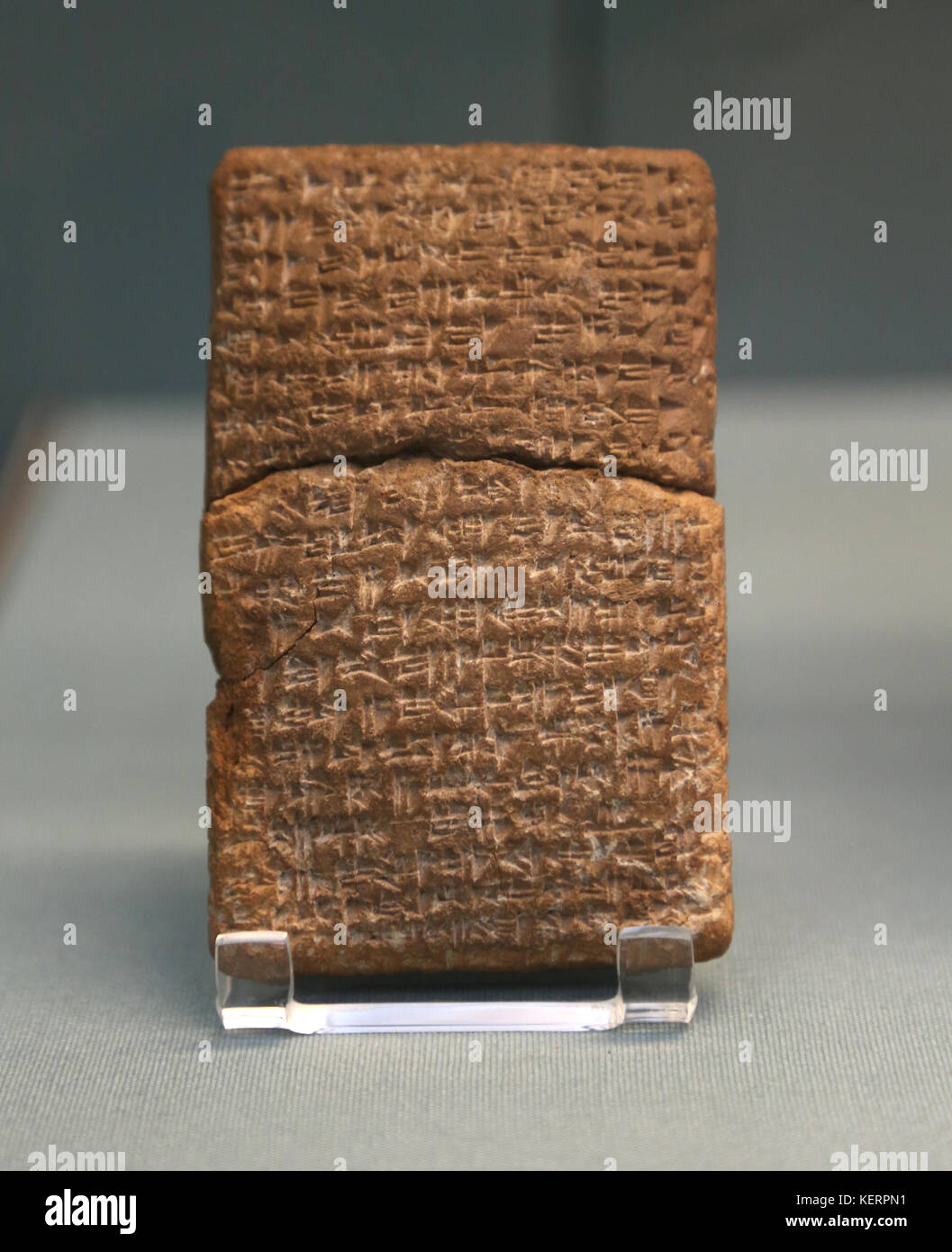 Treaty concerning fugitive slaves. 1480 BC, Hittite. From Atchana. South-eastern Turkey. Clay tablet. British Museum. London. GBR. Stock Photohttps://www.alamy.com/image-license-details/?v=1https://www.alamy.com/stock-image-treaty-concerning-fugitive-slaves-1480-bc-hittite-from-atchana-south-164021229.html
Treaty concerning fugitive slaves. 1480 BC, Hittite. From Atchana. South-eastern Turkey. Clay tablet. British Museum. London. GBR. Stock Photohttps://www.alamy.com/image-license-details/?v=1https://www.alamy.com/stock-image-treaty-concerning-fugitive-slaves-1480-bc-hittite-from-atchana-south-164021229.htmlRMKERPN1–Treaty concerning fugitive slaves. 1480 BC, Hittite. From Atchana. South-eastern Turkey. Clay tablet. British Museum. London. GBR.
 Worker in a clay tile factory,LA Stock Photohttps://www.alamy.com/image-license-details/?v=1https://www.alamy.com/stock-photo-worker-in-a-clay-tile-factoryla-52383927.html
Worker in a clay tile factory,LA Stock Photohttps://www.alamy.com/image-license-details/?v=1https://www.alamy.com/stock-photo-worker-in-a-clay-tile-factoryla-52383927.htmlRMD1686F–Worker in a clay tile factory,LA
 Cylinder seal. Culture: Kassite. Dimensions: 1.35 in. (3.43 cm). Date: ca. 16th-12th century B.C.. Although engraved stones had been used as early as the seventh millennium B.C. to stamp impressions in clay, the invention in the fourth millennium B.C. of carved cylinders that could be rolled over clay allowed the development of more complex seal designs. These cylinder seals, first used in Mesopotamia, served as a mark of ownership or identification. Seals were either impressed on lumps of clay that were used to close jars, doors, and baskets, or they were rolled onto clay tablets that record Stock Photohttps://www.alamy.com/image-license-details/?v=1https://www.alamy.com/cylinder-seal-culture-kassite-dimensions-135-in-343-cm-date-ca-16th-12th-century-bc-although-engraved-stones-had-been-used-as-early-as-the-seventh-millennium-bc-to-stamp-impressions-in-clay-the-invention-in-the-fourth-millennium-bc-of-carved-cylinders-that-could-be-rolled-over-clay-allowed-the-development-of-more-complex-seal-designs-these-cylinder-seals-first-used-in-mesopotamia-served-as-a-mark-of-ownership-or-identification-seals-were-either-impressed-on-lumps-of-clay-that-were-used-to-close-jars-doors-and-baskets-or-they-were-rolled-onto-clay-tablets-that-record-image213162482.html
Cylinder seal. Culture: Kassite. Dimensions: 1.35 in. (3.43 cm). Date: ca. 16th-12th century B.C.. Although engraved stones had been used as early as the seventh millennium B.C. to stamp impressions in clay, the invention in the fourth millennium B.C. of carved cylinders that could be rolled over clay allowed the development of more complex seal designs. These cylinder seals, first used in Mesopotamia, served as a mark of ownership or identification. Seals were either impressed on lumps of clay that were used to close jars, doors, and baskets, or they were rolled onto clay tablets that record Stock Photohttps://www.alamy.com/image-license-details/?v=1https://www.alamy.com/cylinder-seal-culture-kassite-dimensions-135-in-343-cm-date-ca-16th-12th-century-bc-although-engraved-stones-had-been-used-as-early-as-the-seventh-millennium-bc-to-stamp-impressions-in-clay-the-invention-in-the-fourth-millennium-bc-of-carved-cylinders-that-could-be-rolled-over-clay-allowed-the-development-of-more-complex-seal-designs-these-cylinder-seals-first-used-in-mesopotamia-served-as-a-mark-of-ownership-or-identification-seals-were-either-impressed-on-lumps-of-clay-that-were-used-to-close-jars-doors-and-baskets-or-they-were-rolled-onto-clay-tablets-that-record-image213162482.htmlRMPAPAWP–Cylinder seal. Culture: Kassite. Dimensions: 1.35 in. (3.43 cm). Date: ca. 16th-12th century B.C.. Although engraved stones had been used as early as the seventh millennium B.C. to stamp impressions in clay, the invention in the fourth millennium B.C. of carved cylinders that could be rolled over clay allowed the development of more complex seal designs. These cylinder seals, first used in Mesopotamia, served as a mark of ownership or identification. Seals were either impressed on lumps of clay that were used to close jars, doors, and baskets, or they were rolled onto clay tablets that record
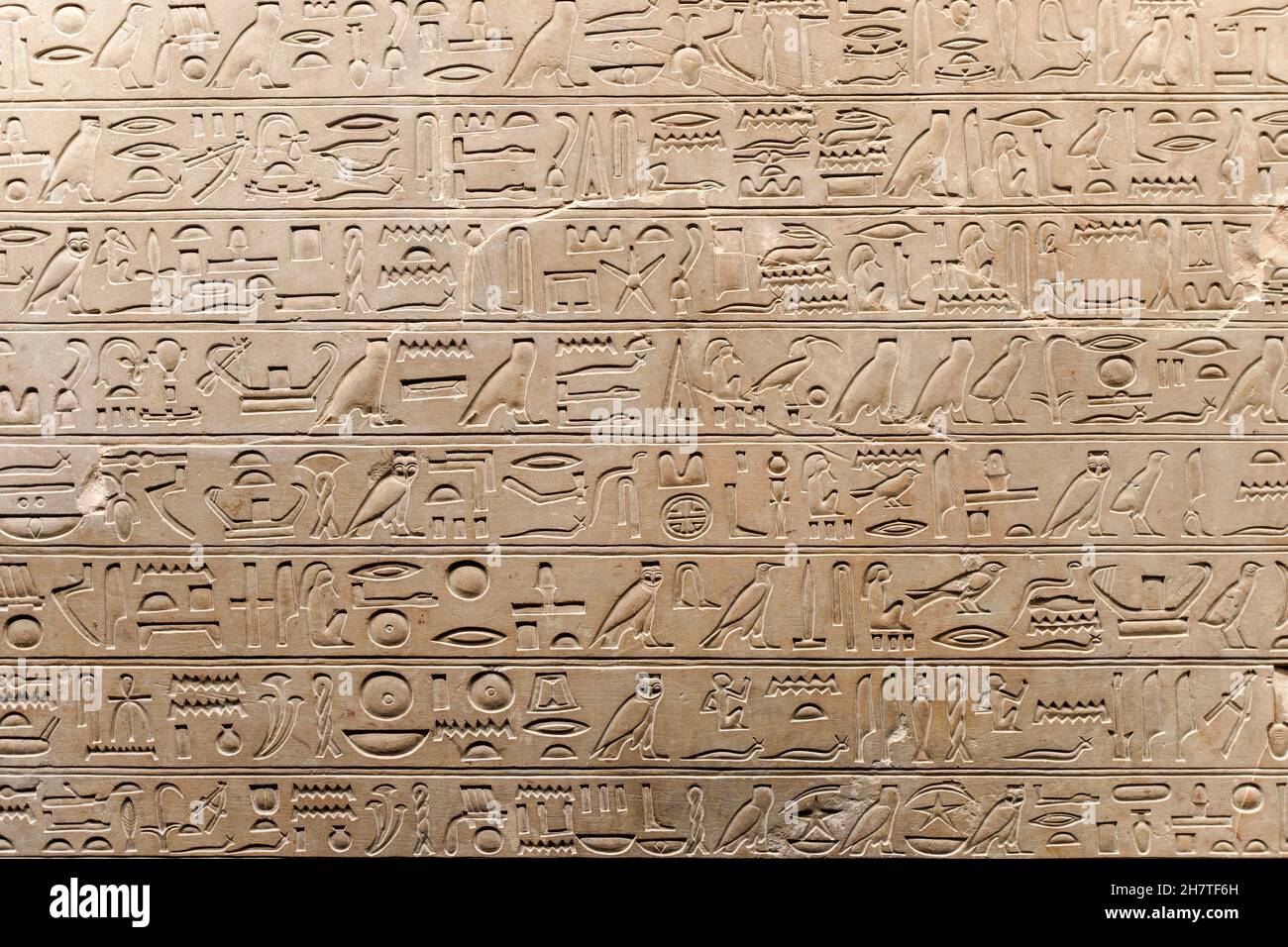 Egyptian hieroglyphs and ancient drawings on clay tablets and papyri background. The art of Egypt and the ancient civilizations of Africa. High quality photo Stock Photohttps://www.alamy.com/image-license-details/?v=1https://www.alamy.com/egyptian-hieroglyphs-and-ancient-drawings-on-clay-tablets-and-papyri-background-the-art-of-egypt-and-the-ancient-civilizations-of-africa-high-quality-photo-image452310953.html
Egyptian hieroglyphs and ancient drawings on clay tablets and papyri background. The art of Egypt and the ancient civilizations of Africa. High quality photo Stock Photohttps://www.alamy.com/image-license-details/?v=1https://www.alamy.com/egyptian-hieroglyphs-and-ancient-drawings-on-clay-tablets-and-papyri-background-the-art-of-egypt-and-the-ancient-civilizations-of-africa-high-quality-photo-image452310953.htmlRF2H7TF6H–Egyptian hieroglyphs and ancient drawings on clay tablets and papyri background. The art of Egypt and the ancient civilizations of Africa. High quality photo
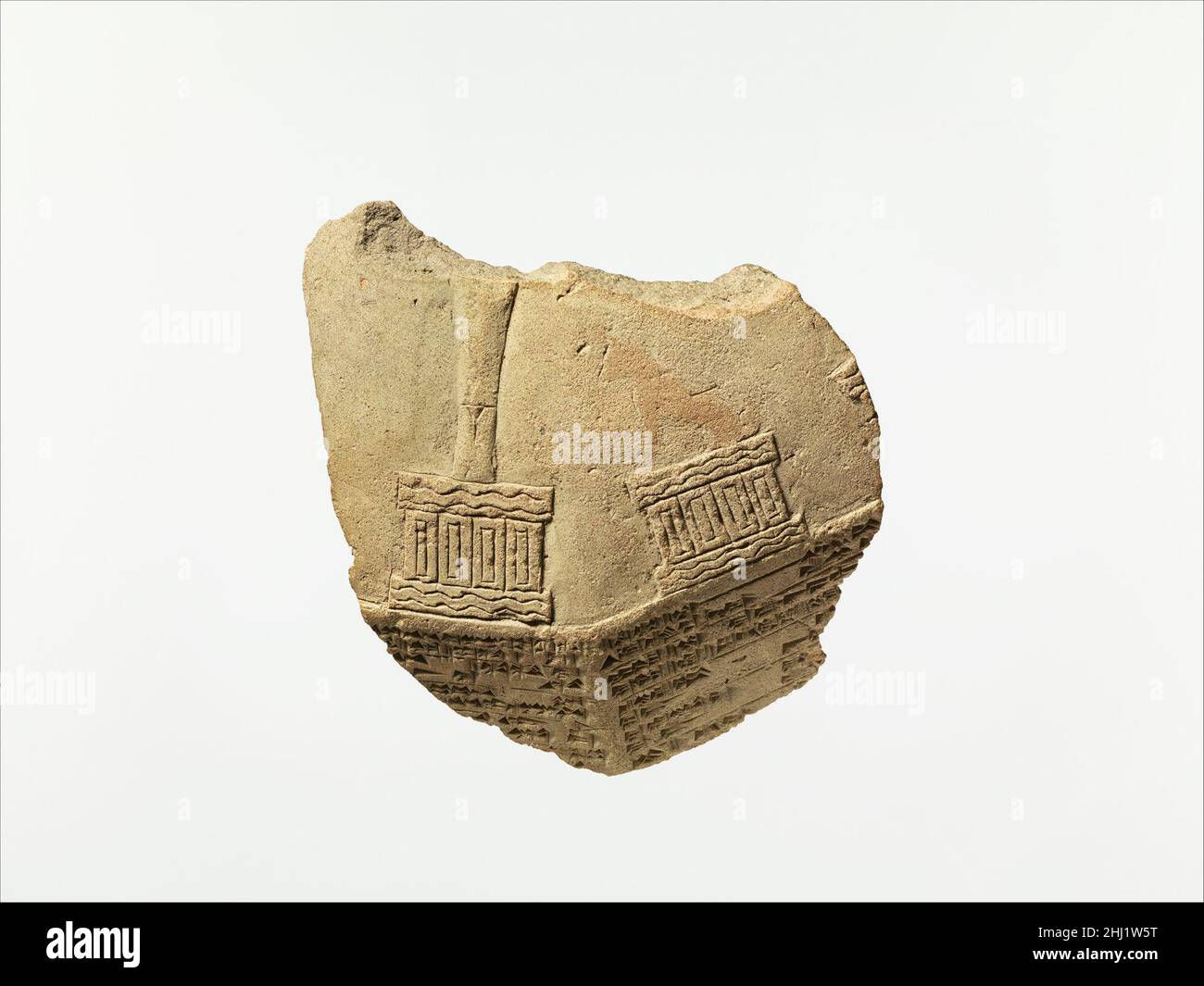 Corner fragment of inscribed prism (kudurru) ca. 7th–6th century B.C. Babylonian The invention of writing in approximately 3300 B.C. was one of many developments in administrative technology--including the use of geometric tokens for counting and cylinder seals to guarantee transactions--that accompanied the growth of the first cities and states in southern Mesopotamia. Proto-cuneiform is the name given to the earliest form of writing--pictograms that were drawn on clay tablets. Gradually, the pictograms became abstracted into cuneiform (Latin, 'wedge-shaped') signs that were impressed rather Stock Photohttps://www.alamy.com/image-license-details/?v=1https://www.alamy.com/corner-fragment-of-inscribed-prism-kudurru-ca-7th6th-century-bc-babylonian-the-invention-of-writing-in-approximately-3300-bc-was-one-of-many-developments-in-administrative-technology-including-the-use-of-geometric-tokens-for-counting-and-cylinder-seals-to-guarantee-transactions-that-accompanied-the-growth-of-the-first-cities-and-states-in-southern-mesopotamia-proto-cuneiform-is-the-name-given-to-the-earliest-form-of-writing-pictograms-that-were-drawn-on-clay-tablets-gradually-the-pictograms-became-abstracted-into-cuneiform-latin-wedge-shaped-signs-that-were-impressed-rather-image458575092.html
Corner fragment of inscribed prism (kudurru) ca. 7th–6th century B.C. Babylonian The invention of writing in approximately 3300 B.C. was one of many developments in administrative technology--including the use of geometric tokens for counting and cylinder seals to guarantee transactions--that accompanied the growth of the first cities and states in southern Mesopotamia. Proto-cuneiform is the name given to the earliest form of writing--pictograms that were drawn on clay tablets. Gradually, the pictograms became abstracted into cuneiform (Latin, 'wedge-shaped') signs that were impressed rather Stock Photohttps://www.alamy.com/image-license-details/?v=1https://www.alamy.com/corner-fragment-of-inscribed-prism-kudurru-ca-7th6th-century-bc-babylonian-the-invention-of-writing-in-approximately-3300-bc-was-one-of-many-developments-in-administrative-technology-including-the-use-of-geometric-tokens-for-counting-and-cylinder-seals-to-guarantee-transactions-that-accompanied-the-growth-of-the-first-cities-and-states-in-southern-mesopotamia-proto-cuneiform-is-the-name-given-to-the-earliest-form-of-writing-pictograms-that-were-drawn-on-clay-tablets-gradually-the-pictograms-became-abstracted-into-cuneiform-latin-wedge-shaped-signs-that-were-impressed-rather-image458575092.htmlRM2HJ1W5T–Corner fragment of inscribed prism (kudurru) ca. 7th–6th century B.C. Babylonian The invention of writing in approximately 3300 B.C. was one of many developments in administrative technology--including the use of geometric tokens for counting and cylinder seals to guarantee transactions--that accompanied the growth of the first cities and states in southern Mesopotamia. Proto-cuneiform is the name given to the earliest form of writing--pictograms that were drawn on clay tablets. Gradually, the pictograms became abstracted into cuneiform (Latin, 'wedge-shaped') signs that were impressed rather
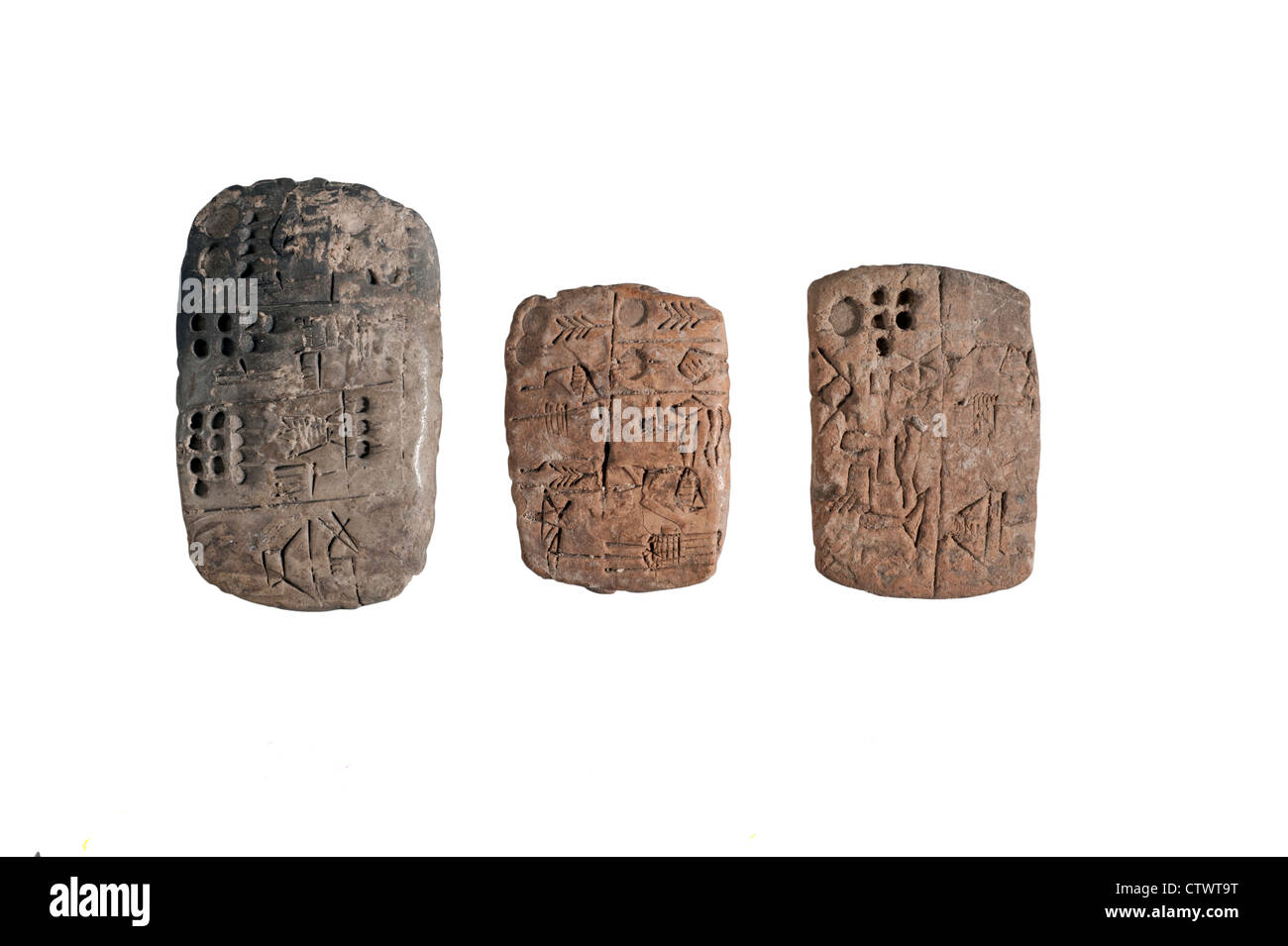 3 pictographic clay tablets with administrative text Uruk Period circa 3000 BCE (private collection) Stock Photohttps://www.alamy.com/image-license-details/?v=1https://www.alamy.com/stock-photo-3-pictographic-clay-tablets-with-administrative-text-uruk-period-circa-49740372.html
3 pictographic clay tablets with administrative text Uruk Period circa 3000 BCE (private collection) Stock Photohttps://www.alamy.com/image-license-details/?v=1https://www.alamy.com/stock-photo-3-pictographic-clay-tablets-with-administrative-text-uruk-period-circa-49740372.htmlRMCTWT9T–3 pictographic clay tablets with administrative text Uruk Period circa 3000 BCE (private collection)
 Handmade clay offering tablets with Buddha figures lying dry in sun. Sichuan, China. Stock Photohttps://www.alamy.com/image-license-details/?v=1https://www.alamy.com/stock-photo-handmade-clay-offering-tablets-with-buddha-figures-lying-dry-in-sun-38395326.html
Handmade clay offering tablets with Buddha figures lying dry in sun. Sichuan, China. Stock Photohttps://www.alamy.com/image-license-details/?v=1https://www.alamy.com/stock-photo-handmade-clay-offering-tablets-with-buddha-figures-lying-dry-in-sun-38395326.htmlRMC6D1HJ–Handmade clay offering tablets with Buddha figures lying dry in sun. Sichuan, China.
 Fragmentary clay brick with Cuneiform inscription. 2nd Millennium BCE Stock Photohttps://www.alamy.com/image-license-details/?v=1https://www.alamy.com/stock-photo-fragmentary-clay-brick-with-cuneiform-inscription-2nd-millennium-bce-49395521.html
Fragmentary clay brick with Cuneiform inscription. 2nd Millennium BCE Stock Photohttps://www.alamy.com/image-license-details/?v=1https://www.alamy.com/stock-photo-fragmentary-clay-brick-with-cuneiform-inscription-2nd-millennium-bce-49395521.htmlRMCTA4DN–Fragmentary clay brick with Cuneiform inscription. 2nd Millennium BCE
 Basqal, Ismayilli region, Azerbaijan - April 30, 2019. Clay turbah tablets with prayer beads. Turbah is a small piece of soil or clay, often a clay ta Stock Photohttps://www.alamy.com/image-license-details/?v=1https://www.alamy.com/basqal-ismayilli-region-azerbaijan-april-30-2019-clay-turbah-tablets-with-prayer-beads-turbah-is-a-small-piece-of-soil-or-clay-often-a-clay-ta-image262802308.html
Basqal, Ismayilli region, Azerbaijan - April 30, 2019. Clay turbah tablets with prayer beads. Turbah is a small piece of soil or clay, often a clay ta Stock Photohttps://www.alamy.com/image-license-details/?v=1https://www.alamy.com/basqal-ismayilli-region-azerbaijan-april-30-2019-clay-turbah-tablets-with-prayer-beads-turbah-is-a-small-piece-of-soil-or-clay-often-a-clay-ta-image262802308.htmlRFW7FK0M–Basqal, Ismayilli region, Azerbaijan - April 30, 2019. Clay turbah tablets with prayer beads. Turbah is a small piece of soil or clay, often a clay ta
 Istanbul, Turkey - January 01, 2021: Clay tablets with cuneiform writing at the ancient orient museum of the Archaeological museum Stock Photohttps://www.alamy.com/image-license-details/?v=1https://www.alamy.com/istanbul-turkey-january-01-2021-clay-tablets-with-cuneiform-writing-at-the-ancient-orient-museum-of-the-archaeological-museum-image438983938.html
Istanbul, Turkey - January 01, 2021: Clay tablets with cuneiform writing at the ancient orient museum of the Archaeological museum Stock Photohttps://www.alamy.com/image-license-details/?v=1https://www.alamy.com/istanbul-turkey-january-01-2021-clay-tablets-with-cuneiform-writing-at-the-ancient-orient-museum-of-the-archaeological-museum-image438983938.htmlRF2GE5CDP–Istanbul, Turkey - January 01, 2021: Clay tablets with cuneiform writing at the ancient orient museum of the Archaeological museum
 Pile of Leca Ball or Hydroton clay tablets for plant isolated on white background Stock Photohttps://www.alamy.com/image-license-details/?v=1https://www.alamy.com/pile-of-leca-ball-or-hydroton-clay-tablets-for-plant-isolated-on-white-background-image474129456.html
Pile of Leca Ball or Hydroton clay tablets for plant isolated on white background Stock Photohttps://www.alamy.com/image-license-details/?v=1https://www.alamy.com/pile-of-leca-ball-or-hydroton-clay-tablets-for-plant-isolated-on-white-background-image474129456.htmlRF2JFACXT–Pile of Leca Ball or Hydroton clay tablets for plant isolated on white background
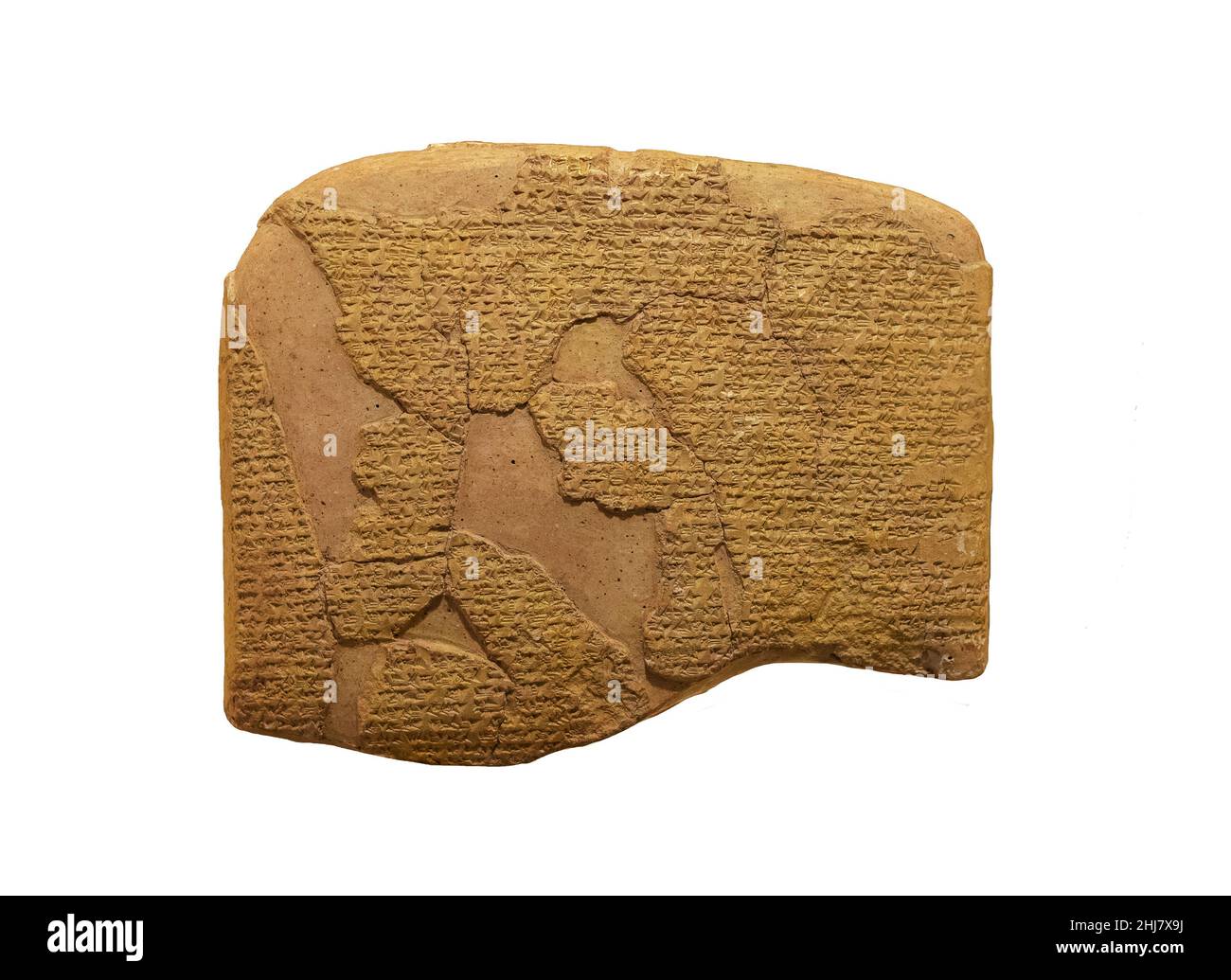 Ancient cuneiform tablet of Egyptian–Hittite peace treaty (Treaty of Kadesh) in Istanbul Archaeology Museum. 1300–1200 B.C. Stock Photohttps://www.alamy.com/image-license-details/?v=1https://www.alamy.com/ancient-cuneiform-tablet-of-egyptianhittite-peace-treaty-treaty-of-kadesh-in-istanbul-archaeology-museum-13001200-bc-image458707694.html
Ancient cuneiform tablet of Egyptian–Hittite peace treaty (Treaty of Kadesh) in Istanbul Archaeology Museum. 1300–1200 B.C. Stock Photohttps://www.alamy.com/image-license-details/?v=1https://www.alamy.com/ancient-cuneiform-tablet-of-egyptianhittite-peace-treaty-treaty-of-kadesh-in-istanbul-archaeology-museum-13001200-bc-image458707694.htmlRF2HJ7X9J–Ancient cuneiform tablet of Egyptian–Hittite peace treaty (Treaty of Kadesh) in Istanbul Archaeology Museum. 1300–1200 B.C.
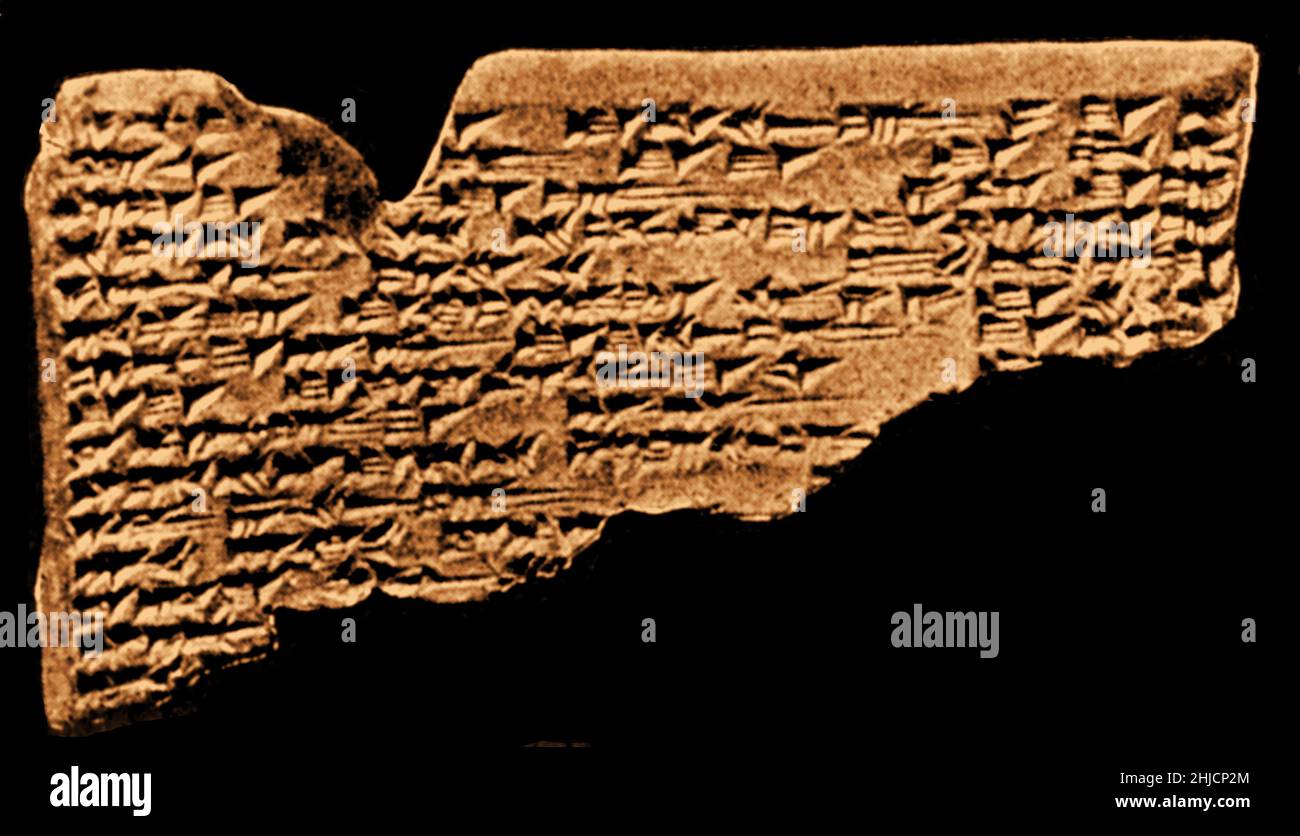 The Amarna tablets are an archive, written on clay tablets, primarily consisting of diplomatic correspondence between the Egyptian administration and its representatives in Canaan and Amurru during the New Kingdom. The Amarna letters are unusual in Egyptological research, because they are mostly written in Akkadian cuneiform, the writing system of ancient Mesopotamia, rather than that of ancient Egypt. Photo from The Story of the Alphabet by Edward Clodd, 1900. Colorized. Stock Photohttps://www.alamy.com/image-license-details/?v=1https://www.alamy.com/the-amarna-tablets-are-an-archive-written-on-clay-tablets-primarily-consisting-of-diplomatic-correspondence-between-the-egyptian-administration-and-its-representatives-in-canaan-and-amurru-during-the-new-kingdom-the-amarna-letters-are-unusual-in-egyptological-research-because-they-are-mostly-written-in-akkadian-cuneiform-the-writing-system-of-ancient-mesopotamia-rather-than-that-of-ancient-egypt-photo-from-the-story-of-the-alphabet-by-edward-clodd-1900-colorized-image458814124.html
The Amarna tablets are an archive, written on clay tablets, primarily consisting of diplomatic correspondence between the Egyptian administration and its representatives in Canaan and Amurru during the New Kingdom. The Amarna letters are unusual in Egyptological research, because they are mostly written in Akkadian cuneiform, the writing system of ancient Mesopotamia, rather than that of ancient Egypt. Photo from The Story of the Alphabet by Edward Clodd, 1900. Colorized. Stock Photohttps://www.alamy.com/image-license-details/?v=1https://www.alamy.com/the-amarna-tablets-are-an-archive-written-on-clay-tablets-primarily-consisting-of-diplomatic-correspondence-between-the-egyptian-administration-and-its-representatives-in-canaan-and-amurru-during-the-new-kingdom-the-amarna-letters-are-unusual-in-egyptological-research-because-they-are-mostly-written-in-akkadian-cuneiform-the-writing-system-of-ancient-mesopotamia-rather-than-that-of-ancient-egypt-photo-from-the-story-of-the-alphabet-by-edward-clodd-1900-colorized-image458814124.htmlRM2HJCP2M–The Amarna tablets are an archive, written on clay tablets, primarily consisting of diplomatic correspondence between the Egyptian administration and its representatives in Canaan and Amurru during the New Kingdom. The Amarna letters are unusual in Egyptological research, because they are mostly written in Akkadian cuneiform, the writing system of ancient Mesopotamia, rather than that of ancient Egypt. Photo from The Story of the Alphabet by Edward Clodd, 1900. Colorized.
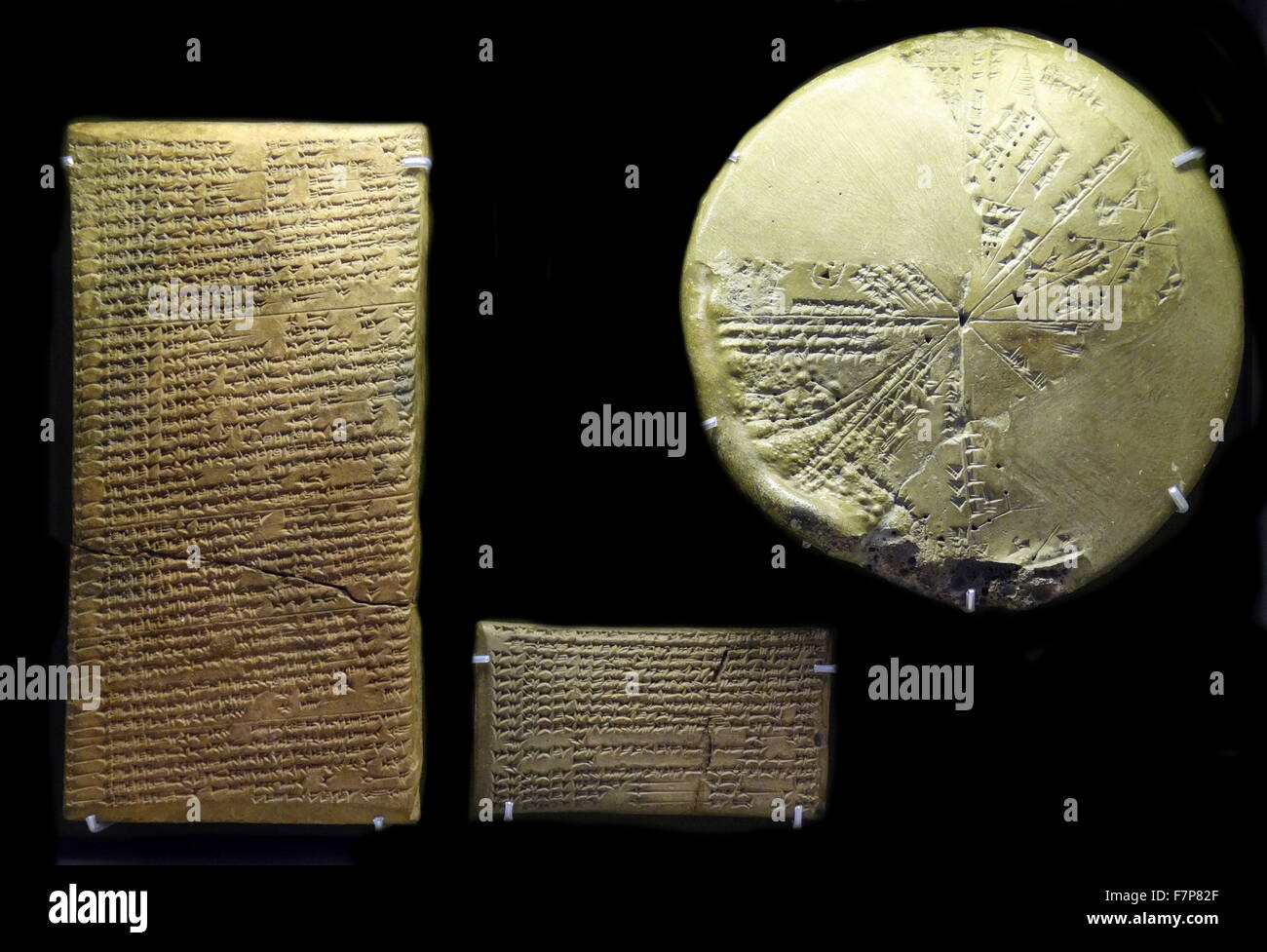 Cuneiform Assyrian tablets 2nd millennium BC, Iraq. Stock Photohttps://www.alamy.com/image-license-details/?v=1https://www.alamy.com/stock-photo-cuneiform-assyrian-tablets-2nd-millennium-bc-iraq-90843719.html
Cuneiform Assyrian tablets 2nd millennium BC, Iraq. Stock Photohttps://www.alamy.com/image-license-details/?v=1https://www.alamy.com/stock-photo-cuneiform-assyrian-tablets-2nd-millennium-bc-iraq-90843719.htmlRMF7P82F–Cuneiform Assyrian tablets 2nd millennium BC, Iraq.
 Tablets and tiles in the museum Museu Municipal de Lagos, Algarve, Portugal, Europe Stock Photohttps://www.alamy.com/image-license-details/?v=1https://www.alamy.com/stock-photo-tablets-and-tiles-in-the-museum-museu-municipal-de-lagos-algarve-portugal-34581481.html
Tablets and tiles in the museum Museu Municipal de Lagos, Algarve, Portugal, Europe Stock Photohttps://www.alamy.com/image-license-details/?v=1https://www.alamy.com/stock-photo-tablets-and-tiles-in-the-museum-museu-municipal-de-lagos-algarve-portugal-34581481.htmlRMC0790W–Tablets and tiles in the museum Museu Municipal de Lagos, Algarve, Portugal, Europe
 Vitamins and Medicine Tablets and Capsule on a Clay Plate with the Knead Tool Stock Photohttps://www.alamy.com/image-license-details/?v=1https://www.alamy.com/vitamins-and-medicine-tablets-and-capsule-on-a-clay-plate-with-the-knead-tool-image572977809.html
Vitamins and Medicine Tablets and Capsule on a Clay Plate with the Knead Tool Stock Photohttps://www.alamy.com/image-license-details/?v=1https://www.alamy.com/vitamins-and-medicine-tablets-and-capsule-on-a-clay-plate-with-the-knead-tool-image572977809.htmlRF2T85B15–Vitamins and Medicine Tablets and Capsule on a Clay Plate with the Knead Tool